PATH: HOME, GLOSSARY, WEBSITE INDEX, WEBSITE CONTENTS » ∨
∧ BOAT BUILDING & REPAIR » Boat Equipment » Propulsion Machinery » Engines »
∧ DO-IT-YOURSELF » DIY Boat Building & Repair, DIY Boat Inspections, DIY Schools & Classes »
∧ MEDIA w/Creator Directory » Product Documentation, Books, Magazines, Videos, Websites »
PAGE CONTENTS:
⇒ How to Identify Ford of Britain “Dagenham”, “Dorset” and “Dover” Diesel Engines:
⇒ ^ Background, Model Chart by Year, Basic Models, Marinizers, Fixes, Shops, etc.
⇒ ^ Ford’s Identification Plates & Build Data Plates.
⇒ ^ Capacity Codes.
⇒ ^ Serial Numbers.
⇒ ^ Part Numbers: Cast-in or Stamped.
⇒ ^ ^ Cylinder Blocks.
⇒ ^ ^ Intake Manifolds.
⇒ ^ ^ Valve Rocker Covers.
⇒ ^ ^ Cylinder Heads.
⇒ ^ Fuel Injection Pump Models.
⇒ ^ Distinct Features.
⇒ ^ ^ Fuel Injection Pump Cambox Lubrication.
⇒ ^ ^ Fuel Injection Pump Drives.
⇒ ^ ^ Timing Gears.
⇒ ^ ^ Timing Gear Covers.
⇒ ^ ^ Valve Rocker Covers: Painted/Chromed.
⇒ ^ ^ Cylinder Head Ports.
⇒ ^ ^ Cylinder Liner Types.
⇒ ^ ^ Cylinder Bores.
⇒ ^ Ford Cargo Lorry Engines by Lorry Series & Years of Production.
⇒ How to Identify Ford-Otosan “EcoTorq” 7.3L, 9.0L & 12.7L Diesel Engines:
⇒ How to Identify Ford New Holland “M” + “Brazilian” BSD Series Diesel Engines:
⇒ How to Identify Ford Case New Holland “Genesis” 5.0L & 7.5L Diesel Engines:
⇒ How to Identify Ford “Kent” Petrol Engines Dieselized by Watermota:
⇒ How to Identify Ford “York” Series 2400 & FSD Range Diesel Engines:
⇒ How to Identify Ford “LT” & “Lynx” ⇒ “Endura-D” Series XLD & DLD Range Diesel Engines:
⇒ How to Identify Ford ⇐ PSA (Peugeot) XD Series ⇐ Indenor XDP Range Diesel Engines:
⇒ How to Identify Ford ⇐ PSA (Peugeot-Citroën) XUD Range Diesel Engines:
⇒ How to Identify Ford “DuraTorq” Series ZSD & TDCi Range Diesel Engines:
⇒ Ford Diesel Engine Model Chart by Range & Year.
⇒ Product Documentation: Catalogs, Brochures, SpecSheets, Manuals, Parts Lists. Recalls,+.
⇒ Related Resources: EAB Topics w/Directories, Vendors, Products: Media: Books, Websites,+.
⇒ Visit EAB’s FEATURED ARTICLES Home Page to preview the vast scope of our website.
⇒ This Month’s Top 20 Most Popular Articles on our EAB website.
⇒ Layout of the EverythingAboutBoats.org Website’s Pages: Page Types, Contents, Topics,+.
⇒ What our nonprofit Anchors Aweigh Academy and its EAB website have accomplished.
⇒ Members must SIGN IN to gain access to Members Only areas of this website.
⇒ Become an Academy Member and gain access to additional pages and programs!
⇒ Comments: Submit To ⇒ Comments♥EverythingAboutBoats.org (Replace “♥” with “@”).
THIS ARTICLE IS STILL EVOLVING!
The page may contain rough drafts that include raw source materials.
How to Identify
Ford of Britain “Dagenham”, “Dorset” and “Dover” Diesel Engines
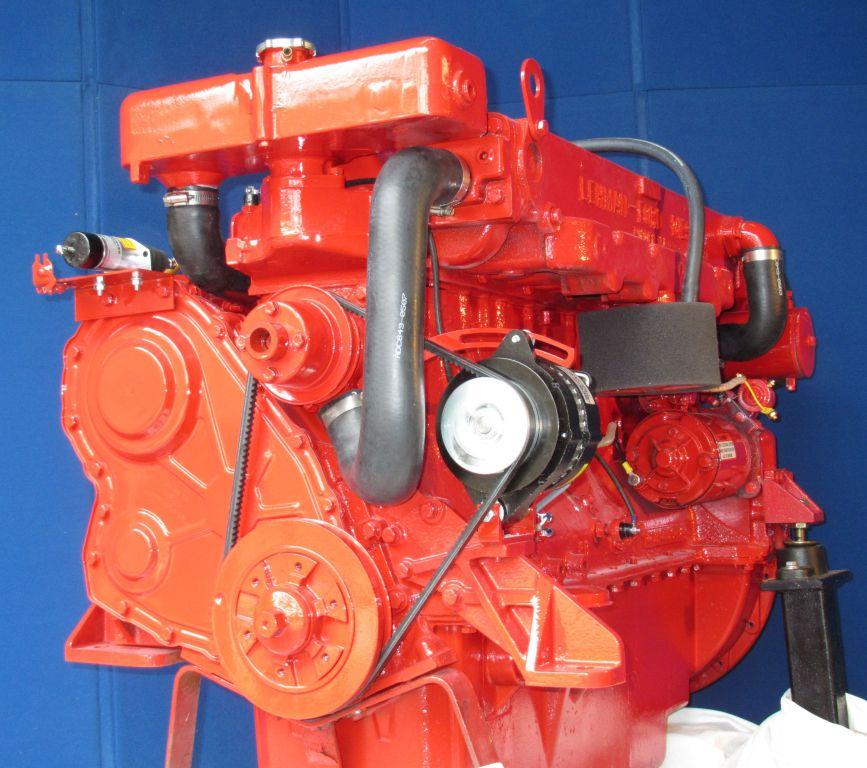 Lehman 120 6D380 (marinized Ford 2715E base engine).
Lehman 120 6D380 (marinized Ford 2715E base engine).
> > > FIRST, A LITTLE BACKGROUND < < <
In the early 1950’s, Ford decided to develop their own diesel engines for their line of Fordson tractors. Ford of Britain’s Dagenham Engine Plant was tasked with designing and producing the engine. The new “4D” (4-cylinder Diesel) engine was introduced with the new “E1A” Fordson Major tractor in 1952. Thus began a legacy that spanned over six decades of continuous production that saw the little 4-cylinder engine and it’s 6-cylinder bigger brother evolve and gain popularity around the globe as they were fitted to tractors, harvesters, grass dryers, lorries, rock crushers, electrical generators, work boats and pleasure craft, especially Asian trawlers. They proved to be robust and dependable. And when they did require repair, mechanics found them easy to work on as they were very much “Old School”. Parts were plentiful and reasonably priced due to their growing popularity and being backed by one of the largest engine manufacturers in the world. See our Ford Industrial Power Products Diesel Engines webpage for a more detailed history of the Ford of Britain Diesel Engines.
Unfortunately, when researching how to identify Ford engines, conflicting information is often found in the various the sources. For example: Tech Tip #92: Identifying the Ford Dover and Dorset Engines by Foley Engines states “One problem that often comes up is how to identify the Ford Dorset and Ford Dover engines. After all, these Ford industrial engines look similar. In fact, they are both made in England at the Ford Dagenham Plant outside of London,…” However, Foley Engine’s Tech Tip #142: Identifying the Dorset and the Dagenham Models then states “The Ford Dorset Engines were produced in Essex, UK… The Ford Dagenham Engine was made in Dagenham, UK.” So was the Ford Dorset produced in Essex, which is the county North of Dagenham, or in Dagenham which is a town on the River Thames just east of London? Some of this confusion may come from the fact that the Ford Basildon Tractor Plant was located in the county of Essex, and tractor engines were often finished there. Further research indicates that both the Dagenham and the Dover family of engines were built at the Ford Dagenham Engine Plant. The Ford Dover Engines were also made at the Ford Dagenham Engine Plant until production was incrementally moved to Ford-Otosan in Turkey between 1986 and 1994. All production of these venerable workhorses finally ceased in 2010 with stockpiles lasting several more years.
The chart below is a terrific reference as it presents the engine models and years produced. Click Here for more about this chart and how Academy Members can download the entire high resolution chart in PDF.

The 4-cylinder engines came in three basic flavors depending on application: Agricultural (e.g. tractors), Automotive (e.g. lorries), and Industrial (e.g. rock crushers, power generators, and marine propulsion). The tractor and AC generator engines were typically set up to run at low speed (1600 RPM for tractors, 1500 and 1800 RPM for 50 and 60 cycle generators respectively) which resulted in lower power ratings. The lorry engines ran at higher speed (2250∼2500 RPM), and the industrial and marine engines ran as high as 2700 RPM. The 6-cylinder engines were never intended or used for Agricultural applications by Ford. however the industrial versions were often pressed into agricultural service by other OEMs such as Country Tractors.
While the different applications demanded some differences between the engines, the basic design remained very much the same with many of the parts interchangeable throughout the years. This led to the common practice of repairing with parts that were similar, but were for a different model (even much newer or much older) and for a different application.
Often, when engines were badly damaged, complete engines were fitted that were a different model and sometimes intended for a different application. Replacement engines could be either new or used. Used engines could be near new and in very good condition or near the end of their service life. Used engines could be damaged and not repaired, poorly repaired or only partially repaired, or they could be fully repaired, or even completely overhauled. Never trust an hour meter and always get an engine survey to determine the actual condition of the engine.
Only brand new engines, “right off the assembly line” so to speak, were ever marinized in-house by the primary marinizers like Lehman or Mermaid, who purchased them directly from Ford Industrial Power Products. Some new engines were marinized by less prominent marinizers, some of which sometimes marinized used “Take-Out” engines. Some marinizers used only marinizing components they produced themselves and some marinizers used components produced by someone else or a combination of both. Some marinizers only ever marinized used engines. Private parties marinized new and/or used engines from whatever source they could and in whatever condition suited them, using whatever marinizing parts they had available. It was not unusual to find newly built vessels with used Ford engines fitted. It is not uncommon for such “Take-Out” engines to be mistaken for new engines until more deeply examined. It is also not unusual for Ford 6–cylinder diesel engines to be called Lehman 120’s just because they have a Lehman manifold or were painted red. Far to often these engines turn out to be a different model or a Ford model that Lehman never marinized. Some engines turn out to be used engines that unfortunately were marinized by inexperienced private parties, but using some Lehman parts. All this can compound the problem of identifying a particular engine.
In Twin engine applications, any mismatch between the engines can result in performance and longevity issues, some very serious, especially from carbonization (see Select the right diesel engine).
Ford’s Basic Model Numbers
For Ford of Britain “Dagenham”, “Dorset” and “Dover” Diesel Engines
All these diesel engines have the following features in common: Reciprocating Pistons with Connecting Rods and a Horizontal Crankshaft, Inline Cylinders, a Reverse Flow (Not a Crossflow) Head, Overhead Valves actuated by a low block fitted Camshaft through Flat-Tappet Mechanical Solid Lifters, Push Rods and Rocker Arms, a 115mm (4.524in) Piston Stroke, a Fully Pressurized Oil Lubrication System, Water Cooling, Internal Combustion, Compression Ignition, Mechanical Direct Injection, and of course fueled by Diesel. Co-developed engines fueled by Petrol (Gasoline), Vapor (Kerosene), and Gas (CNG), were also produced.
Most engines were available in an “inclined” version where the engine was tipped to the left side so that the cylinders were at about a 45° slant, about half way between vertical and horizontal so that the engine could fit limited height applications like cab-over lorries. Some inclined engines were assigned their own model numbers like the 2706E 2708E and 2709E.
Ford diesel engines are categorized by Family: “Dagenham”, “Dorset” and “Dover”. Then they are divided into Ranges: “D” Range, 2700 Range, 2710 Range, and 2720 Range. Within each Range they are further divided into Model Groups: 4D, 6D, 2701, 2703, 2704, 2711, 2712, 2715, 2722, 2723, 2725, etc. Each Model Group is represented by the individual model number depending on application. For example the 4D model group: E1A (Agricultural), 530E (Automotive), 592E (Industrial), etc. The industrial engines are sometimes further divided into: Off-Highway, Power Generation, Marine, etc. The table below tries to illustrate this breakdown, but this system was not always closely followed, as they were often influenced by marketing needs.
Ford never produced a marinized version of these engines, however, several marinizers and private parties did. It was the industrial versions of these engines (especially the marine rated base engines when produced) that were most often marinized by marinizers like Lehman, Mermaid, Parsons, Sabre, and Thorneycroft (see Primary Marinizers List below). However, private parties marinized anything and everything, especially used take-outs from tractors, combines, rock crushers, lorries, generators, etc. using marinizing “Kits” or individual marinizing parts supplied by the major marinizers such as Bowman, Lehman and Mermaid. Also keep in mind that replacement engines could be any model, “New” or “Used”, in any condition. This can cause considerable confusion when identifying these engines.
COMPONENT PART NUMBERS CAN BE MISLEADING
Many of an engine’s components are cast or stamped with a part number that may be similar to the engine’s model number such as shown on the engine block pictured directly below. But the raised “2702E” number cast-into this cylinder block is the prefix of this cylinder block’s RAW casting number and NOT this engine’s actual model number. This block was used in the production of another engine model, but not any engine with a 2702E model number.
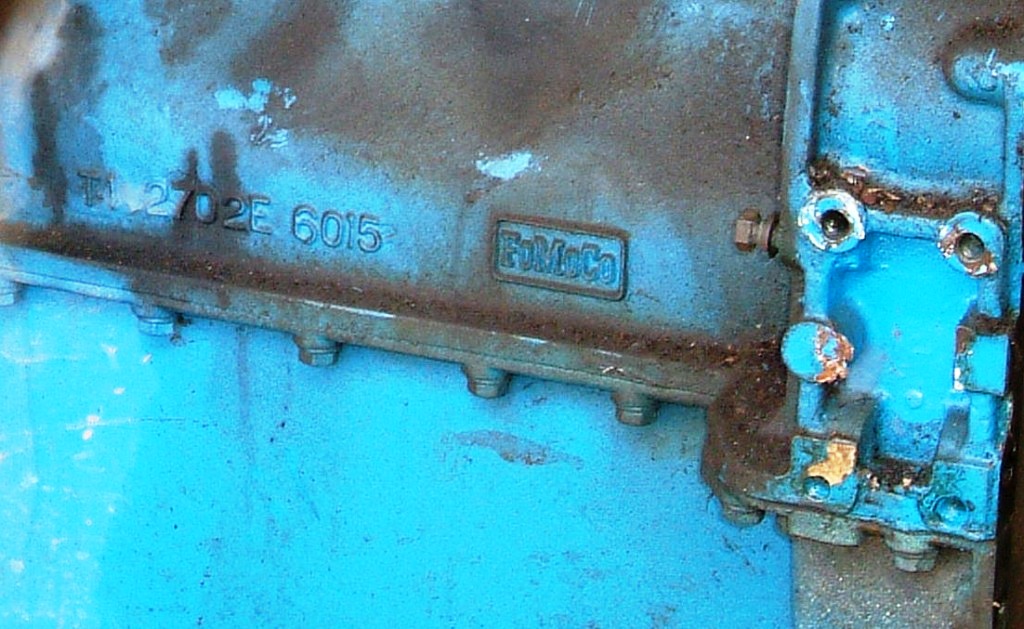
Ford 2703E Engine Block.
Do not be misled. See our next section and our later section on Part Numbers.

The “T1 2702E 6015” raw casting part number on a Ford 2703E engine’s cylinder block (enlarged view).
Ford’s Basic Model Numbers and Specific Model Numbers
TABLE KEY:
FAMILY/Range/Model = Base Engine “Family” / “Range” / “Model” (Application) {Marinized}.
CYL = Cylinder Quantity: 4-Cylinder or 6-Cylinder.
^ Cylinder Liner/Bore: W = “Wet”. D = “Dry”. P = Parent/Native Bore (Cast-in-Block).
BORE = Cylinder Bore Diameter: mm = Millimeters. in = Inches.
DISPLACEMENT = Swept Volume: cc = Cubic Centimeters. L = Litres/Liters. ci = Cubic Inches.
ASP = Aspiration: N= Naturally Aspirated. T = Turbocharged. Ti = Turbo w/Intercooler.
We will continue to update this information as it comes in.
| FAMILY/Range/MODEL | CYL | BORE | DISPLACEMENT | ASP |
| DAGENHAM: (1952-3/65+) | ||||
| ^ 4D | 4-W | 100mm / 3.94in | 3611cc / 3.6L / 220ci | N |
| ^ ^ E1A (Agricultural) | ||||
| ^ ^ ET? (Automotive) | ||||
| ^ ^ 954E (Ind.‚ Early) | ||||
| ^ ^ 562E (Ind.‚ Late) | ||||
| ^ 4D Mark-2 {Lehman 4D220} | 4-W | 100mm / 3.94in | 3611cc / 3.6L / 220ci | N |
| ^ ^ E1A (Agricultural) | ||||
| ^ ^ ET? (Automotive) | ||||
| ^ ^ 530E (Automotive) | ||||
| ^ ^ 592E (Industrial) | ||||
| ^ 6D Mark-2 {Lehman 4D330?} | 6-W | 100mm / 3.94in | 5416cc / 5.4L / 330ci | N |
| ^ ^ 510E (Automotive) | ||||
| ^ ^ 590E (Industrial) | ||||
| ^ ^ ^ C3PY† (Industrial) (See NOTES) | ||||
| ^ 6D Mark-2 Turbo {Lehman 4D330T} | 6-W | 100mm / 3.94in | 5416cc / 5.4L / 330ci | T |
| ^ ^ 510ET (Automotive) | ||||
| ^ ^ 590ET (Industrial) | ||||
| DORSET‚ Early: (3/65-11/69+) | ||||
| DRAFT: 2700E‚ 2700C‚ 2710E | ||||
| ^ Automotive | ||||
| ^ ^ 703F? | ||||
| ^ ^ 713F? | ||||
| ^ General Purpose | ||||
| ^ ^ 693F? | ||||
| ^ ^ 703F? | ||||
| ^ Class 'A' (Generators) | ||||
| ^ ^ 693F? | ||||
| ^ ^ 703F? | ||||
| ^ ^ 713F? | ||||
| ^ Combine Harvester | ||||
| ^ ^ 693F? | ||||
| ^ ^ 703F? | ||||
| ^ ^ 713F? | ||||
| ^ ^ 723F? | ||||
| ^ ^ 743F? | ||||
| ^ 2701E {Lehman 4D242} | 4-D | 105mm / 4.125in | 3.964L / 242ci | N |
| ^ ^ ???F (?) | ||||
| ^ 2702E* | 6-D | N | ||
| ^ ^ ???F (?) | ||||
| ^ 2703E {Lehman 4D330} | 6-D | 100mm / 3.937in | 5.146L / 330ci | N |
| ^ ^ ???F (?). | ||||
| ^ 2704E {Lehman 4D363} | 6-D | 105mm / 4.125in | 5.945L / 363ci | N |
| ^ ^ ???F (?) | ||||
| ^ 2704ET (Turbo) | 6-D | 105mm / 4.125in | 5.95L / 363ci | T |
| ^ ^ ???F (?) | ||||
| ^ ^ 693F? (Marine) {Lehman 150} |
||||
| ^ 2704ET Intercooled | 6-D | 105mm / 4.125in | 5.95L / 363ci | Ti |
| ^ ^ ???F (?) | ||||
| ^ ^ 693F? (Marine) {Lehman 180} |
||||
| ^ 2704ET Turbo Plus | 6-D | 105mm / 4.125in | 5.95L / 363ci | Ti |
| ^ ^ ???F (?) |
||||
| ^ ^ 713F? (Marine) {Lehman 250} | ||||
| ^ 2706E** | 4-D | 105mm / 4.125in | 3.964L / 242ci | N |
| ^ ^ ???F (?) | ||||
| ^ 2708E** | 6-D | 100mm / 3.937in | 5.146L / 330ci | N |
| ^ ^ ???F (?) | ||||
| ^ 2709E** | 6-D | 105mm / 4.125in | 5.945L / 363ci | N |
| ^ ^ ???F (?) | ||||
| DORSET‚ Transition: (11/69-10/70) | ||||
| ^ 2701C*** | 4-P | 107mm / 4.22in | 4.15L / 254ci | N |
| ^ ^ ???F (?) | ||||
| ^ 2703C*** | 6-P | 105mm / 4.12in | 5.95L / 363ci | N |
| ^ ^ ???F (?) | ||||
| ^ 2704C*** | 6-P | 107mm / 4.22in | 6.22L / 380ci | N |
| ^ ^ ???F (?) | ||||
| DORSET‚ Late: (10/70-1982) | ||||
| ^ 2711E {AmMarine 70} | 4-P | 107mm / 4.22in | 4.15L / 254ci | N |
| ^ ^ ???F. (?) | ||||
| ^ 2712E {Lehman 80} | 4-P | 107mm / 4.22in | 4.15L / 254ci | N |
| ^ ^ 743F. (?) | ||||
| ^ 2713E | 6-P | 105mm / 4.12in | 5.950L / 363ci | N |
| ^ ^ ???F (?) | ||||
| ^ 2714E {AmMarine 110} | 6-P | 107mm / 4.22in | 6.22L / 380ci | N |
| ^ ^ ???F (?) | ||||
| ^ 2715E {Lehman 120} | 6-P | 107mm / 4.22in | 6.22L / 380ci | N |
| ^ ^ ???F (?) | ||||
| DOVER: (1982-1991) | ||||
| ^ 2722 {Lehman 90} | 4-P | 107mm / 4.221in | 4.2L / 254ci | N |
| ^ ^ 626? (?) | ||||
| ^ ^ ESD-442 (Industrial) | ||||
| ^ 2723 | 6-P | 105mm / 4.125in | 5.9L / 362ci | N |
| ^ ^ ESD-659 (Industrial) | ||||
| ^ 2725 {Lehman 135} | 6-P | 107mm / 4.221in | 6.2L / 380ci | N |
| ^ ^ ???F? (?) | ||||
| ^ ^ ESD-662 (Industrial) | ||||
| ^ 2726T {Lehman 185} | 6-D | 105mm / 4.125in | 6.0L / 363ci | Ti |
| ^ ^ ???F? (?) | ||||
| ^ ^ ESD-660? (Industrial) | ||||
| ^ 2728T {Lehman 225} | 6-D | 105mm / 4.125in | 6.0L / 363ci | Ti |
| ^ ^ 627? (?) | ||||
| ^ ^ ESD-660T (Industrial) | ||||
| DOVERTECH: (1991-2000+) | ||||
| ^ 2725 {Lehman 135} | 6-P | 107mm / 4.221in | 6.2L / 380ci | N |
| ^ ^ E2744 (Automotive) | ||||
| ^ ^ 916T? (Industrial) | ||||
| ^ 2726T {Lehman 185} | 6-D | 105mm / 4.125in | 6.0L / 363ci | Ti |
| ^ ^ ? (Automotive) | ||||
| ^ ^ ? (Industrial) | ||||
| ^ 2728T {Lehman 225} | 6-D | 105mm / 4.125in | 6.0L / 363ci | Ti |
| ^ ^ ? (Automotive) | ||||
| ^ ^ ? (Industrial) | ||||
| ^ 2728TIM | 6-D | 105mm / 4.125in | 6.0L / 363ci | Ti |
NOTES: + Production and availability of some models continued years afterwards. Example 1: The production of the Dagenham 4D Mark-2 moved from Ford in Dagenham, UK to EBRO in Spain after 1965 and continued up until the late 1990’s. Example 2: The production of the Dagenham 6D Mark-2 Turbo Charged model continued at Dagenham up until July, 1990. Example 3: The production of the 2704ET continued at Dagenham until 1982. Example 4: The production of select Dover models moved to Ford-Otosan in Turkey and continued there after 1991 where they were soon labeled “DoverTech” models.
†Ford “C3PY” are Ford of Britain 590E industrial engines with US ID Plates (See ID Plates below)
*2702E was never put into production, however several major components including the cylinder blocks for the 2703E and 2704E model engines are identified with the 2702E prefix in their part numbers and raised cast-in “raw” casting numbers. See Ford 2702E for more details.
**2706E, 2708E and 2709E are inclined versions of 2701E. 2703E and 2704E respectively.
***2701C, 2703C and 2704C were produced for only one year 11/1969-10/1970 and were “parent bore” immediate forerunners of the 2711E. 2713E and 2714E engines respectively.
Primary Commercial Marinizers of British Ford Diesel Engines
(Including marinizing component and "Kit" suppliers)
Some marinizers marinized only "brand new" engines from Ford Power Products while others marinized only "used take-out" engines, while still others marinized both new and used engines. Most marinizing component suppliers made their components available to other commercial marinizers, repair shops and individual private parties who used them to marinize new and/or used engines or maintain/repair existing marinized engines.
Many Ford of Britain diesels began their service life as low RPM, agricultural workhorses driving tractors, harvesters and other farm equipment. Many more began their service life as high RPM automotive engines driving lorries and other vehicles. Others were marketed by Ford Industrial Power Products for industrial applications such as off-road and military vehicles, farm and forest equipment, pumps and power generation. Duty ratings ranged from continuous to intermittent and from 1250 to 2700 RPMs. Those that realized that these engines would be ideal for marine propulsion began cobbling together cooling systems and exhaust systems so they could be used in boats. Enterprises like Lehman, Bowman, Thorneycroft, and Mermaid quickly geared up to produce quality components, available Individually and in kits so that marinizers could adapt both brand new and used "take-out" engines. Many component producers became marinizers themselves. Lehman was one of several that started buying brand new Ford industrial base engines from Ford Industrial Power Products, marinizing them "in-house" and marketing them as complete, ready to install units. Most of the Ford diesel engine marinizing component producers and engine marinizers are listed below. If you know of any more that should be listed, please email us at: editor♥EverythingAboutBoats.com (Replace "♥" with "@")
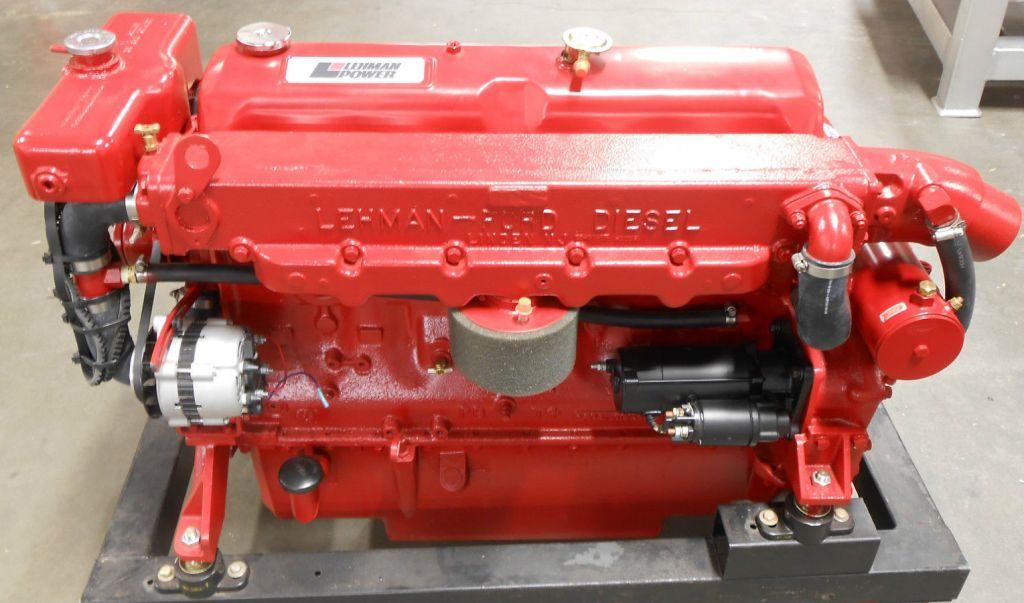 The very popular 6.22L Lehman 120 (6D380) using the Ford 2715E Base Engine.
The very popular 6.22L Lehman 120 (6D380) using the Ford 2715E Base Engine.
Unfortunately, many of the commercial marinizers and component suppliers (like Lehman) are no longer in business (those listed below in bold font are still in business and most still support the Ford engines). Fortunately, enterprises like American Diesel Corporation (listed below) still offer valuable information and quality replacement parts for these engines.
- Albacore Marine Engines (AU)
- American Diesel Corporation (Bob Smith*) (US).
- American Marine Ltd. (Mfr. of Grand Banks - Branded as AmMarine) (SG).
- Barr Marine (US).
- Beta Marine Ltd. (UK).
- Bomac Marine Power Corp. (US).
- Bowman Ltd. (UK)
- C-Power (Marine) Ltd. (UK).
- C/T Marine Ltd. (UK).
- Chingford Boat Centre (UK).-
- Couach (FR)
- Diesel Conversion Products (UK).-
- Diesel Power (UK).-
- DNT ().
- Econ-O-Power (Lehman's early branding).
- E. H. Hewitt and Co Ltd. (UK).-
- Fenwick Groupe (FR).
- Hawker Siddeley (Lister Petter) (UK).
- Highpower Marine Ltd. (UK).-
- J.G.M. Marine (UK).-
- Lancing Marine (UK).
- Lees Marine Group (NZ)
- Lehman Mfg Co. (US).
- Mermaid Marine Engines Ltd. (UK).
- M.I.T. Marine (UK).-
- Nils Gustavson (SE)
- Northeast Ford Engines Inc. (US).
- Parsons Mathway Marine (acquired by Coupland Bell Ltd. in 2013) (UK).
- Powermarine Engines Ltd. (UK).
- Renault Marine + Couach (FR).
- Sabb (UK).
- Sabre. (eg Ford-Sabre & Sabre-Lehman) (UK).
- Seapower ().
- Stratos (IT? & CZ?).
- T. Norris (Industries) Ltd. (UK).-
- Tempest ().
- Thornycroft Marine Engines (UK).
- Vetus (NL).
- Volvo Penta (SE & US).
- Watermota Ltd. (UK).
- Westerbeke Corp. (US).
- Wortham Blake and Co Ltd. (UK).
*In 1981, Bob Smith, who was the former managing director of Lehman Power, founded American Diesel Corporation in Kilmarnock, VA to provide aftermarket marinizing replacement parts and support for Lehman marinized Ford Industrial Power (UK) diesel engines. They also produced their own marinized replacement engine packages from the last of the Ford-Otosan 6.22L engines (similar to the Ford-Lehman Super 135). They were rated at 120, 125, 130, 136 and 140 horsepower. American Diesel Corp can supply most of the parts required to accomplish the "Fixes" that need to be accomplished to prevent engine damage. The americandieselcorp.com website has recently been updated with new features including Parts Lists, a Parts Order Form, and a Contact Form. Bob was well known for his Lehman Workshops. We are saddened to have to report that Bob has passed away. See Passagemaker's heartfelt and informative obituary. Bob's very capable and diesel-experienced son, Brian, will carry on the good work that would make his father proud.

The Late Bob Smith (right) presenting his Lehman Workshop at Trawlerfest in Anacortes, WA. in 2013.
Ford & Lehman "Fixes" that need to be accomplished before the engine suffers damage:
- Fix engine misfire before injection pump governor and internal engine damage results.
- Fix fuel injection pump lubricant before injection pump & governor damage results.
- Fix engine oil filter hoses and attachment before internal engine damage results.
- Fix engine oil cooler before cooler fails and engine damage results.
- Fix engine drive gears before gears fail and serious internal engine damage results.
- Fix "Two Shaft" raw water pump before shaft fails and engine overheat damage results.
- Fix Exhaust Elbow before engine overheating or hydrolocking results.
- Flush water jacket around rear-most cylinder and fit rear coolant fitting.
- Test and maintain engine coolant to prevent corrosion at wet liner cylinder seals.
- Fix coolant cap and flange, and fit coolant return tank to prevent scored piston.
- Fix coolant hoses before they fail and engine overheat damage results.
- Fix cause of premature engine drive belt failure before belt fails.
- Properly store spare drive belts in order to get home without a second failure.
- Fix substandard engine wiring before faults cause serious failures.
- Fix transmission fluid cooler before cooler fails and transmission damage results.
- Fix Velvet-Drive CR2 pinion nut before nut loosens and destroys transmission.
Notes: Many parts for these "Fixes" are available from American Diesel Corp's Website.
Repair Shops and Parts Suppliers
- American Diesel Corp: Ford Marinizer, Parts,+. (Kilmarnock, VA, USA)
- Bepco: Tractor Parts. (South Africa)
- Bomac: Ford Marinizer, Parts,+. (100 miles north of Atlanta, Georgia in Blairsville, Ga, USA)
- Emmark UK Ltd: Ford Tractor Engines Parts. (Pudsey, UK)
- Harbor Marine: Ford Repair, Parts,+. Velvet Drive Repair, Parts,+. (Everett, WA, USA)
- Lancing Marine: Ford Repair, Parts,+. (Portslade, Sussex, UK)
- Logan Diesel: Ford Repair, Parts,+. (14 miles north of Jackson, Michigan in Leslie, MI, USA)
- Mermaid Marine: Ford+ Engine Repair, Parts. (Coventry, UK)
- Timik Marine Engines: Ford+, Engine Repair, Overhaul, Repower,+. (Southampton, UK)
If you know of a vendor that should be added to this list, email the info/links To:
Editor♥EverythingAboutBoats.org (Replace "♥" with "@")
Ford’s Engine Identification Plates
Not all Ford diesel engines were initially fitted with engine identification plates. Agricultural and automotive engines lacked ID plates. Long blocks, short blocks, and complete replacement engines originally lacked ID plates. And Early Industrial engines lacked ID Plates. Those built in Britain and then shipped overseas to be sold by Ford Industrial Power Products were often fitted with ID plates by the various country’s Ford Industrial Power Products branches as in the case of the US ID plates shown directly below.
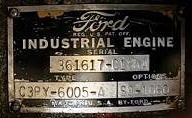
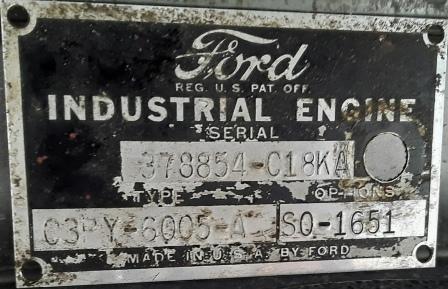
The plates above identify the engines as “TYPE C3PY – …”. Note that this number does not conform to Ford of Britain’s model numbering system. However, It does follow Ford’s US model numbering system and was used to identify imported Ford of Britain’s 6D Mark-2 (330ci) “Dagenham” 6-cylinder 590E industrial diesel engines. The “Serial” numbers shown on the plates are NOT the Ford of Britain industrial engine serial numbers which would begin with the letter “S” and would be stamped into the cylinder block casting on a machined pad described below under “Serial Numbers“. These engines were imported into the US and sold to OEM’s to power pumps. generators, vehicles, and construction, farm & forest equipment. These engines were also marinized for boat propulsion and marine generators. Don’t be confused by the bottom line on the plate that says “MADE IN U.S.A. …”. For many years, it has been common practice to accomplish the final assembly of a product in the destination country (in this case, the US) using imported components (in this case from Britain) in order to reduce import duties. In some cases, “final assembly” has consisted of just the “final coat of paint”.
A newer Ford of Britain’s Industrial Power Products identification plate appears below.
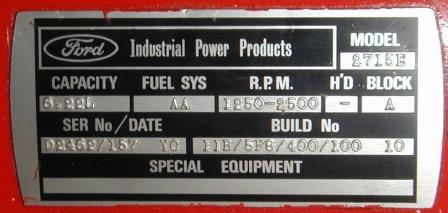
The engine identification plate above identifies this particular engine as a 6-cylinder Ford model 2715E, which was the 6.22L (380ci) “Dorset” base engine marinized into the popular Lehman 120. This engine was rated at a Maximum 120 horsepower in “Overload” at 2500 RPM. See Ford Duty Ratings for the explanation of the “Overload” rating. Like most of Ford’s tractor and truck diesel engines, this model was produced at Ford’s Dagenham Plant in Britain. See the Ford Industrial Power Products Diesel Engines Model Chart by Years above for the years and locations where the various Ford models were produced.
The Engine Identification Plate below identifies this particular engine as a 4-cylinder Ford model 2712E, which was the 4.15L (254ci) “Dorset” base engine marinized into the popular Lehman 80. This engine was rated at a Maximum 80 horsepower in “Overload” at 2500 RPM. See Ford Duty Ratings for the explanation of the “Overload” rating.
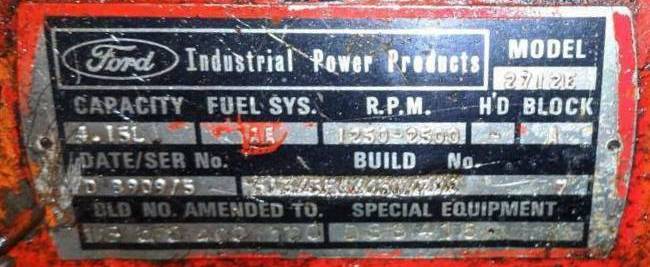
The Engine Identification Plate below identifies this particular engine as a Ford model 2712E that was originally set-up to drive a 60-cycle alternating current generator at 1800 RPM and could produce a continuous 59 horsepower (according to Mermaid specs). These slow revving engines have been found marinized and fitted as vessel propulsion engines, which has proven acceptable provided they are fitted with the right gearing and propeller for the application and NOT teamed up with a higher revving engine in a vessel with multiple engines such as twins.
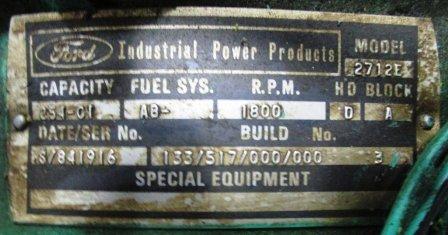
The Engine Identification Plate below identifies this particular engine as a Ford model 2712E that was originally set-up to drive a 50-cycle alternating current generator at 1500 RPM and could produce a continuous 50 horsepower (according to Mermaid specs).

The Engine Identification Plate below identifies this particular engine as a Ford model 2725E, which was the 6.22L (380ci) “Dover” base engine marinized into the Lehman SD120 “Standard 120” and the popular SP135 “Super 135”. Note that Ford shows an ending “E” (like their earlier models) on their “Dover” engine ID plates even though Ford’s documentation does not.
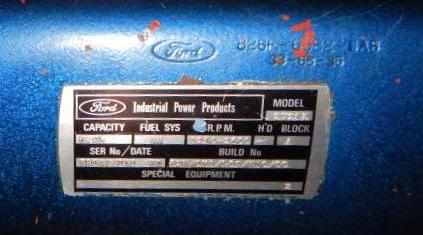
Ford 2725E Identification Plate
In cases when the engine’s original Identification Plate has come loose and been lost or it has intentionally been removed leaving no quick way to identify the engine, the engine can still be identified by another means described later in this article. In cases where the original engine’s ID plate has been switched to the replacement engine, misidentifying it, confirming the replacement engine’s true identity is always the wisest action. NOTE: It is never wise to depend entirely on the ID plate to identify an engine unless the engine’s complete history is known. Ways of confirming the engine’s ID are presented later in this article. Mis-identifying an engine can become a serious problem when it comes time to work on the engine.
Foley Engines’ Tech Tip #197 describes how the double alpha engine code translates to the year of production according to the following chart.
| LETTER | NUMBER | |||||||||||
|---|---|---|---|---|---|---|---|---|---|---|---|---|
| M | = | 0 | ||||||||||
| G | = | 1 | ||||||||||
| B | = | 2 | ||||||||||
| L | = | 3 | ||||||||||
| A | = | 4 | ||||||||||
| C | = | 5 | ||||||||||
| K | = | 6 | ||||||||||
| H | = | 7 | ||||||||||
| T | = | 8 | ||||||||||
| R | = | 9 |
For example, the code “RR” would translate into an engine year of 1999. However, this Tech Tip may not apply to all model years, possibly just later engines (1980’s & 1990’s). The code pictured on the plate above does not seem to translate properly. Be aware that the stamped digits in the “SER No / DATE” box like those pictured on the plate above may not always represent the engine’s actual serial number and year produced. More about this later.
Engine Identification Plates were typically located either just below and aft of the fuel filters on the upper right edge of the flywheel housing (early engines) or on the rocker cover (later engines). These plate locations are illustrated further down this page. Like many of these plates, the plates shown above were found attached to the valve rocker cover with adhesive.
The Operator’s Manual and Service Manual pages shown below explain
Ford’s Service Identification Plate and Engine Build Data Plate formats.

Pages 5 (above) thru 7 (below) of Ford’s 2720 “Dover” Range Operator Handbook.
A high resolution PDF of this manual is viewable by Academy Members.
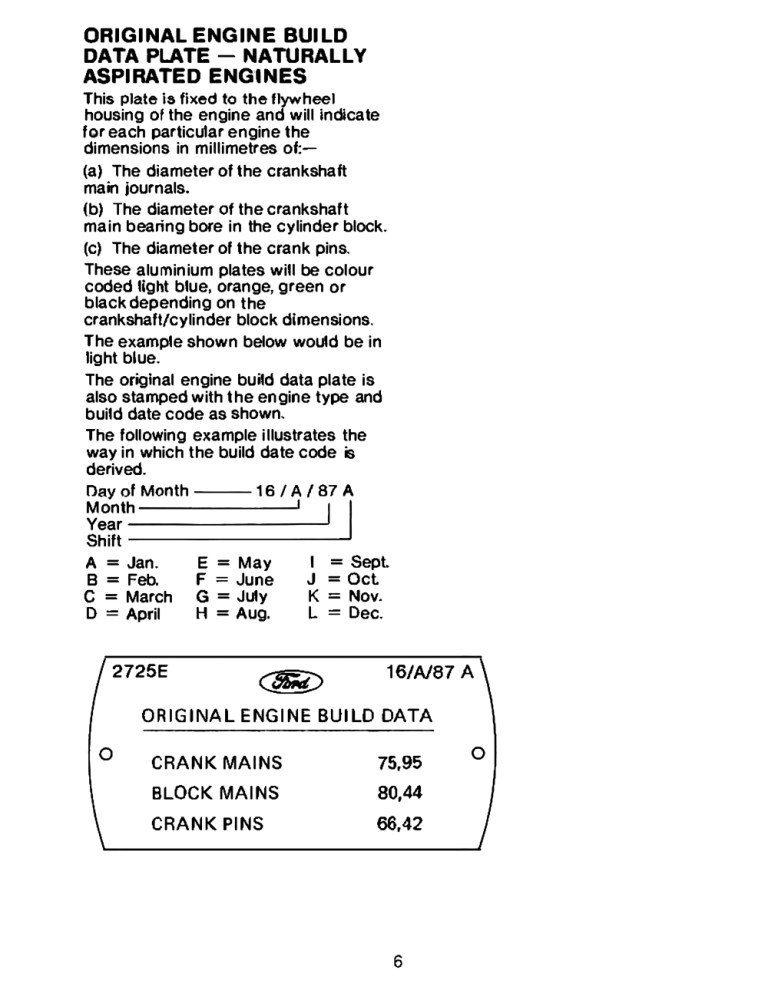
Note that the Original Engine Build Data Plate on the earlier Ford 2700 Range “Dorset” engines may not show the engine model number and production date like shown above.
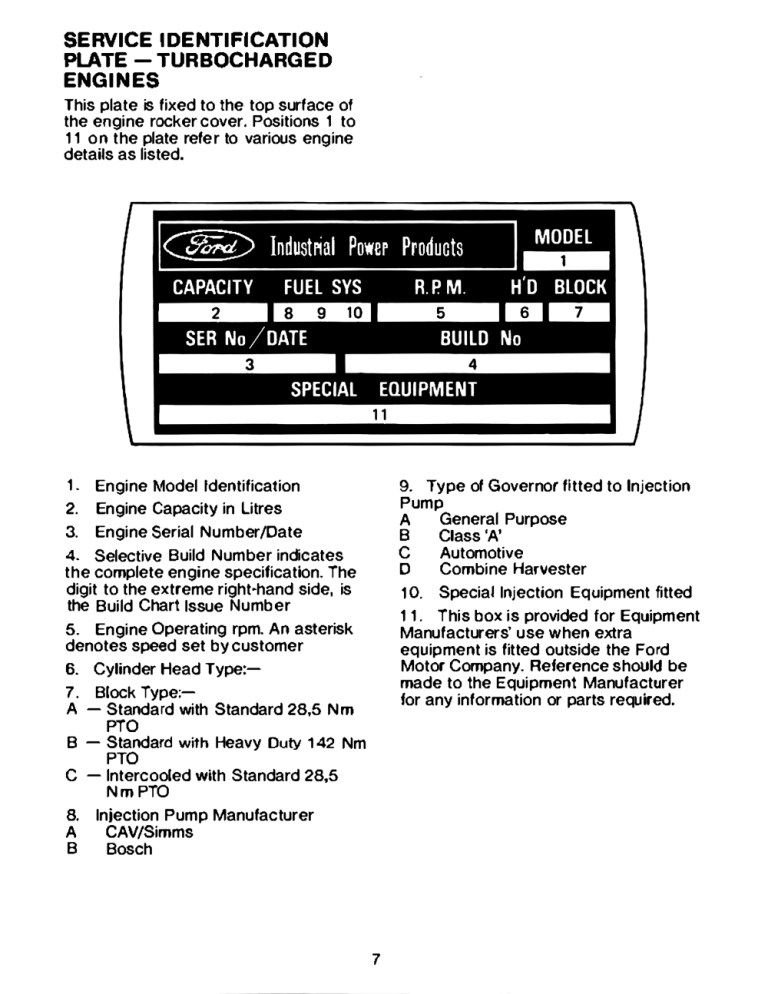
Pages 1-02 & 1-03 of Ford’s 2720 “Dover” ESD Range Service Manual.
A high resolution PDF of this manual is viewable by Academy Members.
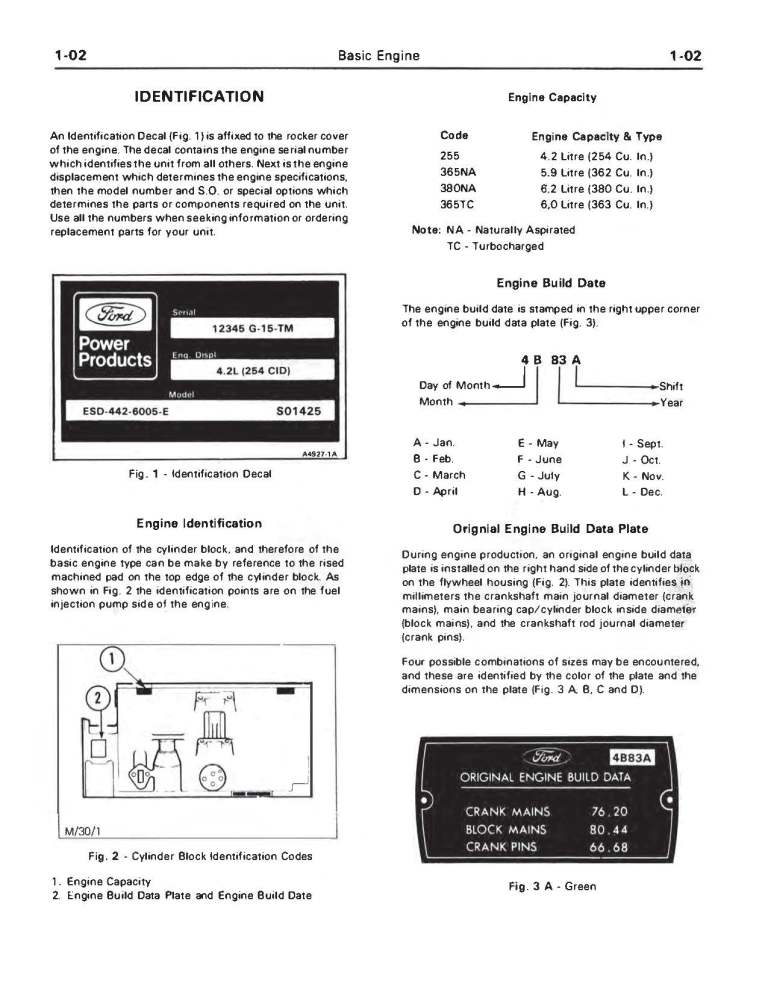
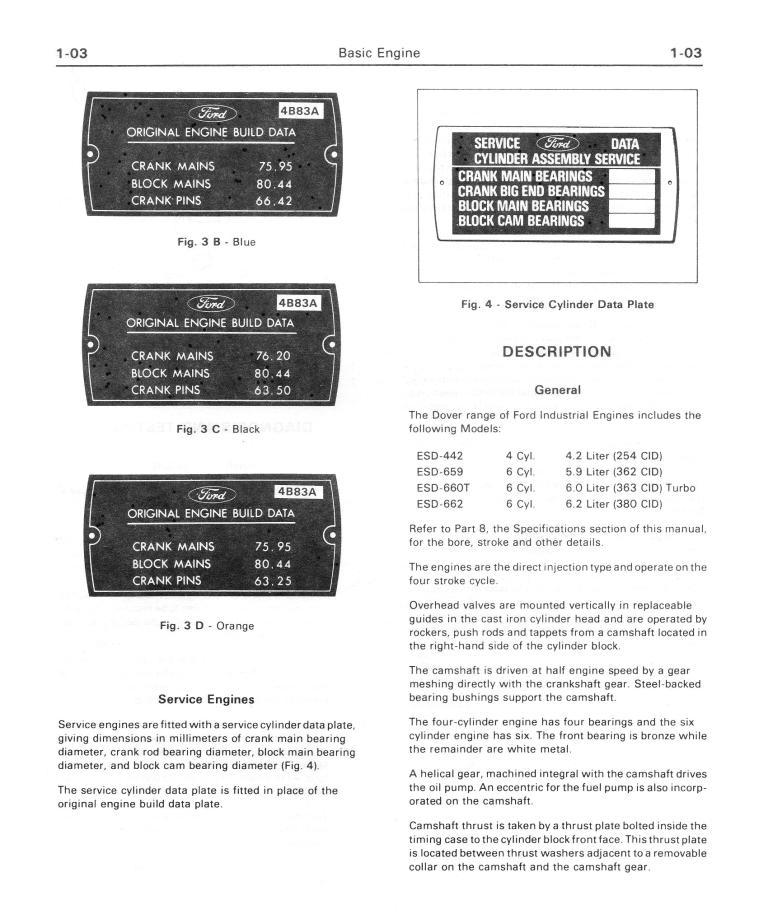
The engine’s Identification Plate should be used whenever it is available to identify the engine’s true model number, assuming that the plate has not been switched from another engine. If the plate was attached to the valve rocker cover and the cover was switched with another, then probably so was the plate.
The engine’s Build Data Plate can be helpful if it has been embossed or stamped with the model number like the Ford 2728T Plate shown below, especially when it also shows the Production Date. The Build Data Plate is usually riveted to the top-right side of the engine block’s flywheel housing.
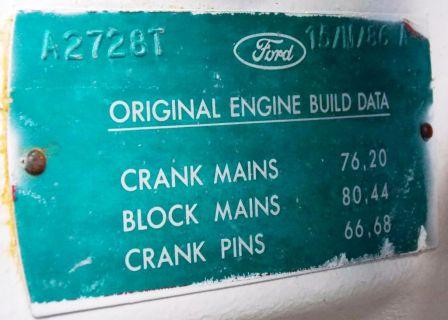
The much later Ford-Otosan Build Data Plate shown below has been stamped with “E2744” which is this automotive engine’s Ford-Otosan DoverTech Model Number.
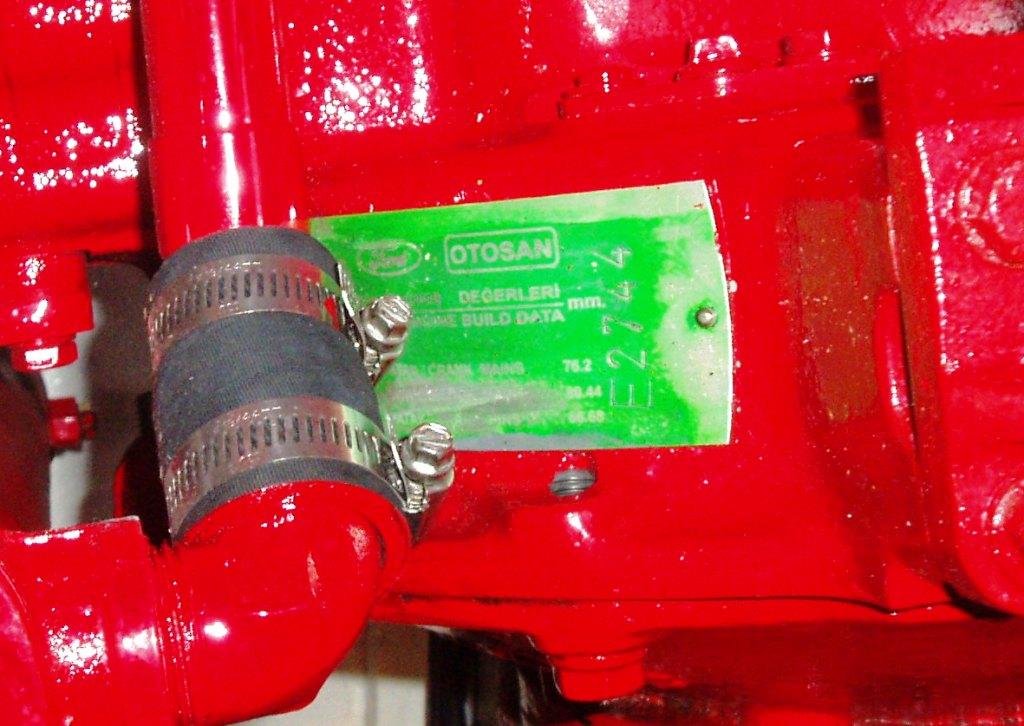 Ford-Otosan E2744 Build Data Plate.
Ford-Otosan E2744 Build Data Plate.
A replacement engine’s ID plate may be blank initially with the data later stamped or engraved into the plate (as shown below). Note that in this case the serial number begins with the engine’s model number as was common with the automotive versions of these engines.
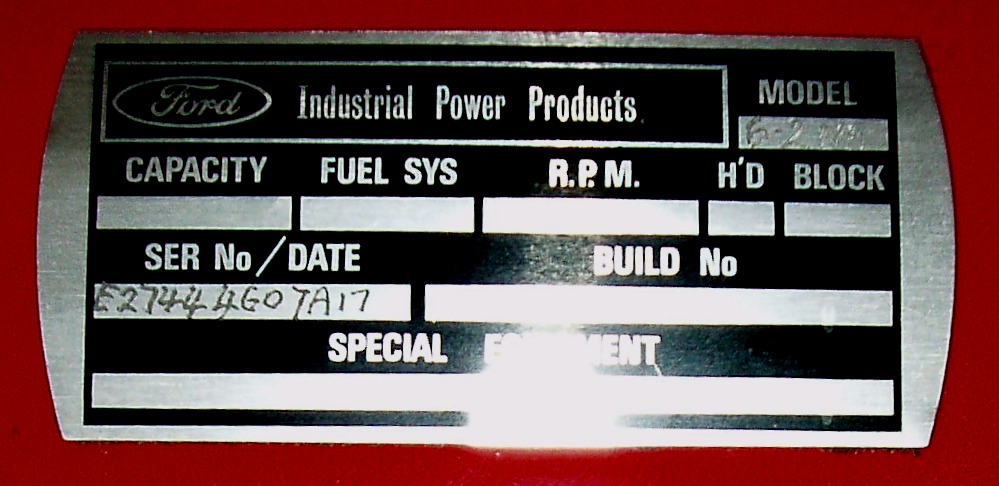 Ford E2744 Replacement Engine ID Plate.
Ford E2744 Replacement Engine ID Plate.
When an engine’s ID Plate is missing or in question, comparing the various code numbers found on an engine with the code numbers found in our charts below and/or in the parts catalogs can be helpful in identifying an engine, but be aware that parts are sometimes superseded later and may have different part numbers then called for in the parts lists. Also keep in mind that some engines have been repaired using mismatched parts from different engines. This can create difficulty identifying an engine. But worse, it can also cause performance and longevity problems, especially if injectors or injection pumps are mismatched.
Engine Capacity Code
 “62” Capacity Code stamped on Ford 2715E 6.2 Litre Engine Block.
“62” Capacity Code stamped on Ford 2715E 6.2 Litre Engine Block.
Ford stamps the Engine Capacity Code unto the engine’s cylinder block during production. These codes can be difficult to read, especially when covered by paint or rust. Steel wool helps. The machined pad for the code is located on the right side of the block towards the aft end by the fuel filters, up near the cylinder head as illustrated by the number 1 in Fig.2 on page 1-02 of Ford’s 2720 “Dover” ESD Range Service Manual shown above. All Ford diesel engine models display the code in the same place. The location of the Capacity Code is illustrated again on the Lehman manual page shown below in the “Ford’s Engine Serial Numbers” section. The code represents the engine’s total capacity of swept volume in either Cubic Inches of Displacement (CID) or Litres of Displacement (LD) depending on the engine model and cylinder block.
The Capacity Code alone cannot always identify an engine. For example, the Ford 6D and the Ford 2703E may show the same “330” code as both models have 330 cubic inches of capacity, but they are entirely different engines with no major components interchangeable.
The table below presents in bold font, the Capacity Code stamped on the engine block in the first column (labeled “CID“) or the second column (labeled “LD“). If the data presented in the first or second column is in small italics, then it represents the actual displacement for general reference only, and NOT the Capacity Code. The table is arranged in ascending displacement. The third column (Labeled “CYL“) shows the number of cylinders and presents the Cylinder Liner type: “W” for “Wet” liner, “D” for “Dry” Liner, and “P” for “Parent bore”. The corresponding engine models are then listed. This information can help narrow down the engine model. Click on the engine model link to go to our webpage for that particular model.
We will continue to update this information as it comes in.
| CID | LD | CYL | DAGENHAM | DORSET | DOVER |
|---|---|---|---|---|---|
| 220 | 3.6 | 4-W | 4D (E1A‚ ET‚ 562E‚ 954E) | ||
| ^ | ^ | ^ | 4D Mark-2 (E1A?‚ 530E‚ 592E) | ||
| ^ | ^ | ^ | EBRO 4D Mark-2 (E1A?‚ 592E) | ||
| 240 | 4.0 | 4-D | 2701E‚ 2706E | ||
| 254? | 42? | 4-P | 2701C‚ 2711E‚ 2712E | ||
| 255- | 4.2 | 4-P | 2722 | ||
| 330 | 5.4 | 6-W | 6D Mark-2 (510E‚ 590E‚ 590ET) | ||
| 330? | 5.4 | 6-D | 2703E‚ 2708E | ||
| 360 | 5.9 | 6-D | 2704E‚ 2709E | ||
| 363? 5? | 59? | 6-P | 2703C‚ 2713E‚ | ||
| 363? 5? | 60? | 6-D | 2704ET | ||
| 365NA- | 59? | 6-P | 2723 | ||
| 360T. | 6.0 | 6-D | 2726T‚ 2728T. | ||
| 365TC- | 6.0 | 6-D | 2726T‚ 2728T | ||
| 380. | 62. | 6-P | 2704C‚ 2714E.‚ 2715E. | ||
| 380NA- | 6.22 | 6-P | 2725 | ||
Notes: Petrol models will display capacities related to the petrol models which are usually slightly smaller then their diesel cousins. This can be confusing if a petrol block has been used to rebuild a diesel engine or vice versa. Table under development. We will add information as it comes in. If you can help, email To: Editor♥EverythingAboutBoats.org (Replace “♥” with “@”)
A “360T” Capacity Code is shown below stamped on a Ford 2728T Block. The code can be difficult to read when covered by paint. If needed, scrape off the paint and rub with steel wool. Be sure to repaint to prevent rust. Note that the head on this turbocharged engine was left unpainted when it was recently replaced. The need for head replacement on these high output engines is not uncommon as a small issue like injector misfire can become a big expansive problem very quickly.
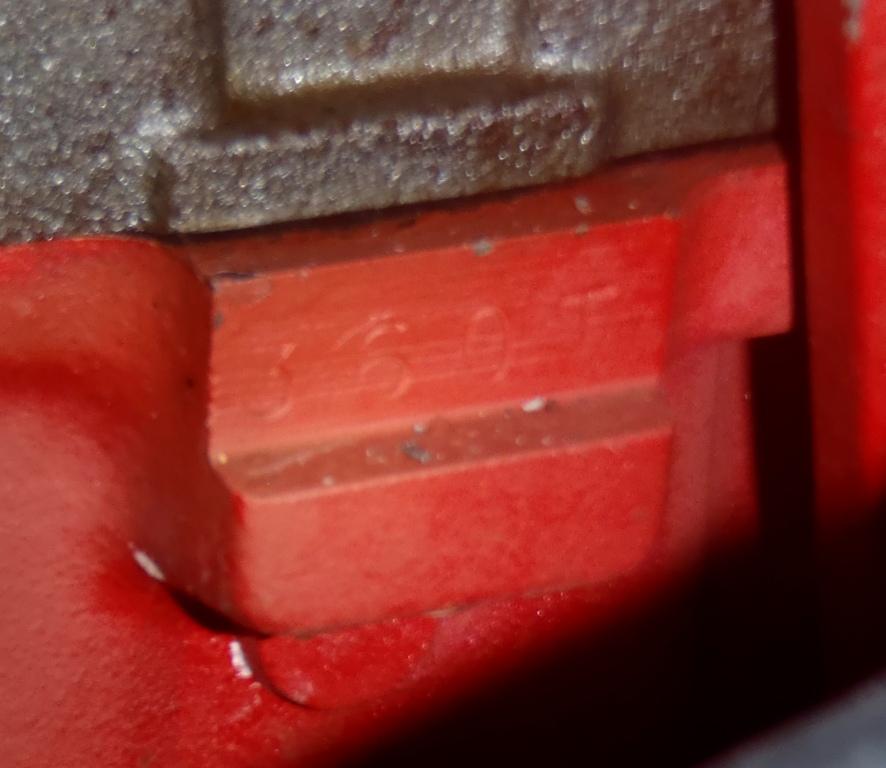 Ford 2728T Capacity Code “360T” (“T” is for “Turbocharged”).
Ford 2728T Capacity Code “360T” (“T” is for “Turbocharged”).
Ford’s Engine Serial Numbers
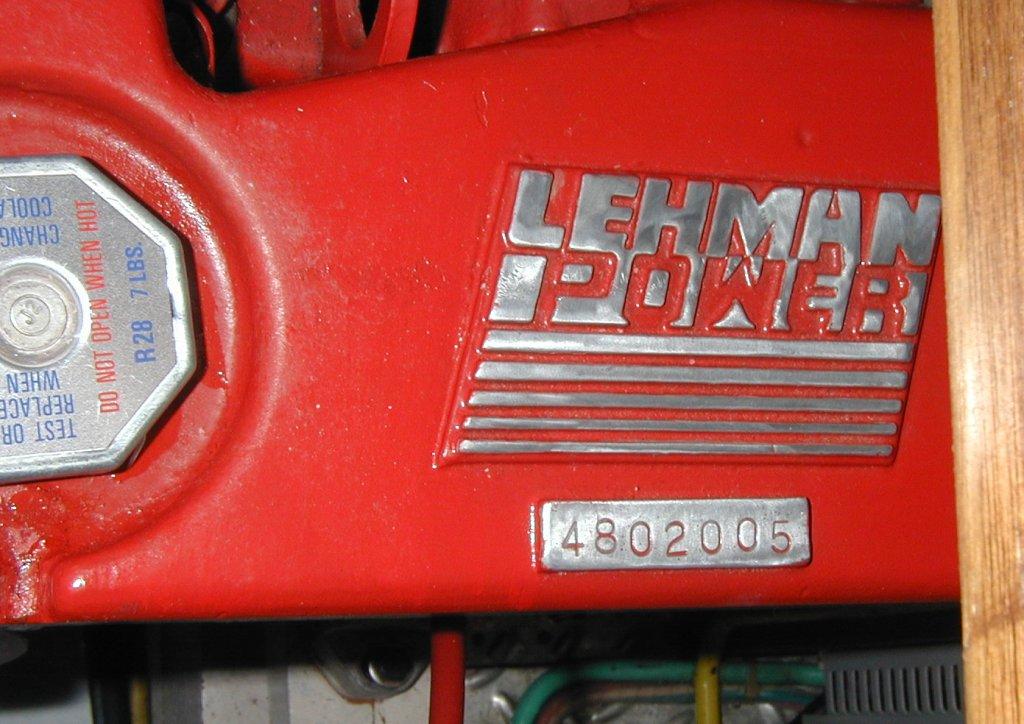 Lehman SP135 with Lehman Serial Number Stamped on the Coolant Reservoir.
Lehman SP135 with Lehman Serial Number Stamped on the Coolant Reservoir.
Lehman’s Serial Number is NOT Ford’s Engine Serial Number!
On Lehman marinized Ford diesel engines, the Lehman Serial Number can be found stamped into the coolant reservoir (as shown above), and into the exhaust manifold as illustrated on the Lehman Operators Manual page shown below. The two numbers should match unless these parts have been replaced. It is customary to stamp the Lehman serial number on any new replacement parts when they are installed, however this is not always done. If the replacement part is a used one from another engine rather then a new one, the serial number may be the serial number from the other Lehman engine. This stamped serial number is of course NOT the Ford serial number for the engine. The actual Ford serial number is stamped into the cylinder block casting on a machined “PAD” located on the right side of the engine near the front of the engine (behind the fuel injection pump on “Dorset” and “Dover engines”), just below the seam between the cylinder head and the cylinder block as pictured directly below and illustrated on page 7 of the Lehman Marine Diesel Engine Operators Manual #4C61J (see below along right side of illustration where it is labeled with “Ford Stamping”). All Ford of Britain engine serial numbers are stamped in this same location. On the Lehman marinized Ford “Dorset” engines, this “PAD” may be partially hidden behind the coolant pipe leading from the bottom of the coolant reservoir. Ford Industrial engine serial numbers usually begin with an “S” as shown in the picture directly below and in the Ford Serial Number Lists further below.
 Ford Serial Number “S537847” Stamped on “Dagenham” 6D Industrial Engine Block.
Ford Serial Number “S537847” Stamped on “Dagenham” 6D Industrial Engine Block.
Ford Automotive Engine Serial Numbers may begin with the automotive engine’s model number as shown below.
ΞPIXΞ
PIX of Ford Automotive Engine Serial Numbers that began with Engine Model Number.
(If you have an example, please send the image attached to an email
To: Editor♥EverythingAboutBoats.org (Replace “♥” with “@”). Thank you)
Page 7 of the Lehman Marine Diesel Engine Operators Manual #4C61J.
The number embossed on the Ford Industrial Power Products ID plate in the “DATE SER No.” box as shown on the bottom left of the above manual page is NOT the actual Ford Date of Manufacture or Serial Number as stated after item “3 – (Not Applicable)” above under the contents of the Identification plate. The Ford serial number is stamped on a machined “Pad” on the cylinder block as discussed before and begins with the letter “S” in the case of the industrial engines. Automotive engines had other prefixes that were derived from the engine’s model number. The following tables show Ford’s starting serial number for each month of production.
We will continue to update this information as it comes in.
Ford Serial Number Lists
With Dates of Manufacture
Ford Industrial Engine Serial Numbers (FORDSON “Dagenham” TYPE)
589E 6-cyl petrol, 590E 6-cyl Diesel, 591E 4-cyl Petrol, 592E 4-cyl Diesel, see the later list for serial numbers after 1967 as the 592E model was still available from EBRO with Industrial “S” serial numbers up until 1974.
| Date | Serial No | | | Date | Serial No | | | Date | Serial No |
|---|---|---|---|---|---|---|---|
| Jan-57 | S??????? | | | Sep-60 | S202905 | | | May-64 | S382700 |
| Feb-57 | S??????? | | | Oct-60 | S206901 | | | Jun-64 | S390839 |
| Mar-57 | S??????? | | | Nov-60 | S210942 | | | Jul-64 | S394937 |
| Apr-57 | S??????? | | | Dec-60 | S214742 | | | Aug-64 | S394956 |
| May-57 | S??????? | | | Jan-61 | S217975 | | | Sep-64 | S400673 |
| Jun-57 | S??????? | | | Feb-61 | S221604 | | | Oct-64 | S406675 |
| Jul-57 | S??????? | | | Mar-61 | S225057 | | | Nov-64 | S418756 |
| Aug-57 | S??????? | | | Apr-61 | S227978 | | | Dec-64 | S422678 |
| Sep-57 | S??????? | | | May-61 | S231414 | | | Jan-65 | S440281 |
| Oct-57 | S??????? | | | Jun-61 | S236082 | | | Feb-65 | S445910 |
| Nov-57 | S??????? | | | Jul-61 | S237874 | | | Mar-65 | S451298 |
| Dec-57 | S??????? | | | Aug-61 | S238903 | | | Apr-65 | S457000 |
| Jan-58 | S??????? | | | Sep-61 | S242359 | | | May-65 | S463428 |
| Feb-58 | S??????? | | | Oct-61 | S244400 | | | Jun-65 | S469622 |
| Mar-58 | S??????? | | | Nov-61 | S249731 | | | Jul-65 | S482814 |
| Apr-58 | S??????? | | | Dec-61 | S255104 | | | Aug-65 | S484589 |
| May-58 | S??????? | | | Jan-62 | S257192 | | | Sep-65 | S487681 |
| Jun-58 | S??????? | | | Feb-62 | S259489 | | | Oct-65 | S498509 |
| Jul-58 | S??????? | | | Mar-62 | S262626 | | | Nov-65 | S502046 |
| Aug-58 | S??????? | | | Apr-62 | S268839 | | | Dec-65 | S510728 |
| Sep-58 | S??????? | | | May-62 | S272344 | | | Jan-66 | S513700 |
| Oct-58 | S??????? | | | Jun-62 | S275066 | | | Feb-66 | S523258 |
| Nov-58 | S??????? | | | Jul-62 | S279924 | | | Mar-66 | S531279 |
| Dec-58 | S??????? | | | Aug-62 | S282285 | | | Apr-66 | S535394 |
| Jan-59 | S??????? | | | Sep-62 | S289685 | | | May-66 | S539792 |
| Feb-59 | S??????? | | | Oct-62 | S293014 | | | Jun-66 | S542772 |
| Mar-59 | S152148 | | | Nov-62 | S295456 | | | Jul-66 | S547427 |
| Apr-59 | S154346 | | | Dec-62 | S299492 | | | Aug-66 | S553502 |
| May-59 | S156723 | | | Jan-63 | S302340 | | | Sep-66 | S559860 |
| Jun-59 | S158770 | | | Feb-63 | S306878 | | | Oct-66 | S570998 |
| Jul-59 | S160725 | | | Mar-63 | S310092 | | | Nov-66 | S577774 |
| Aug-59 | S162216 | | | Apr-63 | S313698 | | | Dec-66 | S584206 |
| Sep-59 | S163319 | | | May-63 | S319286 | | | Jan-67 | S592917 |
| Oct-59 | S165585 | | | Jun-63 | S327953 | | | Feb-67 | S601371 |
| Nov-59 | S169826 | | | Jul-63 | S334757 | | | Mar-67 | S605856 |
| Dec-59 | S173638 | | | Aug-63 | S336412 | | | Apr-67 | S607484 |
| Jan-60 | S178862 | | | Sep-63 | S341829 | | | May-67 | S612949 |
| Feb-60 | S180946 | | | Oct-63 | S343696 | | | Jun-67 | S616139 |
| Mar-60 | S184210 | | | Nov-63 | S355712 | | | ||
| Apr-60 | S186928 | | | Dec-63 | S359567 | | | ||
| May-60 | S189906 | | | Jan-64 | S362864 | | | ||
| Jun-60 | S194532 | | | Feb-64 | S365837 | | | ||
| Jul-60 | S198584 | | | Mar-64 | S369385 | | |
FORD THAMES TRADER “Automotive” ENGINE SERIAL NUMBERS.
528E 4-CYL PETROL, 530E 4-CYL DIESEL, 508E 6-CYL PETROL, 510E 6-CYL DIESEL
DATE 15TH OF MONTH
| DATE | 4-Cyl | 6-Cyl | | | DATE | 4-Cyl | 6-Cyl |
|---|---|---|---|---|---|---|
| Jan-57 | ????? | ????? | | | Apr-60 | 17522 | 46167 |
| Feb-57 | ????? | ????? | | | May-60 | 17963 | 48135 |
| Mar-57 | ????? | ????? | | | Jun-60 | 18646 | 49708 |
| Apr-57 | ????? | ????? | | | Jul-60 | 19178 | 51667 |
| May-57 | ????? | ????? | | | Aug-60 | 19291 | 52550 |
| Jun-57 | ????? | ????? | | | Sep-60 | 19291 | 54650 |
| Jul-57 | ????? | ????? | | | Oct-60 | 20569 | 56895 |
| Aug-57 | ????? | ????? | | | Nov-60 | 21184 | 59101 |
| Sep-57 | ????? | ????? | | | Dec-60 | 21987 | 61594 |
| Oct-57 | ????? | ????? | | | Jan-61 | 22652 | 63888 |
| Nov-57 | ????? | ????? | | | Feb-61 | 23092 | 65786 |
| Dec-57 | ????? | ????? | | | Mar-61 | 23466 | 67386 |
| Jan-58 | ????? | ????? | | | Apr-61 | 24651 | 68789 |
| Feb-58 | ????? | ????? | | | May-61 | 25024 | 71159 |
| Mar-58 | ????? | ????? | | | Jun-61 | 25398 | 73484 |
| Apr-58 | ????? | ????? | | | Jul-61 | 25630 | 75130 |
| May-58 | ????? | ????? | | | Aug-61 | 26050 | 75130 |
| Jun-58 | ????? | ????? | | | Sep-61 | 26471 | 77534 |
| Jul-58 | ????? | ????? | | | Oct-61 | 27089 | 78273 |
| Aug-58 | ????? | ????? | | | Nov-61 | ????? | ????? |
| Sep-58 | ????? | ????? | | | Dec-61 | ????? | ????? |
| Oct-58 | 8988 | 17300 | | | Jan-62 | ????? | ????? |
| Nov-58 | 9302 | 18472 | | | Feb-62 | ????? | ????? |
| Dec-58 | 9632 | 19358 | | | Mar-62 | ????? | ????? |
| Jan-59 | 9713 | 19986 | | | Apr-62 | ????? | ????? |
| Feb-59 | 10330 | 22238 | | | May-62 | ????? | ????? |
| Mar-59 | 10758 | 23267 | | | Jun-62 | ????? | ????? |
| Apr-59 | 11164 | 24529 | | | Jul-62 | ????? | ????? |
| May-59 | 11717 | 26121 | | | Aug-62 | ????? | ????? |
| Jun-59 | 12311 | 27818 | | | Sep-62 | ????? | ????? |
| Jul-59 | 12775 | 29813 | | | Oct-62 | ????? | ????? |
| Aug-59 | ????? | ????? | | | Nov-62 | ????? | ????? |
| Sep-59 | 13664 | 32859 | | | Dec-62 | ????? | ????? |
| Oct-59 | 14249 | 34730 | | | |||
| Nov-59 | 14774 | 36139 | | | |||
| Dec-59 | 15210 | 38002 | | | |||
| Jan-60 | 15768 | 39995 | | | |||
| Feb-60 | 16975 | 42036 | | | |||
| Mar-60 | 17250 | 43892 | | |
Ford Industrial Engine Serial Numbers (Ebro 592E & Ford 2700 RANGE)
592E (EBRO with Industrial “S” serial number from 1967 up until 1974).
2701E, 2703E, 2704E, 2706E, 2708E, 2709E FEB 1965 ~ NOV 1969.
2704ET JULY 1968 ~ 1981?
2701C, 2703C, 2704C NOV 1969 ~ OCT 1970.
2711E, 2712E, 2713E, 2714, 2715E OCT 1970 ~ 1982?
| DATE | 4-Cyl | 6-Cyl | | | DATE | 4-Cyl | 6-Cyl |
|---|---|---|---|---|---|---|
| Mar-65 | S451234 | S451160 | | | Jul-68 | S663466 | S663365 |
| Apr-65 | S456988 | S457000 | | | Aug-68 | S665638 | S665614 |
| May-65 | S463500 | S463428 | | | Sep-68 | S669070 | S669122 |
| Jun-65 | S469602 | S469622 | | | Oct-68 | S672680 | S672717 |
| Jul-65 | S482855 | S482814 | | | Nov-68 | S676010 | S675927 |
| Aug-65 | S484719 | S484589 | | | Dec-68 | S679912 | S679561 |
| Sep-65 | S487767 | S487681 | | | Jan-69 | S683382 | S683401 |
| Oct-65 | S498781 | S498509 | | | Feb-69 | S687876 | S687887 |
| Nov-65 | S502039 | S502046 | | | Mar-69 | S689085 | S689257 |
| Dec-65 | S510720 | S510728 | | | Apr-69 | S692583 | S692903 |
| Jan-66 | S513699 | S513700 | | | May-69 | S698971 | S698936 |
| Feb-66 | S523275 | S523258 | | | Jun-69 | S704666 | S704720 |
| Mar-66 | S531330 | S531279 | | | Jul-69 | S709780 | S709738 |
| Apr-66 | S535576 | S535394 | | | Aug-69 | S711205 | S711310 |
| May-66 | S539792 | S539737 | | | Sep-69 | S718809 | S718889 |
| Jun-66 | S542772 | S542967 | | | Oct-69 | S724259 | S724330 |
| Jul-66 | S547427 | S547407 | | | Nov-69 | S730101 | S730123 |
| Aug-66 | S553502 | S553501 | | | Dec-69 | S734686 | S734679 |
| Sep-66 | S559896 | S559860 | | | Jan-70 | S739057 | S739033 |
| Oct-66 | S570998 | S571109 | | | Feb-70 | S743716 | S743743 |
| Nov-66 | S577777 | S577774 | | | Mar-70 | S747734 | S747873 |
| Dec-66 | S584206 | S584197 | | | Apr-70 | S752487 | S752471 |
| Jan-67 | S592932 | S592917 | | | May-70 | S757830 | S757874 |
| Feb-67 | S597885 | S597967 | | | Jun-70 | S763441 | S763454 |
| Mar-67 | S601371 | S601347 | | | Jul-70 | S767717 | S767775 |
| Apr-67 | S606363 | S605856 | | | Aug-70 | S769792 | S769807 |
| May-67 | S607804 | S607484 | | | Sep-70 | S776222 | S776042 |
| Jun-67 | S612949 | S613029 | | | Oct-70 | S780000 | S780026 |
| Jul-67 | S616732 | S616442 | | | Nov-70 | S783436 | S783445 |
| Aug-67 | S618088 | S618020 | | | Dec-70 | S786285 | S786354 |
| Sep-67 | S620765 | S620796 | | | Jan-71 | S789786 | S789863 |
| Oct-67 | S623856 | S623992 | | | Feb-71 | S789791 | S789928 |
| Nov-67 | S633773 | S633740 | | | Mar-71 | - | - |
| Dec-67 | S636539 | S636717 | | | Apr-71 | S794694 | S794763 |
| Jan-68 | S639513 | S639279 | | | May-71 | S798220 | S798519 |
| Feb-68 | S643522 | S643538 | | | Jun-71 | S802546 | S802682 |
| Mar-68 | S647473 | S647430 | | | Jul-71 | S805082 | S805188 |
| Apr-68 | S651667 | S651556 | | | Aug-71 | S807218 | S807124 |
| May-68 | S655355 | S655569 | | | Sep-71 | S811211 | S811235 |
| Jun-68 | S659130 | S659141 | | | Oct-71 | S813802 | S813870 |
| DATE | 4-Cyl | 6-Cyl | | | DATE | 4-Cyl | 6-Cyl |
|---|---|---|---|---|---|---|
| Nov-71 | S818096 | S818150 | | | Aug-75 | ? ? ? ? ? ? | ? ? ? ? ? ? |
| Dec-71 | S820704 | S820705 | | | Sep-75 | ||
| Jan-72 | S823820 | S823815 | | | Oct-75 | ||
| Feb-72 | S826673 | S826954 | | | Nov-75 | ||
| Mar-72 | S829319 | S829320 | | | Dec-75 | ||
| Apr-72 | S831903 | S831977 | | | Jan-76 | ||
| May-72 | S835592 | S835649 | | | Feb-76 | ||
| Jun-72 | S841116 | S841110 | | | Mar-76 | ||
| Jul-72 | S843408 | S841907 | | | Apr-76 | ||
| Aug-72 | S844384 | S844390 | | | May-76 | ||
| Sep-72 | S851747 | S851723 | | | Jun-76 | ||
| Oct-72 | S852994 | S852973 | | | Jul-76 | ||
| Nov-72 | S856688 | S856666 | | | Aug-76 | ||
| Dec-72 | S859284 | S859283 | | | Sep-76 | ||
| Jan-73 | S863541 | S863510 | | | Oct-76 | ||
| Feb-73 | S866573 | S866560 | | | Nov-76 | ||
| Mar-73 | S870167 | S870107 | | | Dec-76 | ||
| Apr-73 | S872401 | S872400 | | | Jan-77 | ||
| May-73 | S876358 | S876400 | | | Feb-77 | ||
| Jun-73 | S880704 | S880700 | | | Mar-77 | ||
| Jul-73 | S882341 | S882335 | | | Apr-77 | ||
| Aug-73 | S884409 | S884406 | | | May-77 | ||
| Sep-73 | S887993 | S887990 | | | Jun-77 | ||
| Oct-73 | S892438 | S892435 | | | Jul-77 | ||
| Nov-73 | S896765 | S896777 | | | Aug-77 | ||
| Dec-73 | S898801 | S898811 | | | Sep-77 | ||
| Jan-74 | S903174 | S903177 | | | Oct-77 | ||
| Feb-74 | S906620 | S906615 | | | Nov-77 | ||
| Mar-74 | S912130 | S912132 | | | Dec-77 | ||
| Apr-74 | S916605 | S916609 | | | Jan-78 | ||
| May-74 | S920619 | S920610 | | | Feb-78 | ||
| Jun-74 | S925946 | S925941 | | | Mar-78 | ||
| Jul-74 | S929496 | S929483 | | | Apr-78 | ||
| Aug-74 | S936065 | S936055 | | | May-78 | ||
| Sep-74 | S938000 | S937995 | | | Jun-78 | ||
| Oct-74 | S940919 | S940914 | | | Jul-78 | ||
| Nov-74 | S946497 | S946491 | | | Aug-78 | ||
| Dec-74 | S949507 | S949505 | | | Sep-78 | ||
| Jan-75 | S954890 | S954893 | | | Oct-78 | ||
| Feb-75 | S961965 | S961968 | | | Nov-78 | ||
| Mar-75 | S963400 | S963406 | | | Dec-78 | ||
| Apr-75 | S968535 | S968537 | | | |||
| May-75 | S974093 | S974097 | | | |||
| Jun-75 | S977028 | S977033 | | | |||
| Jul-75 | | | |||||
NOTES: Table under development. We will add information as it comes in. If you can help, email To: Editor♥EverythingAboutBoats.org (Replace “♥” with “@”)
See Ford Industrial Engine Production Dates by Serial Numbers by Jimcdbts for more details.
Part Numbers
Most of the larger engine components (e.g. cylinder blocks, cylinder heads, valve covers, etc.) are identified by their parts numbers being printed, painted or stamped on the components, or in the case of most cast components, cast into the castings as raised digits. The part number is usually composed of three parts; 1) the prefix, 2) the designator (or what is called the “BASIC part number” in the manuals), and 3) the suffix. The Prefix on UK engines consist of the model number of the first engine on which the part was designed to be used. The “Basic part number identifies what kind of component it is (e.g. cylinder block, cylinder head, intake manifold,+). The suffix indicates the version, modifications and other features of the component.
Not all numbers are very clear and should be closely inspected to discern the true number. Cast numbers may look much different then those pictured below depending on the mold used. Sand Cast molds may develop air pockets that disfigured the digits. Dies and mold masters deteriorate and develop disfigured digits as they wear out. Cast-in numbers identify the “Raw” casting part number before the casting is machined and assembled, and not the final part number for the part or assembly. Other numbers, letters or symbols may be located near the part number or somewhere else on the component. These may indicate the die or mold used, date cast, plant where produced, or a variety of other things. While the components’ part numbers may be helpful in identifying an engine, one should be careful not be misled by them.
Cylinder Blocks
Ford cylinder blocks are identified with raised cast-in “Raw” Casting Numbers consisting of a prefix, a designator, and a suffix.
Ford “Dagenham” Engine Blocks
The 4-cylinder “Dagenham” engine block shown below displays a raised “Raw” Casting Number on the right side of the block (see red arrow), just below the fuel injection pump mounting pad.
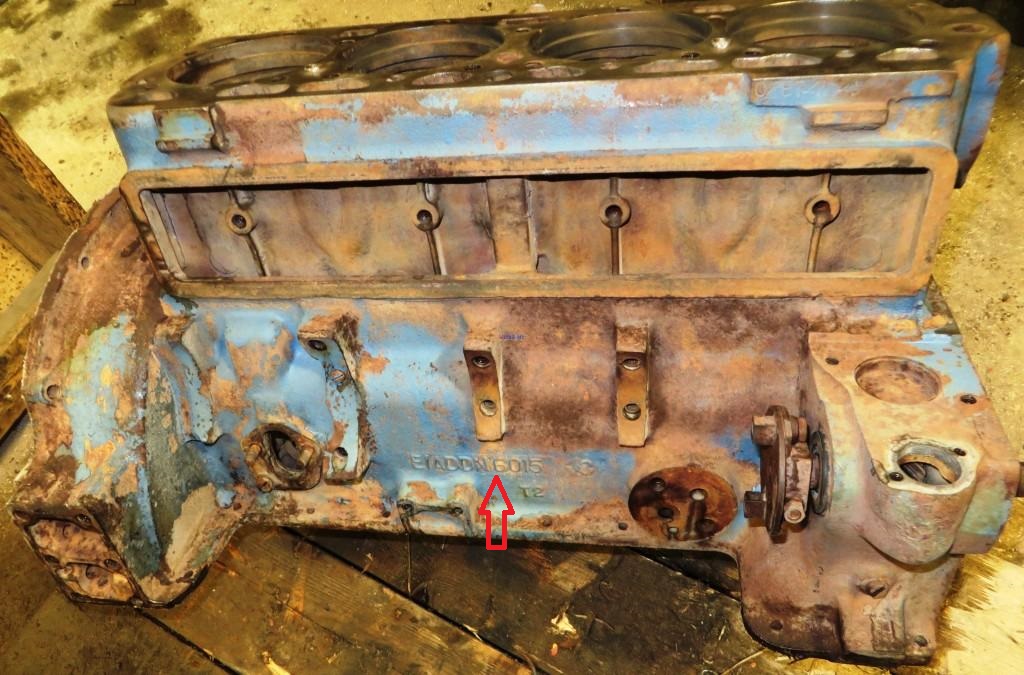
All Ford “Dagenham” engines are fitted with “Wet Liner” cylinders.

The “E1ADDN” Prefix, identifies the block as a Ford 4D “Dagenham” Agricultural engine originally fitted to the Ford “E1A” Ford New Major Tractor, however, blocks with the “E1A” prefix were also used to build 4D engines for automotive and industrial applications. The “6015” is the designator which identifies the part as being a “Raw” engine block casting. All Ford engine blocks are identified with the “6015” designator. The Ford parts schematics will however, list a “BASIC part number” of “6010” for the engine block assembly which is the designator for the engine block in its final machined and assembled form. The “C” suffix to the far right identifies the block as the “C” version and presumably the third version of this casting.
The prefix can sometimes be confusing. For example, the 6-cylinder “Dagenham” 6D Mark-2 diesel engine block can display a “508E” prefix (as shown below) which is the model number for the 6D Mark-2 petrol automotive engine. In this case, this diesel engine has the “508E” prefix because the petrol engines and diesel engines both share the same engine block’s “Raw” casting.
 Ford 6D Mark-2 Diesel Engine Block with a “508E” Prefix to the “Raw” Casting Number.
Ford 6D Mark-2 Diesel Engine Block with a “508E” Prefix to the “Raw” Casting Number.
The Ford 6D Mark-2 Dagenham’s “Raw” Casting Number is cast into the right side of the Engine Block, below and somewhat behind the fuel injection pump when mounted, unlike the later 2700 Range engines where it is located on the left side just under the starter motor and just above the oil sump seam as shown directly below.
Ford “Dorset” Engine Blocks
All early Ford “Dorset” engines, including the 2701E, 2703E, 2704E, 2704ET, 2706E, 2708E and 2709E are “Dry Liner” engines. The later Ford “Dorset” engines, including the 2701C, 2703C, 2704C, 2711E, 2712E, 2713E, 2714E and 2715E are “Parent Bore” engines.
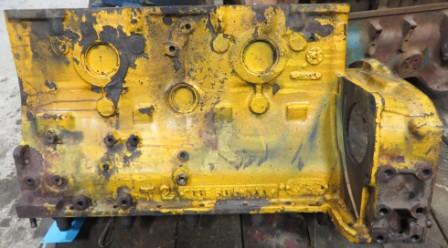 Ford 2701E 4-cylinder “Dry Liner” Block with “703F” Prefix.
Ford 2701E 4-cylinder “Dry Liner” Block with “703F” Prefix.
 Ford 2701E 4-cylinder “Dry Liner” Block with “703F” Prefix, 6015 Designator, and “AAA” Suffix (Close-up).
Ford 2701E 4-cylinder “Dry Liner” Block with “703F” Prefix, 6015 Designator, and “AAA” Suffix (Close-up).
A more perplexing example of a “Raw” Casting Number is in the case of many “Dorset” diesel engines where the “703F” prefix is displayed on both the 4-cylinder blocks (like shown above) and the 6-cylinder blocks (like shown below). And these blocks can be either fitted with 100mm I.D. “Dry Liners” as in the case of the 2703E, or 105mm I.D. “Dry Liners” as in the case of the 2701E block shown above, or are “Parent Bored” to 107mm as in the case of the 2715E block shown below. The “703F” prefixed engine blocks were produced as 4-cylinder and 6-cylinder “Parent Bore” blocks, but were also provided as service blocks for the earlier “Dry Liner” engines where they had to be bored to receive the liners (see Section 1, page 15 of the Ford 2700 Service Manual). Therefore, the “703F” prefix may appear on any of the “Dorset” engines, either “Dry Liner” (4-cylinder 2701E and 6-cylinder 2703E, 2704E, and 2704ET) or “Parent Bore” (4-cylinder 2711E and 2712E, and 6-cylinder 2703C, 2713E, 2704C, 2714E and 2715E). Unfortunately, the “703F” prefix is therefore not much help in distinguishing between these engines.
Note that the suffixes are different. The first “A” of the 4-cylinder block suffix suggests that it is the first use of the 703F block. The “B” of the 6-cylinder block suffix suggests that it is the second type or version of the 703F block.
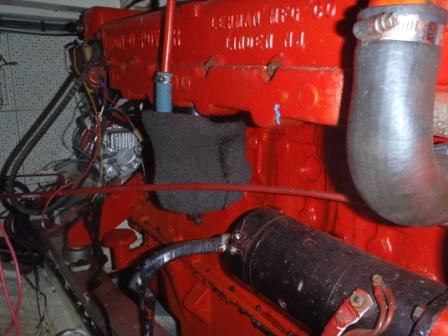 Ford 2715E 6-cylinder “Parent Bore” Block with “703F” Prefix.
Ford 2715E 6-cylinder “Parent Bore” Block with “703F” Prefix.
 Ford 2715E 6-cylinder “Parent Bore” Block with “703F” Prefix and “B…” Suffix.
Ford 2715E 6-cylinder “Parent Bore” Block with “703F” Prefix and “B…” Suffix.
Parent Bore “PB” Identifier
The Ford 2715E and 2714E 6-cylinder “703F” blocks (as shown below) display the raised cast-in “PB” Identifier for “Parent Bore” which is not found on the earlier “Dry Liner” engine blocks. Other “Parent Bore” engine blocks like the 2701C, 2711E, 2712E, 2703C, 2713E and 2704C also show the “PB” Identifier. As mentioned before, the “703F” blocks were supplied as service blocks for “Dry Liner” engines and therefore display the cast-in “PB” identifier, but have “Dry Liners fitted.
 Ford 2715E “703F” Block with “PB” for Parent Bore.
Ford 2715E “703F” Block with “PB” for Parent Bore.
 Ford 2714E “703F” Block with “PB” for Parent Bore.
Ford 2714E “703F” Block with “PB” for Parent Bore.
Ford “Dover” Engine Blocks
The cylinder block below displays the raised “Raw” casting number “826F 6015 EAC” which by the prefix “826” suggests that this block was initially designed for the Ford “826” model engine. The ID plate on this engine’s rocker cover (shown several pictures below under “Valve Rocker Covers”) identifies this engine as a “Parent Bore” 2725E “Dover” diesel engine.

All Ford of Britain built “Dover” engines display the “826F” Prefix on their engine blocks. The “826F” Prefix is also displayed on “Dover” Fuel Filter Bases and Brackets as shown below.
 Ford 826F Fuel Filter Base & Bracket.
Ford 826F Fuel Filter Base & Bracket.
“Ford-Otosan” (Turkey) Engine Blocks
The later Ford-Otosan 2720 range “DoverTech” engines show a “916T” Prefix to the engine block part number just ahead of the starter motor as shown directly below.
 Ford-Otosan 2725 (E2744) “916T” Prefix Engine Block.
Ford-Otosan 2725 (E2744) “916T” Prefix Engine Block.
“OTOSAN” Identifier
These Ford-Otosan engine blocks also show a raised cast-in “OTOSAN” on the right side of the block just to the rear of the fuel injection pump as shown directly below.
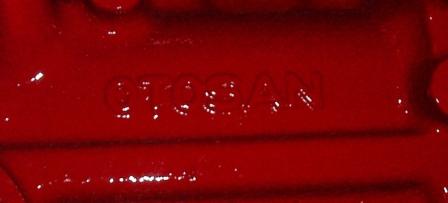 Ford-Otosan 2725 “OTOSAN” Engine Block.
Ford-Otosan 2725 “OTOSAN” Engine Block.
Engine Cylinder Block Part Number PREFIXES
with Corresponding Engine Models
The first column (labeled “PREFIX“) in the table below presents the prefix of the raised cast-in cylinder block part number found on the Ford diesel engines. The second column (Labeled “CYL“) shows the number of cylinders and presents the Cylinder type: “W” for “Wet” liner, “D” for “Dry” Liner, and “P” for “Parent bore”. The corresponding engine models are then listed. This information can help narrow down what engine model the cylinder block might be part of. Click on the engine model link to go to our webpage for more details about that particular model.
We will continue to update this information as it comes in.
| PREFIX | CYL | DAGENHAM | DORSET | DOVER |
|---|---|---|---|---|
| E1A. | 4-W | 4D (E1A.‚ ET‚ 562E‚ 954E) | ||
| ^ | ^ | 4D Mark-2 (E1A?‚ 530E‚ 592E) | ||
| ^ | ^ | EBRO 4D Mark-2 (E1A?‚ 592E) | ||
| 508E. | 4-W | 6D Mark-2 (510E‚ 590E‚ 590ET). | ||
| 510E? | 4-W | 6D Mark-2 (510E‚ 590E‚ 590ET) | ||
| 683F⋅ | 4-D | 2701E⋅‚ 2706E⋅ | ||
| 2701E? | 4-D | 2701E‚ 2706E | ||
| 703F*. | 4-D | 2701E.‚ 2706E | ||
| 2702E**. | 6-D | 2703E.‚ 2708E | ||
| 703F* | 4-D | 2703E‚ 2708E | ||
| 2702E**. | 6-D | 2704E.‚ 2709E | ||
| 703F*⋅ | 6-D | 2704E⋅‚ 2709E⋅ | ||
| 683F? | 6-D | 2704ET | ||
| 703F* | 6-D | 2704ET | ||
| 626F? | 4-P | 2701C‚ 2711E‚ 2712E | ||
| 703F*. | 4-P | 2701C‚ 2711E‚ 2712E. | ||
| ? | 6-P | 2703C‚ 2713E | ||
| 703F* | 6-P | 2703C‚ 2713E | ||
| 68?F'70. | 6-? | 27?? | ||
| 683F. | 6-? | 2715? | ||
| 703F*. | 6-P | 2704C‚ 2714E.‚ 2715E. | ||
| ? | 4-P | 2722 | ||
| ? | 6-P | 2723 | ||
| 693F? | 6-D | 2726T‚ 2728T | ||
| 826F. | 6-P | 2724‚ 2725. | ||
| 826F. | 6-D | 2726T‚ 2728T. | ||
| 916T (Otosan). | 6-P | 2724‚ 2725. | ||
| 916T (Otosan) | 6-D | 2726T‚ 2728T | ||
Notes: Table under development. We will add information as it comes in. If you can help, email To: Editor♥EverythingAboutBoats.org (Replace “♥” with “@”)
*The “703F” prefixed engine blocks were produced as 4-cylinder and 6-cylinder “Parent Bore” blocks, but were also provided as service blocks for the earlier “Dry Liner” engines where they had to be bored to receive the liners (see Section 1, page 15 of the Ford 2700 Service Manual). Therefore, the “703F” prefix may appear on any of the “Dorset” engines, either “Dry Liner” or “Parent Bore” including the 4-cylinder 2701E, 2701C, 2711E and 2712E, and the 6-cylinder 2703E, 2703C, 2713E, 2704E, 2704ET, 2704C, 2714E and 2715E. Unfortunately, this means that the “703F” prefix is not much help in distinguishing between these engines.
**In the pictures below, the Ford “2702E 6015” part number can be seen cast into the 330 cubic inch displacement 6-cylinder “Dry Liner” diesel engine block, however Ford apparently never put a 2702E engine into production, and no such model can be found in any official Ford documentation we have. The 2702E block may have been originally intended for a low power rated 2702E engine which turned out not being put into production. The 2702E labeled block was however used for the 2703E model engine. This particular engine was identified as a 2703E. This apparent mislabeling is not uncommon due to Ford’s parts numbering system.

The “raw” engine block part number is usually cast into the left side of the engine block near the oil pan seam as shown below. Note the “FoMoCo” logo that follows the part number.

The “2702E” Prefix has also been found on the 363 cubic inch displacement 6-cylinder Ford 2704E “Dry Liner” cylinder block engines as shown below.
 Ford 2704E Block w2702E Prefix.
Ford 2704E Block w2702E Prefix.
Intake Manifolds
Note that the above 2703E engine’s intake manifold (shown below) displays the raised “590E” cast-in part number used by the earlier Dangenham 6D “590E” Industrial diesel engine. The “A” suffix indicates that it is the initial version of this part. So in this case, the earlier 590E part fits the later 2703E engine, so there was no need to create a new part with a new part number. The older part was simply used on the newer engine. This part was also used in other models. The “8425” designator or basic number (middle part of the part number) identifies the part as an intake manifold. This manifold was not used on many marinized engines as Lehman and others had their own manifolds, usually combining both the intake and the exhaust manifolds into one manifold which was water cooled with antifreeze filled coolant jackets.
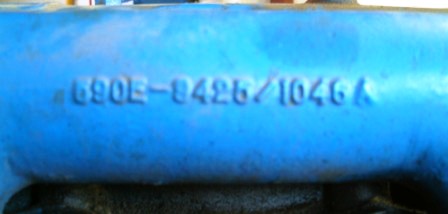
Valve Rocker Covers
The rocker cover below is identified by the ID plate as fitting a 4-cylinder 2712E “Dorset” diesel engine. Just above the ID plate is displayed the full stamped rocker cover part number of “703F 6582 AAA” suggesting that the rocker cover was initially designed for the Ford “703F” model engine. The “6582” is the designator or basic number for all Ford rocker covers. The “AAA” suffix suggests that this cover is the initial version of this cover.

The rocker cover below is identified by the ID plate as fitting a 4-cylinder 2722E Dover diesel engine. Just below the ID plate is displayed (upside-down) the full stamped rocker cover part number of “826F 6582 AAB” suggesting that the rocker cover was initially designed for the Ford “826F” model engine. The “6582” is the designator or basic number for all Ford rocker covers.
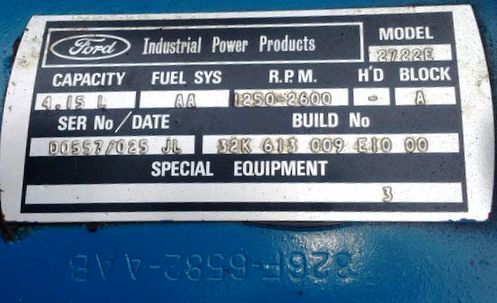

The “AAB” suffix on this rocker cover indicates that this cover is an early/initial version. This cover was fitted to all 4-cylinder Dover engines. But the “826F” prefix also appears on 6-cylinder Dover valve rocker covers as shown below.
The rocker cover below is identified by the ID plate as fitting a 6-cylinder 2725E diesel engine. Just above and slightly to the right of the ID plate is displayed the full stamped rocker cover part number of “826F 6582 EAB”. The prefix is the same as the cover above for the 4-cylinder. The “EAB” suffix indicates that the cover was modified (lengthened) to fit the 6-cylinder engines.

Cylinder Heads
Parsons marinized the 6D “Dagenham” base engine and marketed it as the “Barracuda” shown below. Note the location of the cylinder head’s raised part number followed by the raised “FL” identifier (partly obscured by the hoses) which will be discussed later.
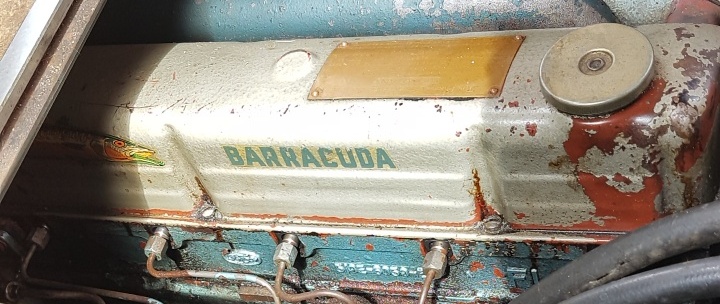
The cylinder head’s raised part number is displayed in the middle of the right side of the head. On this engine the part number begins with “510E” which suggests that the head was initially designed to fit the 6D Mark-2 “Dagenham” model “510E” automotive (lorry) diesel engine. The “6050” is the designator used for Ford “Raw” Cylinder Head Castings from the “Dagenham” up through the “Dry Liner” “Dorset” engines where it changed to “6090” beginning with the “683F” “Parent Bore” “Dorset” head.
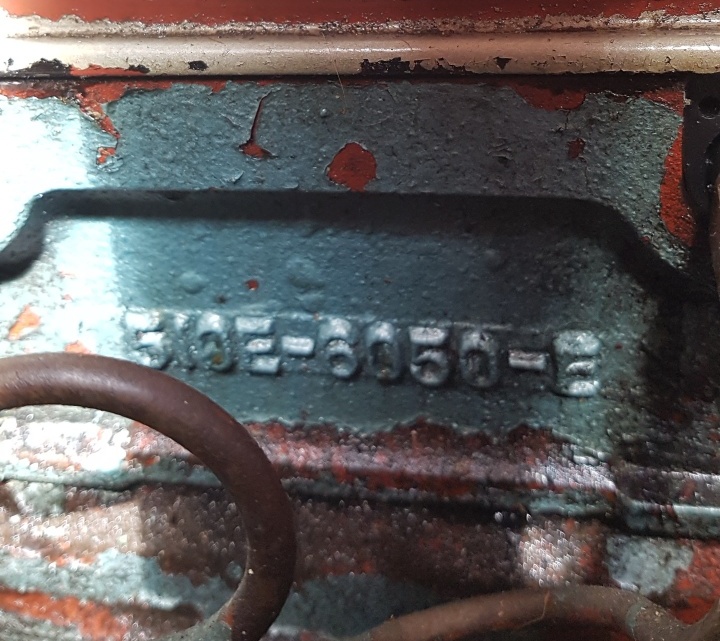
The “-E” suffix above indicates that this was the fifth version of this casting.
Engine Cylinder Head Part Number PREFIXES
with Corresponding Engine Models
The first column (labeled “PREFIX“) in the table below presents the prefix of the raised cast-in cylinder head part number found on the Ford diesel engines. The second column (Labeled “CYL“) shows the number of cylinders and presents the Cylinder type: “W” for “Wet” liner, “D” for “Dry” Liner, and “P” for “Parent bore”. The corresponding engine models are then listed. This information can help narrow down what engine model the cylinder block might be part of. Click on the engine model link to go to our webpage for more details about that particular model.
We will continue to update this information as it comes in.
| PREFIX | CYL | DAGENHAM | DORSET | DOVER |
|---|---|---|---|---|
| E1A? | 4-W | 4D (E1A‚ ET‚ 562E‚ 954E) | ||
| ^ | ^ | 4D Mark-2 (E1A?‚ 530E‚ 592E) | ||
| ^ | ^ | EBRO 4D Mark-2 (E1A?‚ 592E) | ||
| 510E (FL±). | 6-W | 6D Mark-2 (510E.‚ 590E‚ 590ET) | ||
| 2701E | 4-D | 2701E‚ 2706E | ||
| 2702E | 6-D | 2703E‚ 2708E | ||
| 2703E | 6-D | 2703E‚ 2708E | ||
| 2703E. | 6-D | 2704E.‚ 2709E. | ||
| ? | 6-D | 2704ET | ||
| 623? | 4-P | 2701C‚ 2711E‚ 2712E | ||
| 743F. | 4-P | 2701C‚ 2711E‚ 2712E. | ||
| ? | 6-P | 2703C‚ 2713E | ||
| 683F*. | 6-P | 2704C‚ 2714E.‚ 2715E. | ||
| 823F. | 6-P | 2704C‚ 2714E‚ 2715E. | ||
| ? | 4-P | 2722 | ||
| ? | 6-P | 2723 | ||
| 826F | 6-P | 2725 | ||
| ? | 6-D | 2726T‚ 2728T | ||
Notes: Table under development. We will add information as it comes in. If you can help, email To: Editor♥EverythingAboutBoats.org (Replace “♥” with “@”)
The cylinder head identified by the raised cast-in “raw” head 510E-6050-E casting number is the “Dagenham” 6-cylinder “FL” head (see next).
*Some “683F” Prefix heads lack the “8” in the prefix. They have just an empty “space” (see arrow below). They also show the later “6090” designator for “Raw” head castings.
 Ford 2715E w/6-3F Head Prefix.
Ford 2715E w/6-3F Head Prefix.
The “FL” Identifier Cast into Dagenham Cylinder Heads
The raised “FL” identifier appears a few inches to the right of the head’s “raw” casting number as shown below.

The “FL” head was the improved “high air flow” head that first appeared on the “Dagenham” 6D Mark-2 diesel engines in 1962 and the 4D Mark-2 engines in 1963. The “FL” head was often back-fitted to older Dagenham engines as replacement heads. The raised cast-in “FL” identifier which distinguished whether or not the Dagenham engine was equipped with the improved “high air flow” heads was of course eliminated with the introduction of the 2700 range engines because all 2700 and later series engines had “high air flow” type heads and therefore did not need to be so identified. These heads utilized “vortex technology” similar to the General Motors “Vortec” heads introduced in 1984 small block V8 petrol engines.
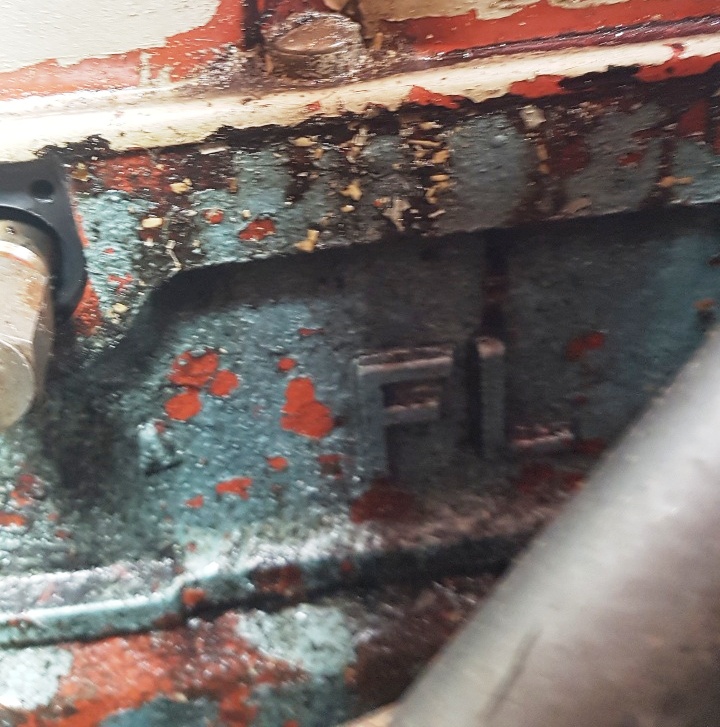
The “OTOSAN” Identifier Cast into the Cylinder Head
The later Ford-Otosan cylinder heads show a raised cast-in “OTOSAN” on the right side of the engine.
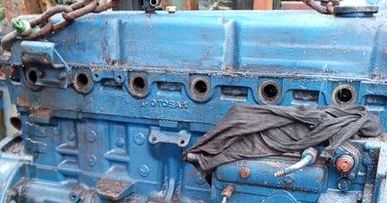
Diesel Injection Pump Identification
Identification of Ford diesel engines can be aided by identifying the diesel injection pump. The pump is identified by an ID plate affixed to the pump (see illustrations below with ID plate circled in red). Keep in mind that the pump may have been replaced with whatever pump was available and may be a mismatch to the engine.
The following Pages from the Ford 2700 & 2710 “Dorset” Range Service Manual should help identify the diesel injection pumps on the various “Dorset” engines. Similar information for other models can be found in other Ford manuals and parts catalogs. Note the striking differences in specifications. The highest performance and engine longevity can best be achieved if the correct fuel injectors and injection pump are matched to the correct engine model for the application. Due to the vast variety of injection pumps, replaced pumps are too often found to be mismatched to the engine. Also keep in mind that some pumps have been modified and/or recalibrated, and therefore no longer match their original specifications. It is also important to prevent mismatching injectors in the engine.
Section 3 Page 1r – Simms Minimec In-line “Jerk” Type Injection Pump
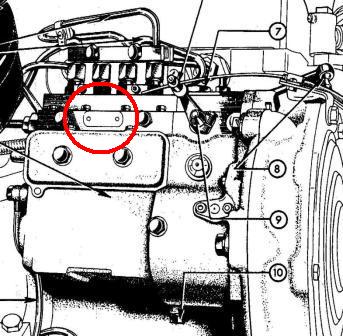
Section 3 Page 38 – CAV “Distributor” Type Injection Pump
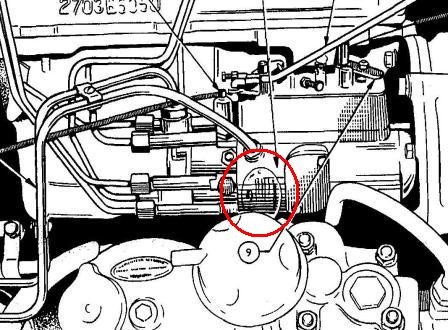
In the illustration above, take note of the raised cylinder head part number cast into the head shown in the top-left corner. The part number starts with “2703E” immediately followed by “6050”. See the earlier section on Casting Part Numbers for their significance.
Brand new Ford engines marinized by the primary marinizers like Lehman, Mermaid, etc. rarely had distributer type fuel injection pumps instead of the Simms Minimec In-line “Jerk” Type Injection Pump. Therefore, any Ford engine in marine service that is fitted with a distributer type fuel injection pump was likely to have been a used “Take-Out” engine from a tractor, lorry, generator or such a vehicle or piece of equipment. It was not unusual to find newly built vessels with used ford engines fitted. It is not uncommon for such “Take-Out” engines to be mistaken for new engines until more deeply examined. It is also not unusual for Ford 6–cylinder diesel engines to be called Lehman 120’s just because they have a Lehman manifold fitted or were painted red. Far to often these engines turn out to be completely different Ford models, and sometimes models that Lehman never marinized. Unfortunately, some of these engines turn out to be engines marinized by inexperienced private parties who simply used Lehman parts.
Section 3 Pages 17r thru 18r – Injection Pump Part Numbers and Calibration
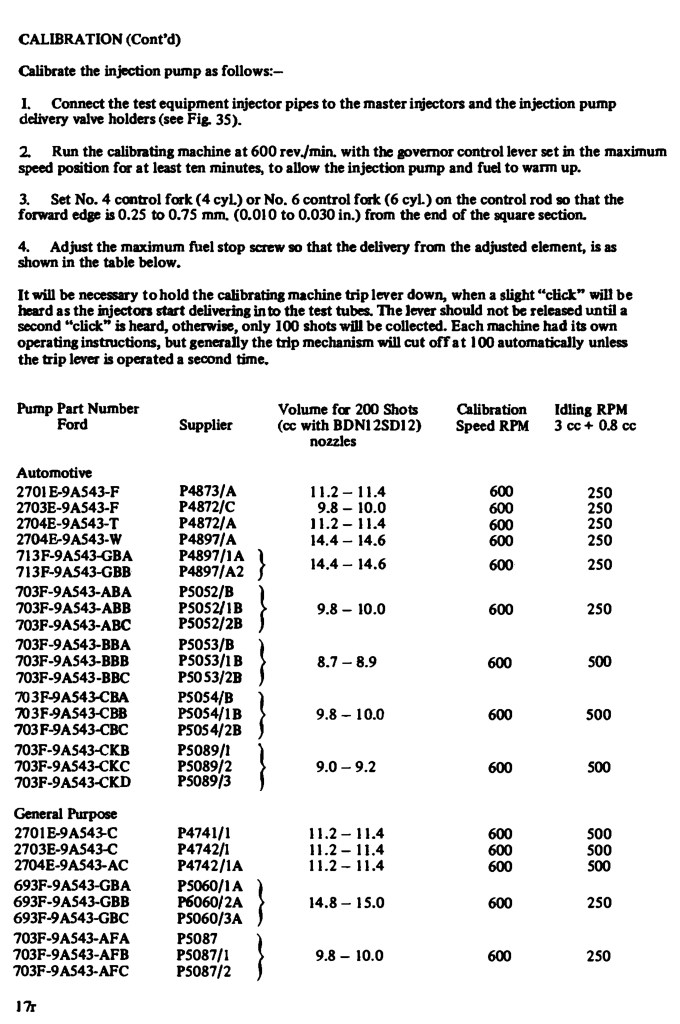
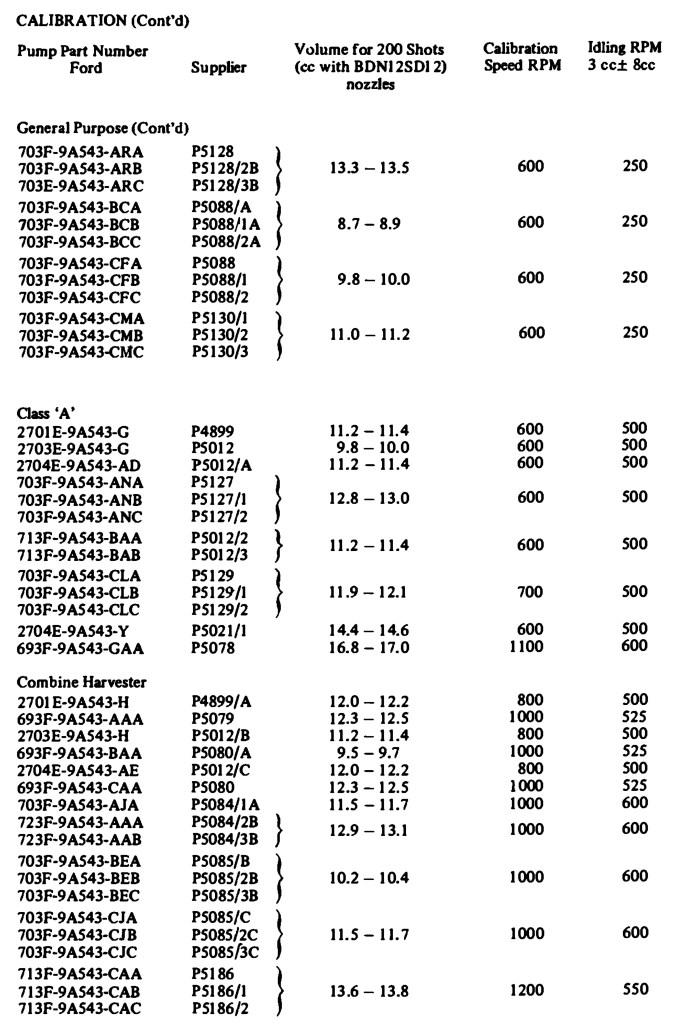
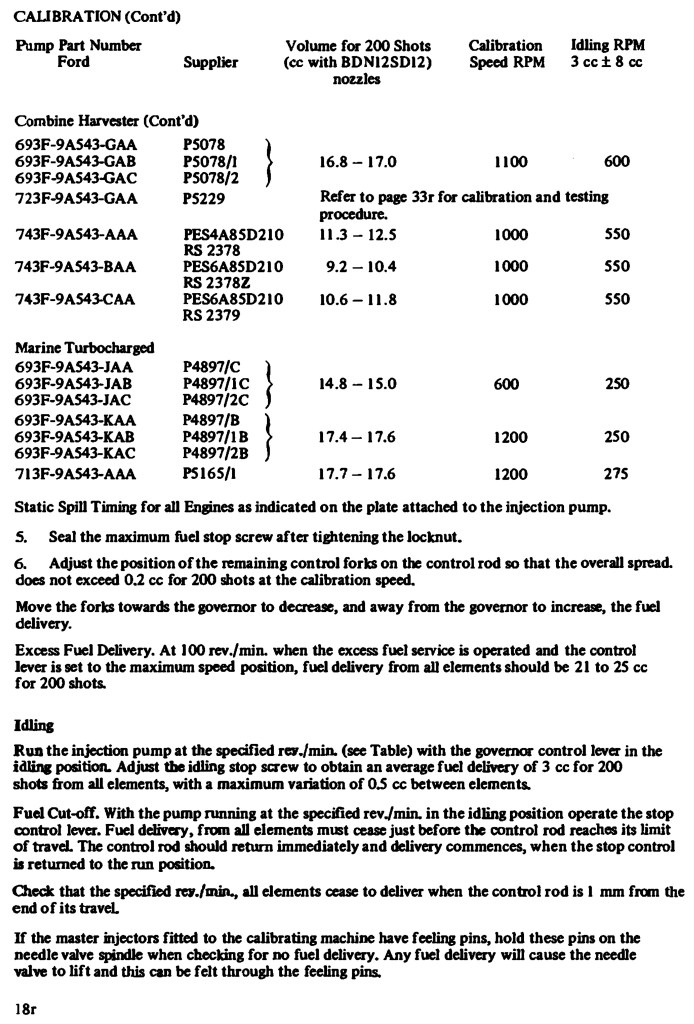
Section 7 Pages 2 & 2r – Combine Harvester Injector Pump Part Numbers

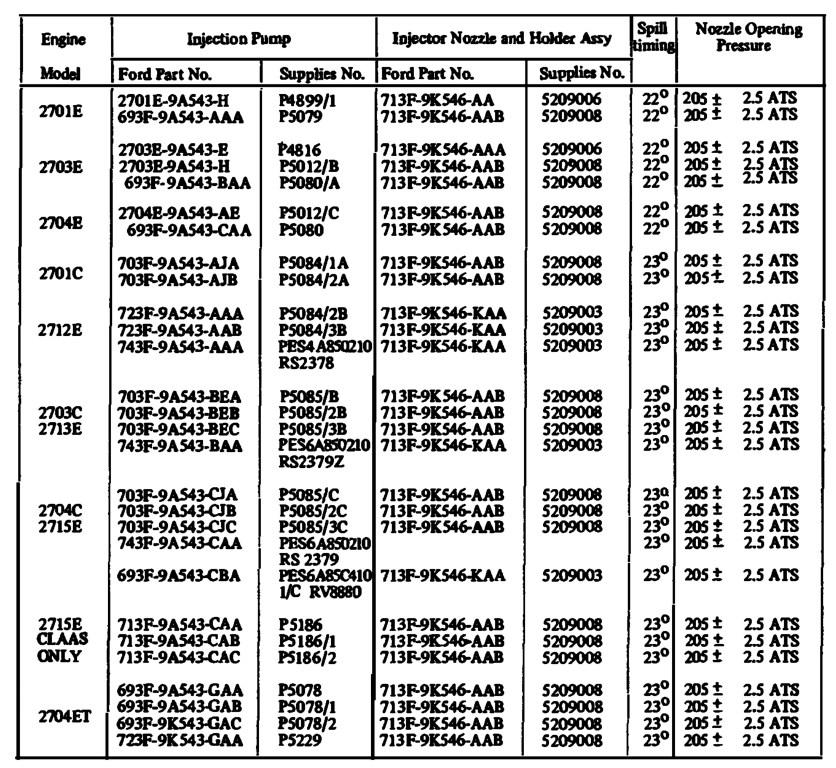
Identifying Engines By Their Distinct Features
All of these Ford models are 4-Stroke cycle, direct injected, overhead valve, push rod, 4 or 6 cylinder, inline, reciprocating piston engines. All models have a piston stroke of 115mm (4.52 inches) or more exactly 114.7mm (4.516 inches). Each engine family (“Dagenham”, “Dorset” and “Dover”), each engine Range (“D”, “2700”, “2710” and “2720”), and each engine model (see our Ford Industrial Power Products webpage) possess distinct features that can help identify the engine. Many are external and therefore easy to observe, but some are internal and require partial disassembly of the engine to determine.
Fuel Injection Pump Cambox Lubrication
The “Dagenham” and “Dorset” inline “Jerk” type fuel injection pumps have isolated cambox sumps and require oil changes much like the engine oil. An oil overflow pipe can usually be found plumbed into the injection pump slightly above the level of the cambox oil level plug.
A Ford 6-cylinder “Dagenham” fuel injection pump cambox oil level plug is shown below (see the left arrow pointing to the right) and the oil overflow pipe is also shown below (see the right arrow pointing to the left).
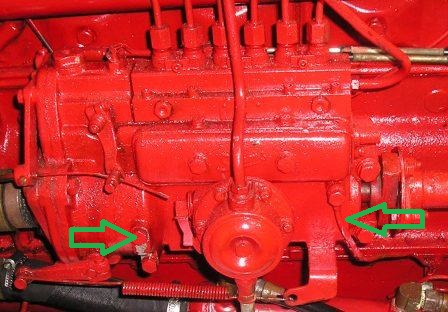 Ford 6-Cylinder “Dagenham” Fuel Injection Pump.
Ford 6-Cylinder “Dagenham” Fuel Injection Pump.
A Ford 6-cylinder “Dorset” fuel injection pump cambox oil overflow pipe is shown below (see arrow on the left) and the oil level plug is shown below (see arrow on the right).
 Ford 6-Cylinder “Dorset” Fuel Injection Pump.
Ford 6-Cylinder “Dorset” Fuel Injection Pump.
The drain end of the oil overflow pipe usually just drips on the ground as in the case of an automotive engine, or into the bilge as in the case of a marine engine. Neither is acceptable. Therefore, It is a good idea to install a catch container that can be drained when required. Examine this oil for diesel fuel dilution. Diesel fuel normally leaks very slowly inside the injection pump and will contaminate the cambox oil over time. If the drain is draining more then a drip or two per hour, the injection pump may be leaking more diesel fuel internally then normal and the cambox oil should be checked for fuel. If the cambox oil is badly diluted, the old oil should be drained and fresh oil installed before the injection pump suffers serious internal damage, especially to the governor. See our article about Checking Ford injection pump oil for contamination. A fuel leak inside the injection pump can flood the cambox sump and overflow into the catch container fairly quickly, so it is recommended that the container be checked often as it can be your first sign of a serious fuel leak inside the injection pump. It is NOT a good idea to plumb this overflow pipe into the engine’s oil sump (oil pan) as it creates the possibility of rapid diesel fuel contamination of the engine oil which is hard to detect without an oil analysis. It is possible for this type injection pump to leak cambox oil into the engine timing gear housing where it will drain into the engine oil sump if the injection pump camshaft seal is leaking.
The “Dover” fuel injection pump cambox sumps are fed engine oil from the engines’ pressurized oil galleys through a flow restrictor fitting and then an oil fill line (see arrow below). As the cambox sump overflows, oil is drained back into the engine’s oil sump (the oil pan) by an internal oil return canal located at the gear end of the injection pump that drains cambox overflow oil into the timing gear housing.
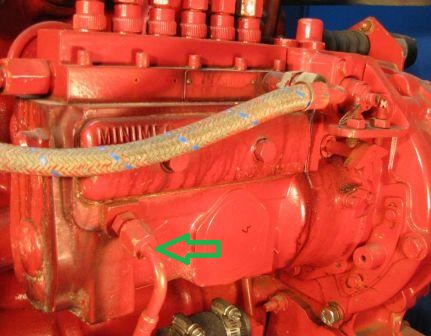 Ford 2725 Cambox Sump Fill Piping from Engine.
Ford 2725 Cambox Sump Fill Piping from Engine.
It is normal for a very small amount of diesel fuel to continually leak internally into the cambox sump whenever the engine is running. And since the cambox is continually draining into the engine’s oil sump, this diesel fuel will eventually end up in the engine oil. Be on the lookout for diesel fuel in the engine oil, and especially a rapid rise of engine oil level showing on the dipstick as this may indicate a serious fuel leak, either inside the injection pump, the fuel injectors, or the fuel lift pump. Diesel dilution of engine oil can quickly lead to serious damage of internal engine components. Routine oil sampling and analysis is recommended to detect and remedy oil contamination before it causes serious engine damage.
Blockage of fuel system diesel fuel return piping to the fuel tank can cause diesel leaks to develop elsewhere in the system. See our article on Diesel Fuel Systems.
Fuel Injection Pump Drives
The “Dagenham” engines have external fuel injection pump drives that can be seen turning whilst the engine is running (see red circle in picture below showing a “4D”).
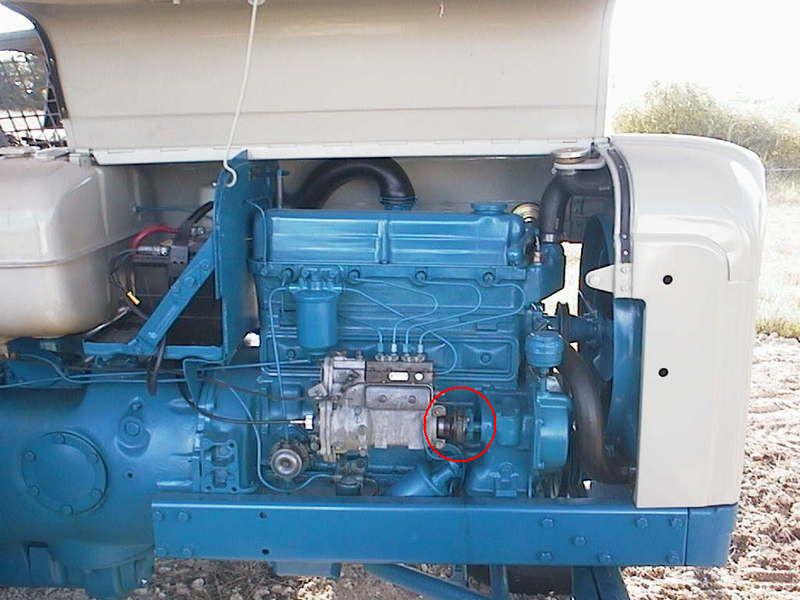
The 6-cylinder “6D” was fitted with a 6″ jackshaft to drive the injection pump as shown below as the injection pump was mounted further aft on the longer 6-cylinder engine block. Since these couplings and jackshafts rotate whilst the engine is running, they are sometimes protected by aftermarket guards that are fitted to prevent injury to operators, mechanics and bystanders.
 1955 Fordson Tractor repowered with 6D Diesel Engine.
1955 Fordson Tractor repowered with 6D Diesel Engine.
The “Dorset” and “Dover” fuel injection pumps are directly driven by the engine’s internal timing drive gears (see picture below).
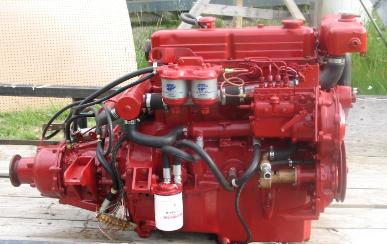
Note how the fuel injection pump is mounted directly to the timing gear housing at the front of the engine. Injection timing was adjusted using the slots for the mounting bolts in the injection pump’s mounting bracket (see the arrows below).
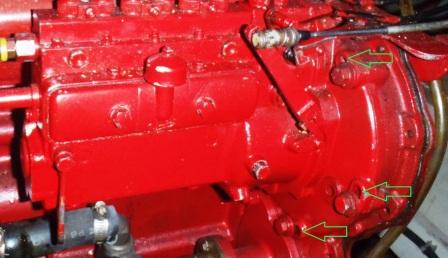 Ford 2715E Injection Pump Timing Slots.
Ford 2715E Injection Pump Timing Slots.
If the pump’s injection timing has been adjusted and the pump has had to be rotated so far that the mounting bolts are all the way against the ends of the slots as shown below by the arrows, this may indicate that the timing gears have suffered excessive wear and may be near failure (see next section), and it would be wise to inspect the gears for wear. As the gears wear, the injection timing becomes more retarded. When the pump adjustment runs out of slot travel before the specified timing can be attained, the engine will be running retarded with a loss of power, increased exhaust smoke, cylinder carbonization, and other consequences including imminent timing gear failure. A close examination of the gears is called for. See our article on Ford timing gear failures.
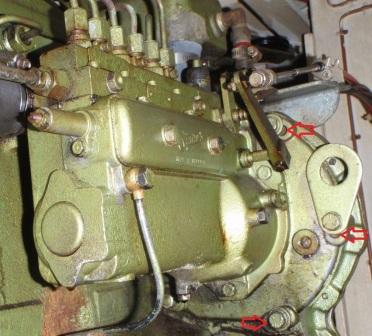 Ford 2714E Injection Pump Timing Slots – Timing Gear Wear?
Ford 2714E Injection Pump Timing Slots – Timing Gear Wear?
Timing Gears
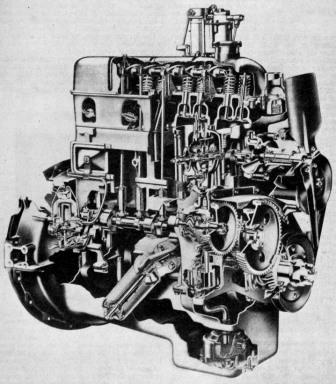 Cut0away View of Four-Cylinder Ford Dagenham Engine Showing Timing Gears.
Cut0away View of Four-Cylinder Ford Dagenham Engine Showing Timing Gears.
The Ford engine’s timing gears are internal and cannot be seen without removing the timing gear cover (as shown below), the injection pump, or in the case of most marinised engines, the directly driven raw water pump (if used).
The “Dagenham” and “Dorset” engines have Helical (curved) tooth timing gears shown below. Helical cut gears tend to wear rapidly, especially if also driving the raw water pump, and should therefore be checked routinely to prevent serious internal engine damage when the gears fail. Other engine problems can accelerate gear wear. See our article on Ford timing gear failures.
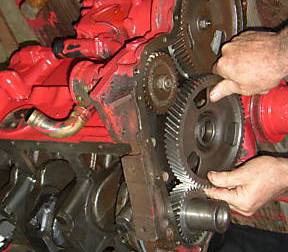
The “Dover” engines have the more robust, but noisier straight tooth timing gears. These gears wear less because more of the driving tooth surface is in contact with the driven tooth surface.
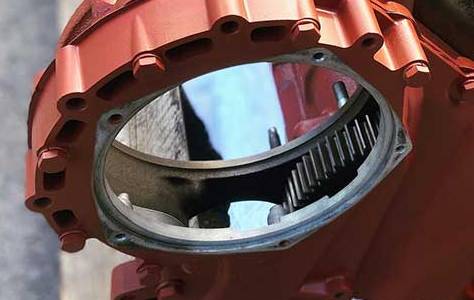
Ford switched to straight tooth timing gears as shown above because of the rapid wear experienced by the helical tooth gears. These straight tooth gears should also be routinely checked for wear as they can wear prematurely due to internal fuel injection pump problems, raw water pump problems, and/or engine camshaft or valve train problems which can create gear chatter in the engine’s timing gears. Again, see our articles on Ford timing gear failures.
Timing Gear Covers
The timing gear cover is external and can be easily inspected at the front of the engine. The timing gear cover encloses the crankshaft’s driving gear, the camshaft’s driven gear, and the fuel injection pump’s driven gear. On “Dorset” and “Dover” engines it also encloses the raw water pump’s driven gear.
The “Dagenham” engines have Cast Aluminium timing gear covers as shown below.
 Ford 6D Dagenham Diesel Engine Aluminum Timing Gear Cover.
Ford 6D Dagenham Diesel Engine Aluminum Timing Gear Cover.
Most “Dorset” engines have the single piece pressed steel timing gear covers as shown below.
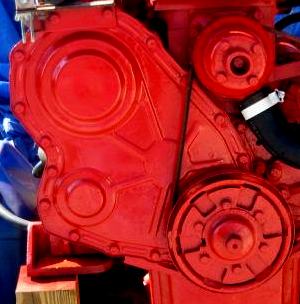 Dorset engine with stamped/pressed steel timing gear cover.
Dorset engine with stamped/pressed steel timing gear cover.
The “Dover” engines and some earlier “Dorset” engines that have been replaced with later service replacement engines, have cast aluminum timing gear covers as shown below. The thicker aluminum covers help reduce the noise generated by the straight tooth timing gears.
 Ford “Dover” engine with cast aluminum timing gear cover and concaved injection pump gear cover.
Ford “Dover” engine with cast aluminum timing gear cover and concaved injection pump gear cover.
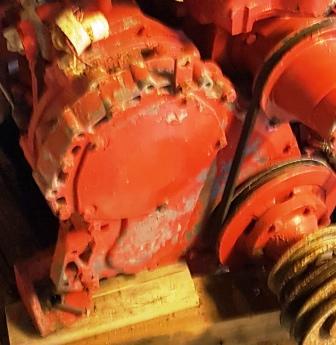 Ford “Dover” engine with cast aluminum timing gear cover and convexed injection pump gear cover.
Ford “Dover” engine with cast aluminum timing gear cover and convexed injection pump gear cover.
Valve Rocker Covers
The valve rocker cover is external and can be easily inspected at the top of the engine. it is however, the least dependable way to identify an engine as these covers are sometimes painted or replaced by other covers.
The “Dagenham” and “Dorset” engines were typically delivered with painted valve covers.

The “Dover” engines were usually delivered with the easily recognized chrome valve covers.
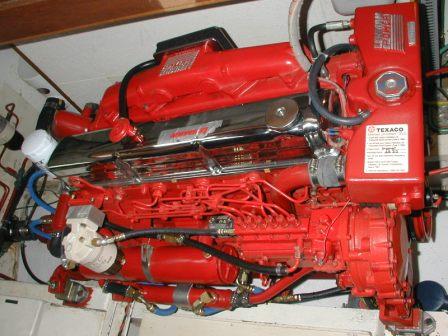
These chrome valve covers sometimes got painted.
Cylinder Head Ports
ΞPIXΞ
Compare smaller port size of Dorset head (Left) to Dover head (Right).
Cylinder heads of Dover engines have larger ports (Intake & Exhaust) then Dorset engines, hence the higher horsepower ratings for the Dover engines then the Dorset engines.
Cylinder Liner Types

As shown below, all “Dagenham” engines have “wet” liner cylinders, all Early “Dorset” engines have “Dry” liner cylinders, and most Later “Dorset” engines and most “Dover” engines have “Parent” bore cylinders, however factory turbocharged “Dorset” and “Dover” engines always have “Dry” liner cylinders. Unfortunately, many aftermarket turbocharged “Dorset” and “Dover” engines were originally Naturally Aspirated “Parent” Bore engines which tend to suffer more cylinder wear due to the greater side thrust of the pistons against the softer cast iron “Parent” Bore cylinder walls when turbocharged.
“Dorset” and “Dover” engine cylinder bores and liners are internal inside the engine block and usually cannot be determined without removing the cylinder head. Removing the oil pan may not expose the bottom end of the bores or liners for conclusive inspection.
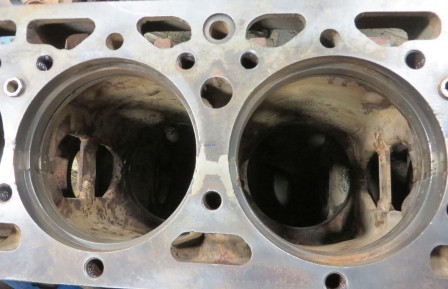 Ford 4D Block, “Wet Liners” Removed.
Ford 4D Block, “Wet Liners” Removed.
Above, the water jackets in the engine block can be clearly seen with the “Wet Liners” removed.
Below, the top edge of the “Dry Liners” pressed into the cylinder block can barely be seen.
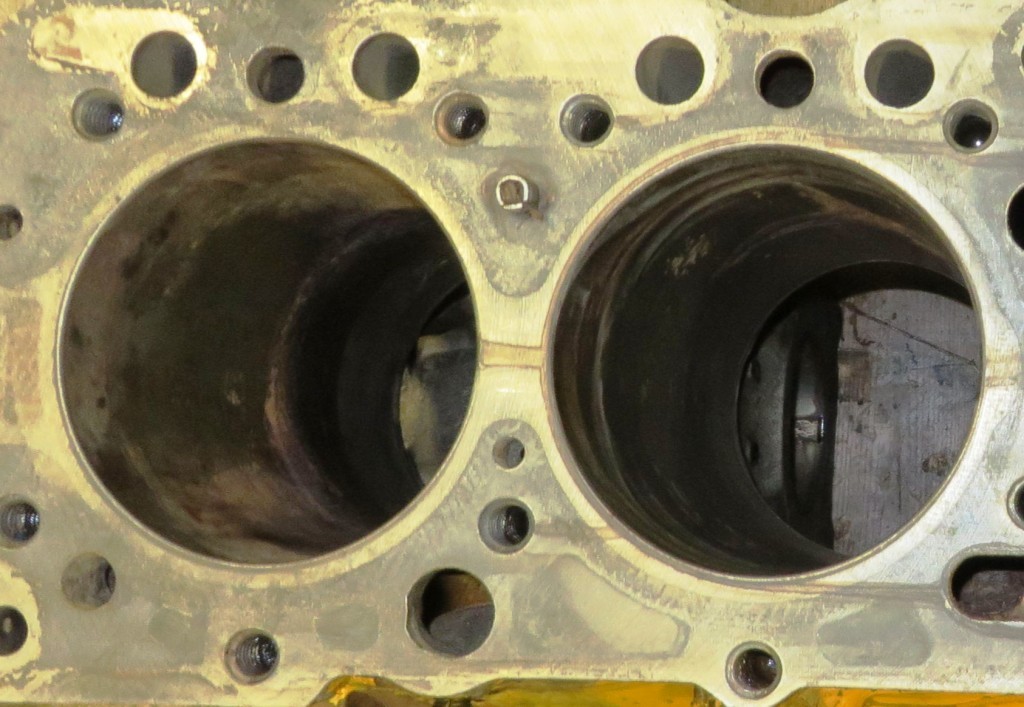 Ford 2701E Block, “Dry Liners” Installed.
Ford 2701E Block, “Dry Liners” Installed.
It can be difficult to see the “Dry Liners” pressed into the engine block above until the top end of the liners are cleaned or lightly sanded. The slightly different texture and coloring of the liner can be seen on the left edge of the left liner above and distinguished from the cast iron block.
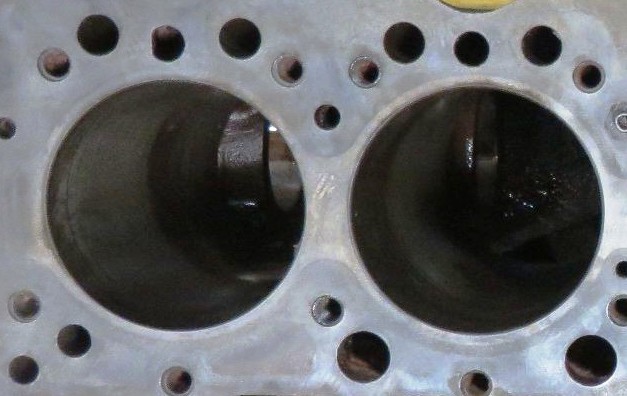 Ford 2715E Block, “Parent Bore” Type Cylinders.
Ford 2715E Block, “Parent Bore” Type Cylinders.
“Native/Parent Bore” cylinders like the 2715E above are part of the engine block casting, and bored and honed to fit the pistons which when installed ride directly on the engine block casting. The softer Cast Iron “Native/Parent” cylinder metal wears much faster then the harder “Wet” or “Dry” liners, especially when the engine is aftermarket turbocharged. “Parent” Bore cylinders are sometimes bored and fitted with dry liners in order to salvage a cylinder block.
Engine Cylinder Liner/Bore Types
with Corresponding Engine Models
The first column (labeled “CYL” presents the Cylinder type: “W” for “Wet Liner”, “D” for “Dry Liner”, and “P” for “Parent Bore”. The second column (Labeled “#“) shows the number of cylinders. The corresponding engine models are then listed. This information can help narrow down the engine model. Click on the model link to go to our webpage for more details about that particular model.
| CYL | # | DAGENHAM | DORSET | DOVER |
|---|---|---|---|---|
| W | 4 | 4D (E1A‚ ET‚ 562E‚ 954E) | ||
| ^ | ^ | 4D Mark-2 (E1A?‚ 530E‚ 592E) | ||
| ^ | ^ | EBRO 4D Mark-2 (E1A?‚ 592E) | ||
| W | 6 | 6D Mark-2 (510E‚ 590E‚ 590ET) | ||
| D | 4 | 2701E‚ 2706E | ||
| D | 6 | 2703E‚ 2708E | ||
| D | 6 | 2704E‚ 2709E | ||
| D | 6 | 2704ET | 2726T‚ 2728T | |
| P | 4 | 2701C‚ 2711E‚ 2712E | 2722 | |
| P | 6 | 2703C‚ 2713E | 2723 | |
| P | 6 | 2704C‚ 2714E‚ 2715E | 2724‚ 2725 | |
Notes:
Engine Cylinder Bores (Sizes)
with Corresponding Engine Models
All “Dagenham” engines have “wet” cylinder liners with 100mm cylinder bores, All Early “Dorset” engines have either 100mm or 105mm “dry” liner cylinder bores. The Later “Dorset” 2703C and 2713E (naturally aspirated) engines and the “Dover” 2723 (naturally aspirated) engine have 105mm “Parent Bore” cylinders. All other naturally aspirated Later “Dorset” engines and “Dover” engines have 107mm “Parent Bore” cylinders. All turbocharged “Dorset” and “Dover” engines have “dry” liners with 105mm cylinder bores. The cylinder bores are internal inside the engine and cannot be measured without removing the cylinder head. The cylinder bores may be very difficult to measure by removing just the oil pan.
In the Table below, the first column (labeled “BORE“) presents the Cylinder Bore: 100mm (3.937in). 105mm (4.125in). 107mm (4.221in). The second column (Labeled “CYL“) shows the number of cylinders and presents the Cylinder type: “W” for “Wet” liner, “D” for “Dry” Liner, and “P” for “Parent Bore”. The corresponding engine models are then listed. This information can help narrow down the engine model. Click on the model link to go to our webpage for more details about that particular model.
| BORE | CYL | DAGENHAM | DORSET | DOVER |
|---|---|---|---|---|
| 100mm | 4-W | 4D (E1A‚ ET‚ 562E‚ 954E) | ||
| ^ | ^ | 4D Mark-2 (E1A?‚ 530E‚ 592E) | ||
| ^ | ^ | EBRO 4D Mark-2 (E1A?‚ 592E) | ||
| 100mm | 6-W | 6D Mark-2 (510E‚ 590E‚ 590ET) | ||
| 100mm | 6-D | 2703E‚ 2708E | ||
| 105mm | 4-D | 2701E‚ 2706E | ||
| 105mm | 6-D | 2704E‚ 2709E | ||
| 105mm | 6-D | 2704ET | 2726T‚ 2728T | |
| 105mm | 6-P | 2703C‚ 2713E | 2723 | |
| 107mm | 4-P | 2701C‚ 2711E‚ 2712E | 2722 | |
| 107mm | 6-P | 2704C‚ 2714E‚ 2715E | 2724‚ 2725 | |
Ford Cargo Lorry Engines by Lorry Series & Years of Production
IDs, Engines, Lorry Series, Years, Bore, Number of Cylinders and Cubic Inch Displacement.
All engines feature “Dry Cylinder Liners & 4.52” Stroke.
| ID | ENGINES | SERIES | YEARS | BORE | CYL | DISP |
| xxxx | 2714E‚ 2715E | 712 | 3/81∼9/81 | 4.22" | 6 | 380 |
| 6028 | 2714E‚ 2715E | 713 | 10/81∼12/91 | 4.22" | 6 | 380 |
| 6029 | 2714E‚ 2715E | 812 | 3/81∼9/81 | 4.22" | 6 | 380 |
| 6030 | 2714E‚ 2715E | 813 | 10/81∼12/91 | 4.22" | 6 | 380 |
| 6031 | 2714E‚ 2715E | 912 | 3/81∼9/81 | 4.22" | 6 | 380 |
| 6032 | 2714E‚ 2715E | 913 | 10/81∼12/91 | 4.22" | 6 | 380 |
| 6033 | 2714E‚ 2715E | 1012 | 3/81∼9/81 | 4.22" | 6 | 380 |
| 6034 | 2714E‚ 2715E | 1013 | 10/81∼1/92 | 4.22" | 6 | 380 |
| 6035 | 2714E‚ 2715E | 1112 | 3/81∼9/81 | 4.22" | 6 | 380 |
| 6036 | 2714E‚ 2715E | 1113 | 10/81∼1/93 | 4.22" | 6 | 380 |
| 6037 | 2714E‚ 2715E | 1213 | 1/88∼1/93 | 4.22" | 6 | 380 |
| 6038 | 2714E‚ 2715E | 1312 | 3/81∼9/81 | 4.22" | 6 | 380 |
| 6039 | 2714E‚ 2715E | 1313 | 10/81∼1/93 | 4.22" | 6 | 380 |
| 6040 | 2714E‚ 2715E | 1413 | 1/88∼1/93 | 4.22" | 6 | 380 |
| 6041 | 2714E‚ 2715E | 1513 | 10/81∼1/93 | 4.22" | 6 | 380 |
| 6042 | 2714E‚ 2715E | 1521 | 3/81∼10/81 | 4.22" | 6 | 380 |
| 6043 | 2714E‚ 2715E | 1613 | 10/81∼11/87 | 4.22" | 6 | 380 |
| 6044 | 2714E‚ 2715E | 1713 | 11/87∼1/93 | 4.22" | 6 | 380 |
| 6045 | 2714E‚ 2715E | 1913 | 10/81∼?/? | 4.22" | 6 | 380 |
| xxxx | 2722E 12E | 608 | 3/81∼9/81 | 4.22" | 4 | 254 |
| 6022 | 2722E 12E | 609 | 10/81∼12/91 | 4.22" | 4 | 254 |
| 6023 | 2722E 12E | 708 | 3/81∼9/81 | 4.22" | 4 | 254 |
| 6024 | 2722E 12E | 709 | 10/81∼12/91 | 4.22" | 4 | 254 |
| 6025 | 2722E 12E | 808 | 3/81∼9/81 | 4.22" | 4 | 254 |
| 6026 | 2722E 12E | 809 | 10/81∼12/91 | 4.22" | 4 | 254 |
| xxxx | 360T | 815 | 1/89∼12/91 | 4.125" | 6 | 360 |
| 5522 | 360T | 914 | 3/81∼9/81 | 4.125" | 6 | 360 |
| 5523 | 360T | 915 | 10/81∼12/91 | 4.125" | 6 | 360 |
| 5524 | 360T | 1114 | 3/81∼9/81 | 4.125" | 6 | 360 |
| 5525 | 360T | 1115 | 10/81∼1/93 | 4.125" | 6 | 360 |
| 5526 | 360T | 1215 | 1/88∼1/93 | 4.125" | 6 | 360 |
| 5527 | 360T | 1314 | 3/81∼10/81 | 4.125" | 6 | 360 |
| 5528 | 360T | 1315 | 10/81∼1/93 | 4.125" | 6 | 360 |
| 5529 | 360T | 1415 | 1/88∼1/93 | 4.125" | 6 | 360 |
| 5530 | 360T | 1514 | 3/81∼1/93 | 4.125" | 6 | 360 |
| 5531 | 360T | 1515 | 10/81∼1/93 | 4.125" | 6 | 360 |
| 5532 | 360T | 1615 | 10/81∼11/87 | 4.125" | 6 | 360 |
| 5533 | 360T | 1715 | '88∼?/? | 4.125" | 6 | 360 |
| 5534 | 360T | 2015 | 9/81∼?/? | 4.125" | 6 | 360 |
| 5535 | 360T | 2115 | 9/81∼?/? | 4.125" | 6 | 360 |
The following “How to Identify” Sections are under development.
How to Identify
Ford-Otosan “EcoTorq” 7.3L, 9.0L & 12.7L Diesel Engines
Ford-Otosan "EcoTorq" Series 7.3L, 9.0L & 12.7L Diesel Engines
(Ford-Otosan Cargo Trucks,+)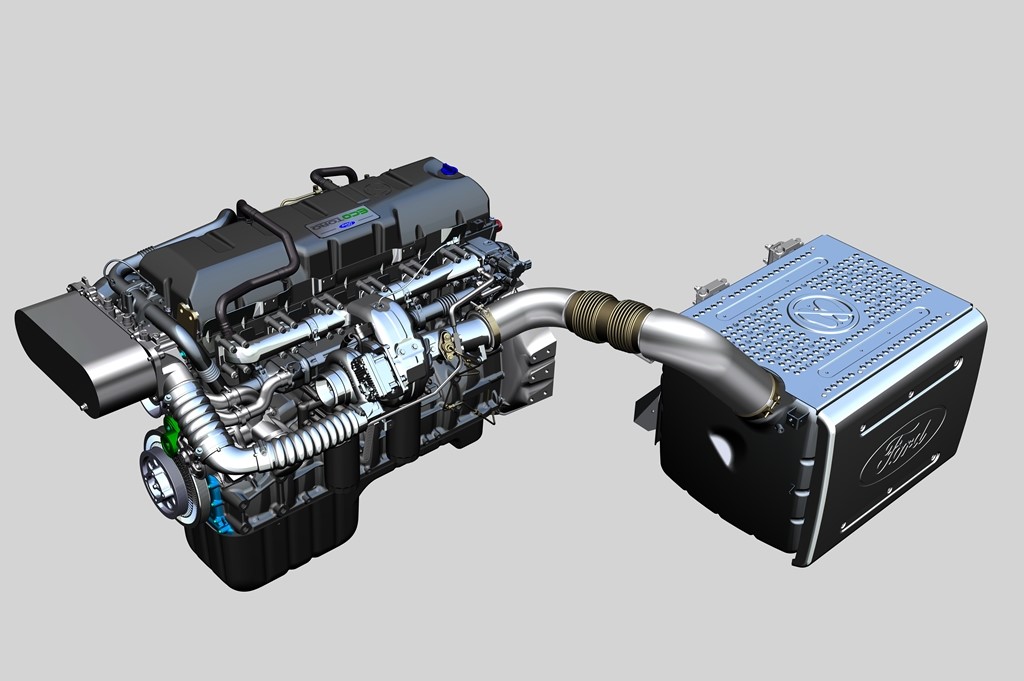 Ford EcoTorq Diesel Cargo Engine with Exhaust Treatment.
Ford EcoTorq Diesel Cargo Engine with Exhaust Treatment.
Developed entirely by Turkish engineers in as little as four years, the new generation Ecotorq Eu6 engine family won the Grand Prize at the Technology Awards organized by Turkish Scientific and Technological Research Council (TUBITAK), the Technology Development Foundation of Turkey (TTGV), and the Turkish Industry and Business Association (TUSIAD).
"The New generation Ecotorq family, launched with an investment of more than $100 million, as the first and only truck engine developed from scratch and made in Turkey, is proof of our technological and R&D strength. The Ecotorq Engine and ATS family – with all intellectual and industrial property rights owned by us – developed to meet the Euro-6 emission norms and to comply with Euro-7, can generate 330, 420 and 480 PS power. The Ecotorq Engine and ATS family tailored for the demands of different export markets have been designed to meet the Euro-3, Euro-5 and Euro-6 emission norms."
Ford Cargo Trucks, equipped with new generation Ecotorq engines, compliant with Euro 7 emission standards have been manufactured in the Eskişehir Plant since 2016.
Marinized versions of the Ecotorq family have been rapidly gaining favor.
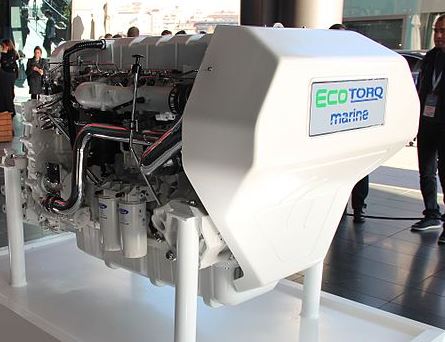 Ford-Otosan EcoTorq Diesel Marine Engine.
Ford-Otosan EcoTorq Diesel Marine Engine.
From FordOtosan.
From Wikipedia..
See our informative Ford Diesel Engine Model Chart by Range & Year.
See our Ford Industrial Power Products Diesel Engines webpage for a more detailed history of the Ford of Britain Diesel Engines.
How to Identify
Ford New Holland “M” + “Brazilian” BSD Series Diesel Engines:
+
+
Ford New Holland "M" + "Brazilian" (BSD Series) Diesel Engines
The BSD Series is a large family of 112 mm (4.4") bore overhead valve engines originally developed in the 1960's by New Holland Machine Company and used in New Holland products, mainly their tractors and combines. The engines were designated the "M" series and produced with 3, 4, and 6 inline cylinders and with various strokes from over-square, to square, to under-square. This allowed the use of the same 3, 4 and 6 cylinder blocks with various crankshafts to produce a wide range of power and torque values with many of the parts being interchangeable. The engines were of the "Parent Bore" type where the pistons are initially fitted directly into the cast-in-block cylinder bores. The extra thick Parent bore cylinders could, if needed due to cylinder wear or scoring, be bored and honed to fit oversized pistons and rings, typically 0.020", 0.030", and 0.040" oversized, Or if needed, the Parent bore cylinders could be bored even more to fit cylinder repair sleeves, typically 4.506", 4.590", and 4.653" Outside Diameter (OD). The thicker repair sleeves could also be bored and honed to fit the oversized pistons if need be. The capability of replacing the repair sleeves when needed gave this engine the potential of being rebuilt over and over again indefinitely. The exhaust manifold was located on the opposite side of the engine to the intake manifold. This is called a crossflow head. This family of engines were favorably received and have broadly earned praise for their durability and dependability. They were initially marketed by New Holland to other OEMs, and later marketed through a joint venture with Ford by Ford Power Products for industrial and marine service as the BSD series. These base engines were marinized by Beta, Lehman, Mermaid, and Sabre.
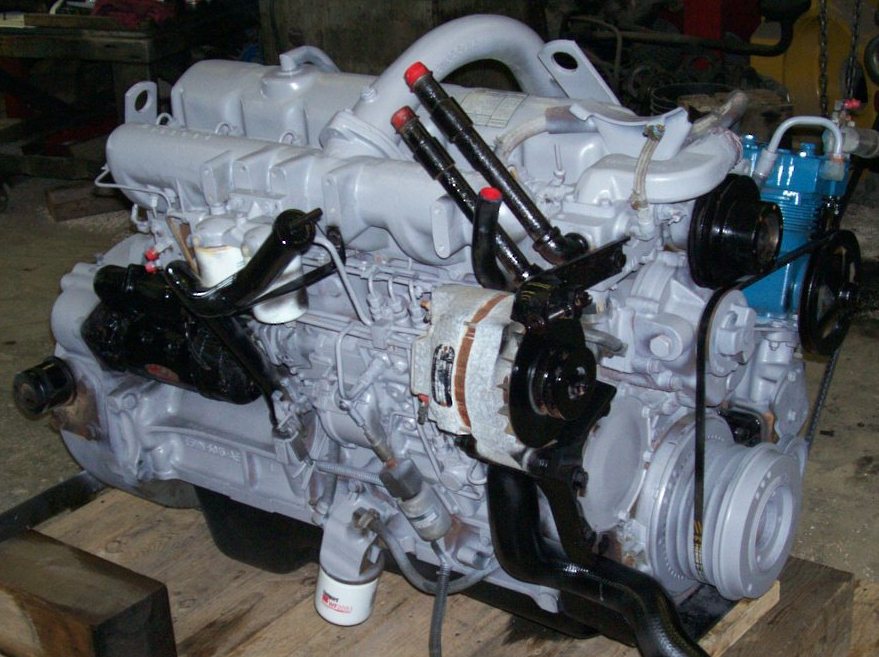
Ford's New Holland of Brazil 7.8 Litre Inline 6.
Ford expanded its tractor business when it purchased the Sperry-New Holland skid-steer loader and hay baler, hay tools and implement company from Sperry Corporation in 1985 and formed Ford-New Holland with the tractor plant located northeast of Dagenham in Basildon, UK (see Fordson in Wikipedia).
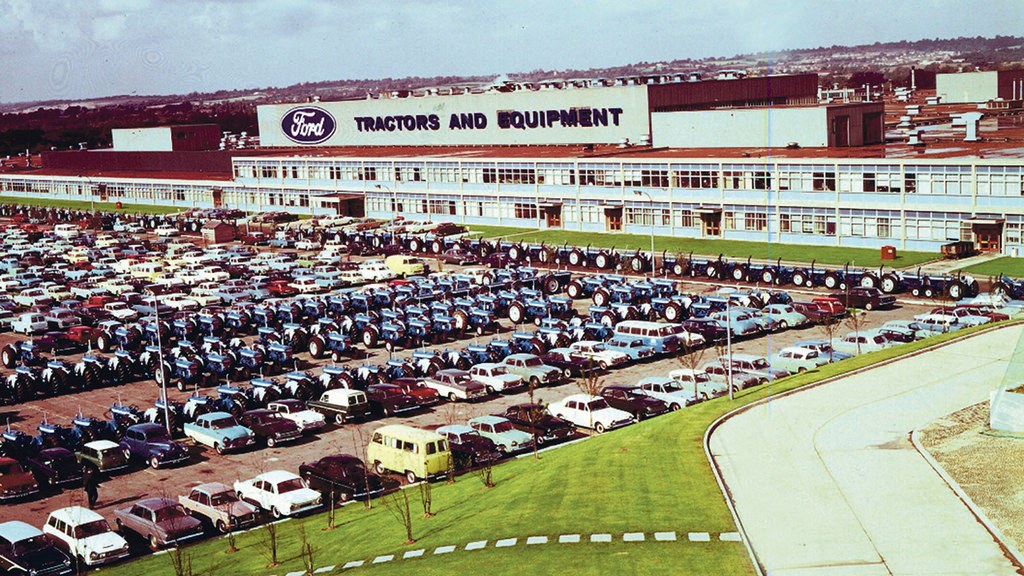
Ford's New Holland Tractor Plant in Basildon, UK.
After Ford acquired New Holland in 1985, Ford offered turbocharged versions of the New Holland 6.6L and the 7.8L engine in their Medium Duty F-600, F-800 and F-900 trucks, and in the Ford B series cowled bus chassis (an F series derivative). While the engines were officially the Ford-New Holland 6.6L and Ford-New Holland 7.8L, they are popularly known as the Ford "Brazilian" diesels as they were actually produced by New Holland of Brazil, and acquired through a joint-venture between New Holland of Brazil and Ford. The engines were well received for their durability and dependability, albeit somewhat under-powered. Ford stopped offering these engines in their trucks and buses at the end of the 1994 model year in favor of the more advanced engine designs of the Cummins 5.9L B-series and 8.3L C-series straight-six diesels that Ford had started phasing in back in 1992.
From DieselHub.com.
It's unfortunate that these New Holland engines were never developed to their full potential. The Cummins engines were simply cheaper and Ford could make more profit reselling them then marketing the more expensive, much heavier and more robust New Holland engines. Maybe, they were too good, to reliable, too expensive (initially), and ultimately too rebuildable to exist in our profit driven throw-away world.
In 1991, Ford exited the tractor manufacturing business altogether when it sold New Holland to Fiat. Fiat began phasing out the Ford engines and phasing in their own engines as they also began phasing out the Ford name which they completed by the year 2000. However, Ford was able to continue sourcing the BSD series vehicle and industrial engines from Case New Holland until 1994? and New Holland of Brazil until 1994?.
See our informative Ford Diesel Engine Model Chart by Range & Year.
See our Ford Industrial Power Products Diesel Engines webpage for a more detailed history of the Ford of Britain Diesel Engines.
How to Identify
Ford Case New Holland “Genesis” 5.0L & 7.5L Diesel Engines
+
+
Ford Case New Holland "Genesis" Diesel Engines
(1991∼2003?)
The Ford-Case-New Holland "Genesis" Series diesel engines were a North American tractor engine developed at the Ford Tractor facility in Troy, Michigan. Shortly after Ford purchased New Holland from Sperry Corporation, all tractor-related activities moved from Michigan to New Holland, PA. The Genesis engines were produced at ΞPlantΞ between 1991 and 2003. From 1991? to 2003? they were sourced by Ford Power Products from Ford Case New Holland and marketed to other parties for other applications. They were available in overhead valve 4-cylinder 5.0 Liter and 6-cylinder 7.5 Liter inline configurations. They gained a wide acceptance as reliable engines. They were marinized primarily by Mermaid Marine and offered in several versions up to 400 horsepower for marine propulsion.
See our informative Ford Diesel Engine Model Chart by Range & Year.
See our Ford Industrial Power Products Diesel Engines webpage for a more detailed history of the Ford of Britain Diesel Engines.
How to Identify
Ford “Kent” Petrol Engines Dieselized by Watermota
+
+
Ford "Kent" Petrol Engine Dieselized by Watermota
(Sea Panther)
(1975?∼1978?)
The robust Ford "Kent" petrol engine had been the bases for the petrol racing engines made famous by Cosworth and Lotus. (Ford restarted production of the "Kent" A711M cylinder block in 2010 due to the extraordinary demand from the auto racing community).
More from Wikipedia.
Through the 60's and 70's, Watermota had been marinizing the Ford "Kent" petrol engine series (used in the Ford Anglia, Cortina, Escort, Pinto, etc.) and had been successfully marketing them for marine service as the Watermota Sea Wolf, Sea Otter, Sea Tiger and Sea Leopard as shown below:
Pre-Crossflow Petrol Engine:
^ Sea Wolf Mk1 - Ford 997cc (?ci) 105E
^ Sea Otter - Ford ?cc (?ci) 115E
^ Sea Tiger Mk1 - Ford 1500cc (?ci) 122E
Crossflow Petrol Engine:
^ Sea Wolf Mk2 - Ford 1100cc (67ci) 2261 KSG-411?.
^ Sea Tiger Mk2 - Ford 1600cc (98ci) 2264 KSG-416.
^ Sea Leopard - Ford ?cc (?ci) 2265 KSG-4??.
Watermota also marinized the Ford side valve based 93A and 100E petrol engines.
By the mid 70's, Watermota had, in collaboration with Ford and Essex University, developed the cylinder head, pistons, fuel injectors, diesel injection pump, pump drive, etc. to convert the Ford Kent 1.6L (1600cc) petrol engine with the robust A711M* block to burn diesel fuel. Watermota marketed this engine as the Sea Panther Mk 2. Westerbeke sourced this dieselized engine from Watermota and marketed it as the Westerbeke L-25.
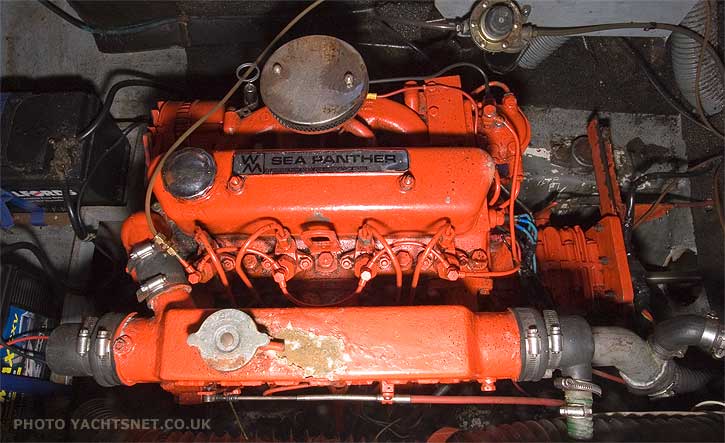
Watermota Sea Panther Diesel Engine (Dieselized from Ford Kent Petrol Engine).
Watermota also marinized the Ford 2715E? & 2725E? base engines and marketed them as the Sea Ranger? & Sea Lion? with 120? & 125? horsepower respectively.
See our informative Ford Diesel Engine Model Chart by Range & Year.
See our Ford Industrial Power Products Diesel Engines webpage for a more detailed history of the Ford of Britain Diesel Engines.
How to Identify
Ford “York” Series 2400 & FSD Range Diesel Engines
+
+
Ford "York" Series Diesel Engines
2400 Range (1972∼1984) & FSD Range (1984∼1999)
(Ford Transit)
The Ford "York" engine is an inline Ford diesel engine originally fitted in vehicles such as the London Taxis and the Ford Transit range of vans between 1972 and 1984. The Transit was fitted with the 2.4-litre four-cylinder engine, but the engine was also available as a 3.5-litre six-cylinder engine. These were fitted in the Ford "A" series light commercial vehicles. Both the four-cylinder and the six-cylinder engines were also available as 2400 Series industrial engines and were marinized by Fenwick and Lees. They were indirect injected until 1984 when they were redesigned. The new "York" 2.5-litre DI (direct-injection) engine was a milestone in reliability, with engines commonly reaching 250,000 miles in automotive use without overhaul. The industrial (FSD 425, also called FSD425) version was marinized by Mermaid and Lancing Marine for marine service even after Ford ceased production of the model in 1999 until engine stocks were exhausted. Used FSD 425 engines are still being marinized by Lancing Marine.
See our informative Ford Diesel Engine Model Chart by Range & Year.
See our Ford Industrial Power Products Diesel Engines webpage for a more detailed history of the Ford of Britain Diesel Engines.
How to Identify
Ford “LT” & “Lynx” ⇒ “Endura-D” Series XLD & DLD Range Diesel Engines
+
+
Ford "LT" & "Lynx" ⇒ "Endura-D" Series (1984∼) XLD & DLD Range
(Ford Fiesta & Ford Transit Connect)
XLD-416
The Ford LT engine (sometimes referred to as the "Dagenham" for the Ford plant where it was produced) is a 1.6 litre inline-four diesel engine used in the Ford Escort as well as its Orion and Escort Van derivatives. It was also installed in the Ford Fiesta Mark 2. This "Dagenham" engine should not be confused with the much earlier Fordson 4D series "Dagenham" tractor engine introduced in 1952 and built at Ford's Dagenham plant.
The LT was designed from the beginning exclusively to be a diesel engine, eliminating any compromises required for a design also intended to run on petrol. It was built exclusively at the Ford Dagenham plant. Design work was carried out with the help of German diesel specialists Deutz, who already had a relationship with Ford in providing engines for the heavier-duty Ford Cargos. Output is 40 kW (54 PS; 54 hp) at 4800 rpm. The crankshaft has five bearings and the glow plugs were of the quicker in-cylinder type, reducing pre-heating times to between 7 and 12 seconds depending on the outside temperature.
More from Wikipedia.
XLD-418
The Endura-DE was Originally branded "Lynx" and had "1.8 DIESEL" stamped on its rocker cover, it is an engine which has been featured in the Ford range since the late 1980s in models such as the Mk 3 Fiesta, Mk 4 Ford Escort (Europe), Ford Sierra, and Mk 1 Ford Mondeo. The 1.8 itself was a development of the (then all-new) LT 1.6L Diesel unit, originally first featured in the Mk 3 Ford Escort and Mk 2 Fiesta.
Still branded Lynx, later engines had Endura-DE stamped on the rocker cover, and first featured in the Mk 4 Ford Fiesta, Mk 6 Ford Escort (Europe) and Mk 2 Ford Mondeo
The Endura-DE engine features a cast iron block and indirect injection style cylinder head, which means there is a combustion chamber built into the cylinder head. This engine makes use of aluminium for some other components to minimise the weight penalty of the Diesel engine. It has a single overhead camshaft opening eight valves via shim-and-bucket followers. The camshaft is rotated by a toothed belt driven by a toothed sprocket on the Crankshaft, likewise the fuel injection pump is rotated by a second toothed belt driven from the crankshaft. The diesel injection pump is a rotary distributor type most typically made by Lucas CAV.
For Ford Fiesta and some Ford Escort (Europe) (typically commercial and base model applications) the Endura-DE engine was a normally aspirated engine producing 60 PS (44 kW; 59 hp). The naturally aspirated engine was also offered in the Indian Ford Ikon from 2003 to 2008. However, for other Ford Escort (Europe) the Endura-DE also featured a turbocharger producing 70 PS (51 kW; 69 hp) and some models and the Ford Mondeo also had an intercooler and these produced 90 PS (66 kW; 89 hp).
A redesign of the engine around 1998 saw it become the Endura-DI, it always features a turbocharger and produces 75 PS (55 kW; 74 hp) when found in Mk.4 Ford Fiesta and Ford Transit Connect models. The addition of an intercooler increases power output to 90 PS (66 kW; 89 hp) for use in the Ford Focus
The Endura-DI engine features a cast iron block and direct injection style cylinder head, which means the combustion chamber is in the top of the piston crown. This engine makes use of aluminium for many other components to minimise the weight penalty of the Diesel engine. It has a single overhead camshaft opening 8 valves via shim-and-bucket followers, and the camshaft is driven by a toothed belt which is driven from a sprocket on the diesel injection pump; unusually this pump is driven via Gemini (twin) chains from the crankshaft. The diesel injection pump is an electronically controlled rotary distributor type most typically made by Bosch.
It has a number of improvements over the previous generation of Ford diesel engines, including the electronically controlled fuel injection pump otherwise known as "fly-by-wire". In addition, the traditional oil sump is replaced with a cast aluminium lower crankcase and a shallow oil pan; there is an oil-to-water cooler, and a great many detail improvements to parts throughout. The engine has been a noted good performer and is a smoother, more powerful unit than the one it replaced.
More from Wikipedia.
See our informative Ford Diesel Engine Model Chart by Range & Year.
See our Ford Industrial Power Products Diesel Engines webpage for a more detailed history of the Ford of Britain Diesel Engines.
How to Identify
Ford ⇐ PSA (Peugeot) XD Series ⇐ Indenor XDP Range Diesel Engines
+
+
Ford ⇐ PSA (Peugeot) XD Series ⇐ Indenor XDP Range
(1972?∼2003?)
The Ford-PSA-Peugeot XD series of diesel engines was sourced by Ford from Indenor through PSA Groupe's PSA PowerTrain (Formerly Peugeot Citroën Moteurs). PSA had marketed the XDs very successfully to power several brands of generators, tractors, light trucks and automobiles including their own very popular Peugeot 504 series of vehicles (with XD90). In turn, Ford not only used these engines in their own vehicles such as the European Ford Granada, but Ford also supplied these engines to its subsidiaries, including Jaguar, Volvo, and Land Rover. Ford also supplied these engines through Ford Power Products to DNT, Lehman, Stratos, Vetus, and Volvo Penta where they were marinized and resold to mainly new boat builders.
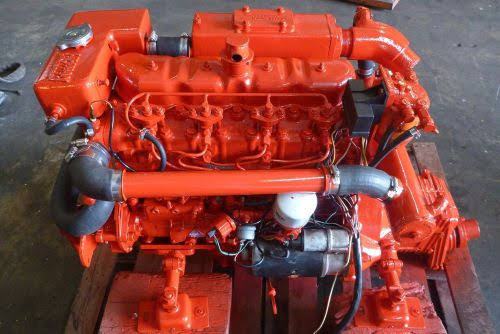
Lehman 4D61 marinized from PSA (Peugeot) XD90 diesel engine like used in the Peugeot 504 automobile.
The XDs came in several 4 cylinder inline Displacements including 1.9L, 2.1L & 2.5L. The 1.9L had a bore of 88mm and was designated the XD88. The base engine for the marinized Volvo Penta MD21A, the 2.1L (2112cc) XD90 had a bore of 90mm. Indenor, who designed this series used slightly different model designations in their production, the XDP 4/88 & XDP 4/90 respectively. The 2.5L engine retained the same stroke as the XD90 but gained a larger bore of 93mm. The XD engines were also produced in six-cylinder inline versions like the XDP 6/90 which was used as the base engine for the Volvo Penta MD31. All these engines came in several versions depending on their application (Agriculture, Automotive, Industrial & Power Generation) each with its own rating. Due to the popularity and commonality of these engines, most parts are readily available from numerous sources, including the various OEM's where they were fitted into tractors, generators, light trucks, automobiles, and boats.
From Wikipedia/Groupe PSA.
From Wikipedia/List of PSA Engines.
See our informative Ford Diesel Engine Model Chart by Range & Year.
See our Ford Industrial Power Products Diesel Engines webpage for a more detailed history of the Ford of Britain Diesel Engines.
How to Identify
Ford ⇐ PSA (Peugeot-Citroën) XUD Range Diesel Engines
+
+
Ford ⇐ PSA (Peugeot-Citroën) XUD Range
(1982∼2003?)
The PSA XUD is a diesel engine designed and built by PSA - Peugeot and Citroën. It is an Indirect injection (IDI) engine, that uses a version of the Ricardo Consulting Engineers Ricardo Comet V prechamber cylinder head design. The engine comes in 1.8 L (1,769 cc), 1.9 L (1,905 cc), and 2.1-liter displacments. The 2.1 has 12 valves, all displacements were built either naturally aspirated or turbocharged. The XUD was the predecessor to the HDI range of engines. Early HDi Engines were a PSA design, later 16-valve engines were jointly developed with Ford.
The XUD was available with either SOHC 8-valve or 12-valve heads. It was mainly applied transversally in front wheel drive vehicles, tilted by 30°. However, some applications in non-PSA vehicles had the engine installed longitudinally, with rear-wheel drive. The XUD is built in Citroën's plant in Trémery, near Metz.
Displacement ranges between 1.8 and 2.1 L (1,769 and 2,138 cc), and all XU diesel engines have a stroke of either 88 or 92 mm (3.46 or 3.62 in). The former was shared with the XU9. Bore sizes range from 80 to 86 mm (3.15 to 3.39 in), some of which are shared with other XU engines.
Upon its release the engine was noted as one of the best diesel engines (for cars and light vans) in the world with its high power output and refinement it made all other diesel engines seem agricultural. It was also particularly light, with a ready-to-run XUD9 weighing 157 kg (346 lb), 15% less than a comparable diesel of the previous generation.
Vegetable oil fuel:
The engine, because it is indirect injection, with a slower combustion burn time than direct injection, is suitable to run on SVO (pure vegetable oil). A feature of the Ricardo Comet pre-chamber design is that it makes the engine tolerant of low Cetane value fuels such as SVO. The viscosity of vegetable oil when cold is too great for rotary injection pumps, (in particular the weaker Lucas CAV pump, the Bosch VE fuel pump is superior), preventing it from acting as a lubricant and increasing the workload on the distributor/rotary injection pump and damaging it. The Lucas EPIC pump fitted to the 2.1 L 12 valve turbo-diesel engine after 1995 is the weakest pump of all.
Features:
Horizontal Crankshaft, Removable "Wet" Cylinder liners
and IDI (indirect injection) Ricardo Comet V in head precombustion swirl chambers.
XUD engines were built at PSA-Peugeot-Citroën Site de Trémery near Metz, France.
From Wikipedia/PSA_XUD_Engine.
From Wikipedia/List of PSA Engines.
See our informative Ford Diesel Engine Model Chart by Range & Year.
See our Ford Industrial Power Products Diesel Engines webpage for a more detailed history of the Ford of Britain Diesel Engines.
How to Identify
Ford “DuraTorq” Series ZSD & TDCi Range Diesel Engines
+
+
Ford "DuraTorq" Series (1999∼?) ZSD & TDCi Ranges
(Puma+) — (Ford Transit)
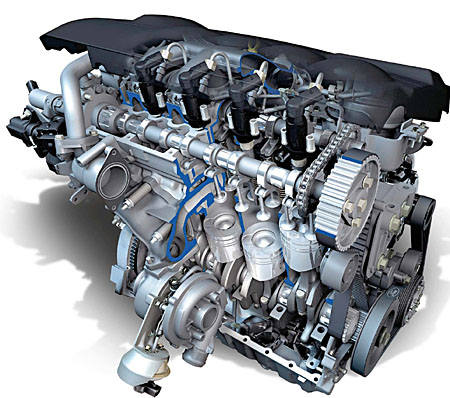
Ford Duratorq Diesel Engine.
In 1998, Ford entered into a joint venture with PSA (Peugeot-Citroën) to produce a range of new diesel engines. The joint venture makes identical engines which are fitted to a variety of vehicles from a wide range of car manufacturers. The engines are assembled in production plants in the cities of Trémery and Douvrin for PSA in France, at the Ford Dagenham plant in the UK, In the Ford-Otosan plant in Turkey and the Volvo Engine Plant in Skövde Sweden (that is when Volvo was still under Ford ownership). Ford fits these new engines into their popular Ford Transit line of vehicles as well as offering them for off-road applications including marine service. Mermaid is the primary marinizer of these engines. Like the earlier PSA developed XD diesel engines, these new engines have also been assembled and utilized by Mahindra in India. Mahindra has in turn supplied these engines to other OEM's around the globe for agricultural, Industrial and automotive applications. By volume, not only is Mahindra one of the largest vehicle manufacturers in India, it is the largest manufacturer of tractors in the world.
Through the years, Dagenham has been the primary plant producing most of the Ford of Britain's diesel engines such as the 4D, 6D and 2700+ series. Most recently the PT22, PT24 and PT32 were produced there. These engines were the marine versions developed from the Ford "Transit" lorry's Puma DuraTorq ZSD-422 (2005-), ZSD-424 (2007-) and DuraTorq TDCi 3.2 (2006?-) respectively. These engines were designed and put into production by a joint-venture between Ford and PSA Groupe that includes Peugeot, Citroën & Indenor (see Ford-PSA in the two sections above). In marine service however, these much lighter high-speed engines are not likely to achieve the avid following of their much heavier and more durable predecessors.
See our informative Ford Diesel Engine Model Chart by Range & Year.
See our Ford Industrial Power Products Diesel Engines webpage for a more detailed history of the Ford of Britain Diesel Engines.

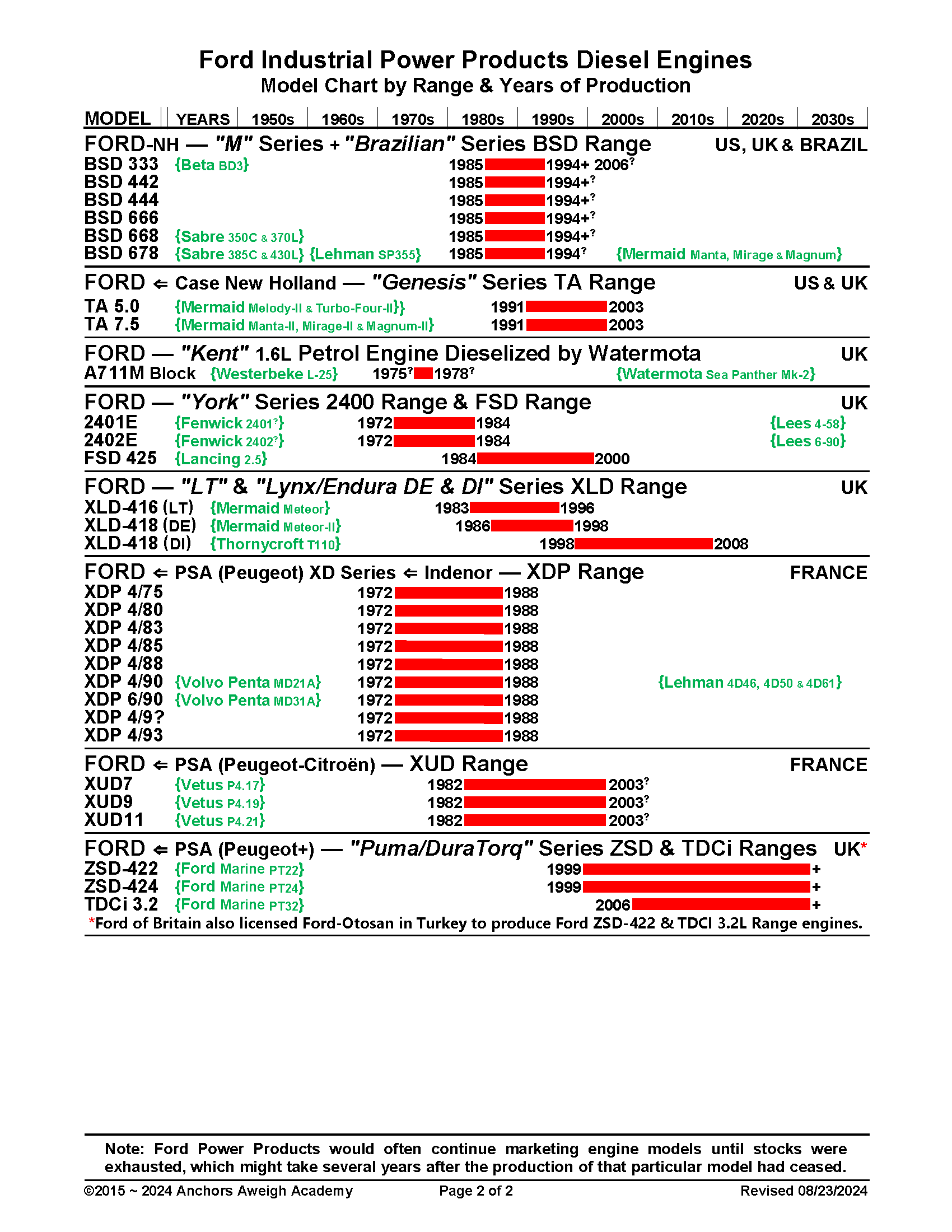
This Document is available to Academy members to download and print.
CLICK HERE and when the document webpage opens in a new window,
scroll down to ACADEMY eLIBRARY Section for links and Instructions.
Product Documentation
Documentation with Bold Titles are part of our Academy eLibrary!
To view the entire document, click on its Bold Title Link to go to our webpage for
that item and then scroll down to the "Academy eLibrary" section on that page for link.
⇐ (arrow) = Document Creator is the vendor shown at the beginning of the title.
DS = Data Source for listed specifications.
Product Documentation Contents with QuickLinks
⇒ Catalogs:
⇒ Brochures:
⇒ Ads: (Print Advertisements)
⇒ AdVids: (Advertisement Videos)
⇒ SpecSheets: (Specification Sheets‚ Data Sheets‚ FactSheets)
⇒ Charts and Graphs: (Power & Torque Curves)
⇒ Pictures:
⇒ Patents:
⇒ Press Releases: (by Date: YYMMDD).
⇒ Model History:
⇒ Serial Number Guides: (Date of Manufacture‚ Date Codes‚+)
⇒ Installation Instructions:
⇒ Installation Drawings: (with Dimensions).
⇒ OpManuals: (Owner's/Operator's Handbooks/Manuals)
⇒ Parts Catalogs: (with Exploded Views & Parts Lists)
⇒ Parts Bulletins: (by Date: YYMMDD).
⇒ Shop Manuals: (Repair/Service/Technical/Workshop Manuals)
⇒ Wiring Diagrams:
⇒ TechVids: (Technical Videos: Service Training‚ etc.)
⇒ Service Bulletins: (by Date: YYMMDD).
⇒ Safety Data Sheets: (Material SDS‚ Pathogen SDS‚+)
⇒ Product Recalls:
⇒ Other Documentation:
ALL Documentation we have for the Ford Industrial Power Products diesel models are included here as there are many similarities between the various models and therefore a significant amount of information can be gleaned from the documentation covering these other models.
| DOCUMENTATION TYPE: (Notes) - Listed by Ascending Base Engine | |
| DOCUMENT TITLE - Products (Notes) — Creators – Sources | DS |
| Catalogs: | ↓c↓ |
| ΞVendorΞ Catalog – ΞProductsΞ (ΞNotesΞ) — ΞCreatorΞ – ΞSourceΞ | –c– |
| Lancing Marine Catalog - 2023 (All Lines) | Lc"23 |
| Lancing Catalog SpecSheet - FSD 2.5L 51hp‚ 61hp‚ 75hp (Ford FSD 425) | Ls1 |
| Lancing Catalog Specsheet - FSD 2.5L 65hp (Ford FSD 425) | Ls2 |
| Lehman Catalog - #28 ©1957 (Lehman was not marinizing Ford diesels yet) | Lc'28 |
| Lehman Catalog - #69A ©1969 (see Catalog Supplement next below for Ford Diesels) | Lc'69 |
| Lehman Catalog - #69A? Ford Diesel Supplement ©1969? (see Lehman Catalog #69A Pg 9) (incl. complete new marinized engines‚ marinizing kits‚ separate components‚+) | Lc'69s |
| Brochures: | ↓b↓ |
| ΞVendorΞ Brochure – ΞProductsΞ (ΞNotesΞ) — ΞCreatorΞ – ΞSourceΞ | –b– |
| Ford Brochure - PT22‚ PT24‚ PT32 Marine Engines (Ford-PSA ZSD-422‚ ZSD-424‚ TDCi 3.2) | Fb9? |
| Lees Brochure - Powering the Nation Afloat (15hp∼250hp) | Lb1 |
| Sabre Brochure - Engines for Leisure - 90L‚ 134L‚ 185L‚ 190L‚225L‚ 275L‚ 320L‚ 370L‚ 430L (Ford Dover & Ford-NHB "Brazilian") | SbL. |
| Sabre Brochure - Power for Professionals - 80C‚ 120C‚ 160C‚ 180C‚ 212C‚ 255C‚ 280C‚ 350C‚ 385C (Ford Dover & Ford-NHB "Brazilian") | SbC. |
| Ads: (Print Advertisements) | ↓a↓ |
| ΞVendorΞ Ad - ΞProductsΞ (ΞNotesΞ) — ΞCreatorΞ – ΞSourceΞ | –a– |
| Ford Ad - 220 & 330 (4D & 6D) Diesel Engines (1958) | Fa1 |
| Ford Ad - 590T Turbocharged (6D) Diesel Engine (1958) | Fa2 |
| Couach Ad - DF 4 (Ford 2701E) & DF 6 (Ford 2703E) — Couach | Ca? |
| AdVids: (Advertisement Videos) | ↓av↓ |
| ΞVendorΞ AdVids - ΞProductsΞ (ΞNotesΞ) — ΞCreatorΞ – ΞSourceΞ | –av– |
| SpecSheets: (Specification Sheets‚ Data Sheets‚ FactSheets) | ↓s↓ |
| ΞVendorΞ SpecSheet - ΞProductsΞ (ΞNotesΞ) — ΞCreatorΞ – ΞSourceΞ | –s– |
| FORD "Dagenham" 4D & 6D (1952∼1965) & EBRO 4D (1965∼1999?) | |
| Ford SpecSheet - 4D Agricultural (Ford E1A) | Fs? |
| Ford SpecSheet - 4D Automotive (Ford ET? 530E?) | Fs? |
| Ford SpecSheet - 4D Industrial (Ford 562E) | Fs? |
| Ford SpecSheet - 4D Industrial (Ford 954E) | Fs? |
| Ford SpecSheet - 4D Mark-2 Agricultural (Ford E1A?) | Fs? |
| Ford SpecSheet - 4D Mark-2 Automotive (Ford 530E) | Fs? |
| Ford SpecSheet - 4D Mark-2 Industrial (Ford 592E) | Fs1 |
| Ford SpecSheet - 6D Mark-2 Automotive (Ford 510E) | Fs? |
| Ford SpecSheet - 6D Mark-2 Industrial (Ford 590E) | Fs1 |
| EBRO SpecSheet - 4D Mark-2 (Ford 4D Mk2) | Es? |
| FORD "Dorset" 2700 Early (1965∼10/69) w/2704ET (1968∼1981) | |
| Ford SpecSheet - 2701E | Fs? |
| Ford SpecSheet - 2703E | Fs? |
| Ford SpecSheet - 2704E | Fs? |
| Ford SpecSheet - 2704ET | Fs? |
| Ford SpecSheet - 2704ET (After 1969) | Fs? |
| Ford SpecSheet - 2706E | Fs? |
| Ford SpecSheet - 2708E | Fs? |
| Ford SpecSheet - 2709E | Fs? |
| FORD "Dorset" 2700C Early-to-Late Transition (11/69-10/70) | |
| Ford SpecSheet - 2701C | Fs? |
| Ford SpecSheet - 2703C | Fs? |
| Ford SpecSheet - 2704C | Fs? |
| FORD "Dorset" 2710 Late (11/70-1981) | |
| Ford SpecSheet - 2711E | Fs? |
| Ford SpecSheet - 2712E | Fs? |
| Ford SpecSheet - 2713E | Fs? |
| Ford SpecSheet - 2714E | Fs? |
| Ford SpecSheet - 2715E | Fs? |
| FORD "Dover" 2720 (1982-1991?) & Ford-Otosan "DoverTech" (1986-2010) | |
| Ford SpecSheet - 2722 | Fs? |
| Ford SpecSheet - 2723 | Fs? |
| Ford SpecSheet - 2725 | Fs? |
| Ford SpecSheet - 2726T | Fs? |
| Ford SpecSheet - 2726TG | Fs? |
| Ford SpecSheet - 2728T | Fs? |
| Ford SpecSheet - 2728Ti | Fs? |
| Ford-Otosan SpecSheet - 2725 (Ford 2725) | Fs? |
| Ford-Otosan SpecSheet - 2728? (Ford 2726T) | Fs? |
| Ford-Otosan SpecSheet - 2728T (Ford 2728T) | Fs? |
| Ford-Otosan SpecSheet - 2728TIM (Ford 2728TIM) | Fs? |
| FORD-NHB "Brazilian" BSD Range (1985?-1994?) (Built by New Holland of Brazil) | |
| Ford-NHB SpecSheet - BSD 333 | Fs? |
| Ford-NHB SpecSheet - BSD 442 | Fs? |
| Ford-NHB SpecSheet - BSD 444 | Fs? |
| Ford-NHB SpecSheet - BSD 666 | Fs? |
| Ford-NHB SpecSheet - BSD 668 | Fs? |
| Ford-NHB SpecSheet - BSD 678 | Fs? |
| FORD-CNH "Genesis" (1991?-2003?) (Built by Case New Holland in USA) | |
| Ford-CNH SpecSheet - CNH 5.0L | Fs? |
| Ford-CNH SpecSheet - CNH 7.5L | Fs? |
| FORD "Kent" Petrol Engine Dieselized by Watermota (1975?-1978?) | |
| Ford SpecSheet - Ford "Kent" 1600 (Ford KSG416) | Fs? |
| Watermota SpecSheet - Sea Panther Mk-2 (Ford "Kent" 1600) | Fs? |
| Westerbeke SpecSheet - L-25 (Ford "Kent" 1600 Petrol engine Dieselized by Watermota) | Ws |
| FORD "York" Series 2400 & FSD Ranges (1972-1999) | |
| Ford SpecSheet - York 2401E | Fs? |
| Ford SpecSheet - York 2402E | Fs? |
| Ford SpecSheet - FSD 425 | Fs? |
| FORD “LT” &" Lynx"⇒“Endura-D” Series XLD & DLD Range (1984-2008) | |
| Ford SpecSheet - XLD-416 | Fs? |
| Ford SpecSheet - XLD-418 | Fs? |
| FORD⇐PSA (Peugeot) XD Series⇐Indenor XDP & Mahandra (1972?-2003?) | |
| Ford SpecSheet - PSA XD75 | Fs? |
| Ford SpecSheet - PSA XD80 | Fs? |
| Ford SpecSheet - PSA XD85 | Fs? |
| Ford SpecSheet - PSA XD88 | Fs? |
| Ford SpecSheet - PSA XD90 (4cyl) | Fs? |
| Ford SpecSheet - PSA XD90 (6cyl) | Fs? |
| Ford SpecSheet - PSA XD9? | Fs? |
| Ford SpecSheet - PSA XD93? | Fs? |
| Indenor SpecSheet - XDP 4/75 | Is? |
| Indenor SpecSheet - XDP 4/80 | Is? |
| Indenor SpecSheet - XDP 4/85 | Is? |
| Indenor SpecSheet - XDP 4/88 | Is? |
| Indenor SpecSheet - XDP 4/90 | Is? |
| Indenor SpecSheet - XDP 6/90 | Is? |
| Indenor SpecSheet - XDP 4/9? | Is? |
| Indenor SpecSheet - XDP 4/93? | Is? |
| Mahandra SpecSheet - XD75 | Ms? |
| Mahandra SpecSheet - XD80 | Ms? |
| Mahandra SpecSheet - XD85 | Ms? |
| Mahandra SpecSheet - XD88 | Ms? |
| Mahandra SpecSheet - XD90 (4cyl) | Ms? |
| Mahandra SpecSheet - XD90 (6cyl) | Ms? |
| Mahandra SpecSheet - XD9? | Ms? |
| Mahandra SpecSheet - XD93? | Ms? |
| Peugeot SpecSheet - XD75 | Ps? |
| Peugeot SpecSheet - XD80 | Ps? |
| Peugeot SpecSheet - XD85 | Ps? |
| Peugeot SpecSheet - XD88 | Ps? |
| Peugeot SpecSheet - XD90 (4cyl) | Ps? |
| Peugeot SpecSheet - XD90 (6cyl) | Ps? |
| Peugeot SpecSheet - XD9? | Ps? |
| Peugeot SpecSheet - XD93? | Ps? |
| FORD⇐PSA (Peugeot-Citroën) XD Series (?-?) | |
| Peugeot SpecSheet - XD2 | Ps? |
| Peugeot SpecSheet - XD3 | Ps? |
| FORD⇐PSA (Peugeot-Citroën) XUD Series (1982-2003?) | |
| Ford SpecSheet - PSA XUD7 | Fs? |
| Ford SpecSheet - PSA XUD9 | Fs? |
| Ford SpecSheet - PSA XUD11 | Fs? |
| FORD-PSA "DuraTorq" Series ZSD & TDCi Ranges (1999-2003?) | |
| Ford SpecSheet - Ford ZSD-422 | Fs? |
| Ford SpecSheet - PT22 (ZSD-422) | Fb9? |
| Ford SpecSheet - Ford ZSD-424 | Fs? |
| Ford SpecSheet - PT24 (ZSD-424) | Fb9? |
| Ford SpecSheet - Ford TDCi 3.2 | Fs? |
| Ford SpecSheet - PT32 (TDCi 3.2) | Fb9? |
| MARINIZERS & MARKETERS: ♦ ♦ ♦ ♦ ♦ ♦ ♦ ♦ ♦ ♦ ♦ ♦ ♦ ♦ ♦ ♦ ♦ ♦ ♦ ♦ ♦ | |
| American Diesel Corp. (Bob Smith) | |
| ADC SpecSheet - 4N91 (Ford 2722) | As? |
| ADC SpecSheet - 6N120 (Ford 2725) | As? |
| ADC SpecSheet - 6N125 (Ford 2725) | As? |
| ADC SpecSheet - 6N130 (Ford 2725) | As? |
| ADC SpecSheet - 6N136 (Ford 2725) | As? |
| ADC SpecSheet - 6N140 (Ford 2725) | As? |
| American Marine (Grand Banks) | |
| AmMarine SpecSheet - 254? (Ford 2711E) | As? |
| AmMarine SpecSheet - 380? (Ford 2714E) | As? |
| Barr Marine | |
| Barr SpecSheet - BD4 (Ford 2722) | Ps? |
| Beta Marine | |
| Beta SpecSheet - ? (Ford ?) | Bs? |
| Beta SpecSheet - BD6 (Ford 2725) | Ps? |
| Beta SpecSheet - BD3 (Ford BSD 333) | Ps? |
| Beta SpecSheet - BD8 (Ford BSD 678) | Ps? |
| Bomac Marine Power Corp. | |
| Bomac SpecSheet - ? (Ford ?) | Bs? |
| C-Power | |
| C-Power SpecSheet - 4-90 (Ford? ?) | Cs? |
| C-Power SpecSheet - 4-18 (Ford? ?) | Cs? |
| C-Power SpecSheet - 4-425 (Ford? ?) | Cs? |
| C-Power SpecSheet - 4-425-TCIC (Ford? ?) | Cs? |
| C-Power SpecSheet - 4-450 (Ford? ?) | Cs? |
| C-Power SpecSheet - 4-254 (Ford 2712?) | Cs? |
| C-Power SpecSheet - 6-363-TC (Ford 2704ET?) | Cs? |
| C-Power SpecSheet - 6-363-TCIC (Ford 2704ETi?) | Cs? |
| C-Power SpecSheet - 6/380 (Ford-Otosan 2725) | Cs? |
| C-Power SpecSheet - 6-675 (Ford-CNH 7.5L) | Cs? |
| CT Marine | |
| CT Marine SpecSheet - ? (Ford ?) | Cs? |
| Couach | |
| Couach SpecSheet - DF 4 pêche (="Fishing") (Ford 2701E). | Cs? |
| Couach SpecSheet - DF 4 Plaisance (="Pleasure") (Ford 2701E). | Cs? |
| Couach SpecSheet - DF 6 pêche (="Fishing") (Ford 2703E). | Cs? |
| DNT | |
| DNT - ? (Ford ?) | Ds? |
| EBRO | |
| See FORD EBRO above | |
| EBRO SpecSheet - 4D Mark-2 (Ford 4D Mk2) | Es? |
| Econopower | |
| Econopower SpecSheet - ? (Ford ?) | Es? |
| Fenwick Groupe | |
| Fenwick SpecSheet - ? (Ford ?) | Fs? |
| Hawker Siddeley | |
| Hawker Siddeley SpecSheet - ? (Ford ?) | Hs? |
| Indenor | |
| See FORD-PSA above. | |
| Lancing Marine | |
| Lancing DataBook VI 2018 (All Lines) | Ls |
| Lancing SpecSheet - 2725E‚ET (Ford 2725) | Ls |
| Lancing SpecSheet - FSD 2.5L 51hp‚ 61hp‚ 75hp (Ford FSD 425) | Ls |
| Lancing SpecSheet - FSD 2.5L 65hp (Ford FSD 425) | Ls |
| Lancing SpecSheet - XLD LP 1.8L & XLD 1.8L (Ford XLD-418) | Ls? |
| Lees Marine (Listed by Ascending Base Engine Models & Horsepower) | |
| Lees SpecSheet - Six·250 (Ford 2704ET) | Ls? |
| Lees SpecSheet - Six·150 (Ford 2704ET) | Ls? |
| Lees SpecSheet - Six·180 (Ford 2704ET) | Ls? |
| Lees SpecSheet - Six·215 (Ford 2704ET) | Ls? |
| Lees SpecSheet - Six·250 (Ford 2704ET) | Ls? |
| Lees SpecSheet - Four·63 (Ford 2711E) | Ls? |
| Lees SpecSheet - Four·75 (Ford 2712E) | Ls? |
| Lees SpecSheet - Six·115 (Ford 2715E) | Ls? |
| Lees SpecSheet - Six·120 (Ford 2715E) | Ls1 |
| Lees SpecSheet - Six·135 (Ford 2725) | Ls2 |
| Lees SpecSheet - Six·160 (Ford 2726T) | Ls3 |
| Lees SpecSheet - Six·225 (Ford 2728T) | Ls4 |
| Lehman Mfg. Co. | |
| Lehman SpecSheet - 4D46 (Ford-PSA-Peugeot-Indenor XD90) | Ls? |
| Lehman SpecSheet - 4D50 & 4D61 (Ford-Indenor-Peugeot XD90) | Ls? |
| Lehman SpecSheet - 4D220 (EBRO 4D Mk2‚ Ford 4D‚ 4D Mk2) | Ls? |
| Lehman SpecSheet - 6D330 (Ford 6D Mk2) | Ls? |
| Lehman SpecSheet - 4D242 (Ford 2701E) | Ls? |
| Lehman SpecSheet - 6D330 (Ford 2703E) | Ls? |
| Lehman SpecSheet - 6D363? (Ford 2704E) | Ls? |
| Lehman SpecSheet - 6D363T (Ford 2704ET) | Ls? |
| Lehman SpecSheet - 4D254 (Ford 2701C?‚ 2712E) | Ls? |
| Lehman SpecSheet - 6D380 (Ford 2704C?‚ 2715E) | Ls? |
| Lehman SpecSheet - SD80 Standard (Ford 2722) | Ls? |
| Lehman SpecSheet - SP90 Super (Ford 2722) | Ls |
| Lehman SpecSheet - SD120 Standard (Ford 2725) | Ls? |
| Lehman SpecSheet - SP135 Super (Ford 2725) | Ls |
| Lehman SpecSheet - SP160 Super (Ford 2726T) | Ls? |
| Lehman SpecSheet - SP185 Super (Ford 2726T) | Ls |
| Lehman SpecSheet - SP225 Super (Ford 2728TI) | Ls |
| Lehman SpecSheet - SP275 Super (Ford 2728TIM) | Ls |
| Lehman SpecSheet - SP355 Super (Ford BSD 678) | Ls |
| Mahindra | |
| See FORD-PSA above. | |
| Mermaid Marine (Listed Alphabetically) | |
| Mermaid SpecSheet - 397 80hp (Ford Dorset 2712E 1/70∼12/82) | Ms |
| Mermaid SpecSheet - 595-ET 150hp & INT 180hp (Ford Dorset 2704ET 1/70∼12/82).-+ | Ms |
| Mermaid SpecSheet - 595-ET 210hp (Ford Dorset 2704ET 1/70∼12/82)._+ | Ms |
| Mermaid SpecSheet - 595-TP (Turbo Plus) 250hp (Ford Dorset 2704ET 1/70∼12/82)._+ | Ms |
| Mermaid SpecSheet - Flat-Four 80hp (Ford Dorset 2712E 1/70∼12/82)._+ | Ms |
| Mermaid SpecSheet - Flat-Six 108hp (Con) & 120hp (Int) (Ford Dorset 2715E 1/70-12/82)._+ | Ms |
| Mermaid SpecSheet - Magnum 400hp (Ford BSD 678 5/90∼1993?).-++ | Ms |
| Mermaid SpecSheet - Magnum II 400hp (Ford-CNH Genesis 7.5L 1/95∼2003?).-+ | Ms |
| Mermaid SpecSheet - Majestic 180hp (Ford Dorset 2704ET 1/70∼12/82) | Ms |
| Mermaid SpecSheet - Majestic 188hp (Ford Dover 2726T 1/82∼12/84) | Ms |
| Mermaid SpecSheet - Majestic 200hp (Ford Dover 2726T 1/85∼12/87) | Ms |
| Mermaid SpecSheet - Majestic 212hp (Ford Dover 2726T 1/88∼12/94) | Ms |
| Mermaid SpecSheet - Majestic 212hp (Ford-Otosan 2726T 1/95∼1/00?) | Ms |
| Mermaid SpecSheet - Majestic 212hp (Ford DoverTech 2726T? 2/00∼2008?)._+ | Ms |
| Mermaid SpecSheet - Manta 180hp (Ford BSD 678 5/90∼1993?).-- | Ms |
| Mermaid SpecSheet - Manta II 160hp (Ford-CNH Genesis 7.5L 1/05+).-- | Ms |
| Mermaid SpecSheet - Mariner 120hp (Ford Dorset 2715E 1/70∼12/82)._+ | Ms |
| Mermaid SpecSheet - Mariner 128hp (Ford Dover 2725 1/82∼12/87)._+ | Ms |
| Mermaid SpecSheet - Mariner 135hp (Ford Dover 2725 1/88∼12/94)._+ | Ms |
| Mermaid SpecSheet - Mariner 135hp (Ford-Otosan 2725 1/95∼2/00?)._+ | Ms |
| Mermaid SpecSheet - Mariner 135hp (Ford Dovertech 2725 2/00∼2008+)._+ | Ms |
| Mermaid SpecSheet - Melody 80hp (Ford Dorset 2712E 1/70∼12/82) | Ms |
| Mermaid SpecSheet - Melody 85hp (Ford Dover 2722E 1/82∼12/87) | Ms^ |
| ^Mermaid SpecSheet - Melody 90hp (Ford Dover>Otosan 2722 1/88∼12/94)._+ | Ms |
| Mermaid SpecSheet - Melody-II 90hp (Ford-CNH Genesis 5.0L 1/95∼2003?)._+ | Ms |
| Mermaid SpecSheet - Merlin 70hp (Ford FSD 425 4/87∼1999)._+ | Ms |
| Mermaid SpecSheet - Meteor 54hp (Ford XLD 416 1984∼2008)._+ | Ms |
| Mermaid SpecSheet - Meteor-II 56hp (Ford XLD 418 1984∼2008)._+ | Ms |
| Mermaid SpecSheet - Meteorite 35hp (Ford XLD-416 1984∼2008) | Ms? |
| Mermaid SpecSheet - Mirage 325hp (Ford BSD 678 5/90∼1993?)._+ | Ms |
| Mermaid SpecSheet - Mirage-II 325hp (Ford-CNH Genesis 7.5L 1/95∼2003?)._+ | Ms |
| Mermaid SpecSheet - Mistral 150hp (Ford Dorset 2704ET 1/70∼12/82)._+ | Ms |
| Mermaid SpecSheet - Mistral 160hp (Ford Dover 2726T 1/82∼12/84)._+ | Ms |
| Mermaid SpecSheet - Mistral 175hp (Ford Dover 2726T 1/85∼12/87)._+ | Ms |
| Mermaid SpecSheet - Mistral 185hp (Ford Dover 2726T 1/88∼12/94)._+ | Ms |
| Mermaid SpecSheet - Mistral 185hp (Ford-Otosan 2726T 1/95∼2/00?)._+ | Ms |
| Mermaid SpecSheet - Mistral 185hp (Ford DoverTech 2726T 2/00∼2010?)._+ | Ms |
| Mermaid SpecSheet - Monarch 180hp (Ford Dorset 2704ET 1/70∼12/82)._+ | Ms? |
| Mermaid SpecSheet - Monarch 200hp (Ford Dover 2728TIM 1/82∼12/84)._+ | Ms |
| Mermaid SpecSheet - Monarch 230hp (Ford Dover 2728TIM 1/85∼12/87)._+ | Ms |
| Mermaid SpecSheet - Monarch 250hp (Ford Dover 2728TIM 1/88∼12/94)._+ | Ms |
| Mermaid SpecSheet - Monarch 250hp (Ford-Otosan 2728TIM 1/95∼1/00?)._+ | Ms |
| Mermaid SpecSheet - Monarch 250hp (Ford DoverTech 2728TIM 2/00∼2010?)._+ | Ms |
| Mermaid SpecSheet - PT22 (Ford ZSD-422 1999∼) | Fb9? |
| Mermaid SpecSheet - PT24 (Ford ZSD-424 1999∼) | Fb9? |
| Mermaid SpecSheet - PT32 (Ford Puma TDCi 3.2L 2006∼) | Fb9? |
| Mermaid SpecSheet - Turbo-Four 105hp & 130hp (Ford Dorset 2712E 1/70∼12/82)._+ | Ms |
| Mermaid SpecSheet - Turbo-Four 140hp (Ford Dover 2722 1/82∼12/84).-+ | Ms |
| Mermaid SpecSheet - Turbo-Four 155hp>180hp (Ford Dover 2722 1/85∼12/87).-+ | Ms |
| Mermaid SpecSheet - Turbo-Four 200hp (Ford Dover 2722 1/88∼12/94).-+ | Ms |
| Mermaid SpecSheet - Turbo-Four-II 200hp (Ford-CNH Genesis 5.0L 1995?∼2003?)._+ | Ms |
| Mermaid SpecSheet - Turbo-Melody 145hp (Ford Dover 2722 1/88∼12/94).-+ | Ms |
| Mermaid SpecSheet - Turbo-Melody-II 180hp (Ford-CNH Genesis 5.0L 1995?∼2003?)._+ | Ms |
| Mermaid SpecSheet - Turbo-Merlin 110hp (Ford FSD 425 1984∼1999)._+ | Ms |
| Mermaid SpecSheet - Turbo-Merlin 130hp (Ford? FSD TCM 1984∼1999)._+ | Ms |
| Mermaid SpecSheet - Turbo-Merlin 130hp (Ford? FSD TIM 1984∼1999)._+ | Ms |
| Mermaid SpecSheet - Turbo-Plus 250??hp 275?hp (Ford Dorset 2704ET 1/70∼12/82)._+ | Ms |
| Mermaid SpecSheet - Turbo-Plus 260hp (Ford Dover 2728T 1/82∼12/84)._+ | Ms |
| Mermaid SpecSheet - Turbo-Plus 275hp (Ford Dover 2728T 1/85∼12/87) DRAFT?._+ | Ms |
| Mermaid SpecSheet - Turbo-Plus 275hp (Ford Dover 2728T 1/85∼12/87).-- | Ms |
| Mermaid SpecSheet - Turbo-Plus 300hp (Ford Dover 2728T 1/88∼12/94).-- | Ms |
| Mermaid SpecSheet - Turbo Plus 300hp (Ford-Otosan 2728T 1/95∼2010?) | Ms |
| Northeast Ford Engines Inc. | |
| Northeast Ford Engines Inc. SpecSheet - ? (Ford ?) | Ns? |
| Otosan | |
| See FORD-Otosan above. | |
| Parsons Mathway Marine | |
| Parsons SpecSheet - Pike‚ Porbeagle (Ford 4D Mk2‚ 2712E) | Ps? |
| Parsons SpecSheet - Merlin‚ Barracuda‚ Barracuda Turbo (Ford 6D Mk2) | Ps? |
| Parsons SpecSheet - Pike II‚ Porbeagle II (Ford 2701E) | Ps? |
| Parsons SpecSheet - Force 12 (Ford 2704ET) | Ps? |
| Parsons SpecSheet - Barracuda II (Ford 2715E) | Ps? |
| Powermarine | |
| Powermarine SpecSheet - ? (Ford ?) | Ps? |
| PSA (Peugeot) | |
| See FORD-PSA above. | |
| Renault Marine Couach | |
| Renault SpecSheet - DF 4 pêche (="Fishing") (Ford 2701E). | Rs? |
| Renault SpecSheet - DF 4 Plaisance (="Pleasure") (Ford 2701E). | Rs? |
| Renault SpecSheet - DF 6 pêche (="Fishing") (Ford 2703E). | Rs? |
| Sabb | |
| Sabb SpecSheet - F4.254 (Ford 2711E) | Ss |
| Sabb SpecSheet - F6.380 (Ford 2714E) | Ss |
| Sabre | |
| Sabre SpecSheet - 80C‚ 90L‚ 160C‚ 190L (Ford 2722) | Ss1 |
| Sabre SpecSheet - 120‚ 135L (Ford 2725) | Ss2 |
| Sabre SpecSheet - 180C‚ 185L‚ 225L (Ford 2726T) | Ss3 |
| Sabre SpecSheet - 212C‚ 225L‚ 255C‚ 275L‚ 280C‚ 320L (Ford 2728T) | Ss4 |
| Sabre SpecSheet - 350C‚ 370L (Ford BSD 668?) | Ss5 |
| Sabre SpecSheet - 385C‚ 430L (Ford BSD 678) | Ss6 |
| Sabre SpecSheets - See Sabre Brochures: | Sb↓ |
| Sabre SpecSheet - 90L‚ 134L‚ 185L‚ 190L‚225L‚ 275L‚ 320L‚ 370L‚ 430L (Ford Dover & Ford-NHB "Brazilian") | SbL. |
| Sabre SpecSheet - 80C‚ 120C‚ 160C‚ 180C‚ 212C‚ 255C‚ 280C‚ 350C‚ 385C (Ford Dover & Ford-NHB "Brazilian") | SbC. |
| Seapower | |
| Seapower SpecSheet - ? (Ford ?) | Ss? |
| Stratos | |
| Stratos SpecSheet - ? (Ford ?) | Ss? |
| Tempest | |
| Tempest SpecSheet - ? (Ford ?) | Ts? |
| Thornycroft | |
| Thornycroft SpecSheet - ? (Ford ?) | Ts? |
| Thornycroft SpecSheet - 98 (Ford XLD-416) | Ts?. |
| Thornycroft SpecSheet - 110 (Ford XLD-418) | Ts?. |
| Thornycroft SpecSheet - 152 (Ford FSD 425) | Ts?. |
| Thornycroft SpecSheet - 250 (Ford 2712E) | Ts?. |
| Thornycroft SpecSheet - 251 (Ford 2722) | Ts?. |
| Thornycroft SpecSheet - 360 (Ford 2713E) | Ts?. |
| Thornycroft SpecSheet - 361 (Ford 2723) | Ts?. |
| Thornycroft SpecSheet - 380 (Ford 2715E) | Ts?. |
| Thornycroft SpecSheet - 381 (Ford 2725) | Ts? |
| Vetus | |
| Vetus SpecSheet - ? (Ford ?) | Vs? |
| Vetus SpecSheet - P4.17 (Ford XDP 4/80) | Vs? |
| Vetus SpecSheet - P4.19 (Ford XDP 4/83) | Vs? |
| Vetus SpecSheet - P4.19 (Ford XDP 4/88) | Vs? |
| Vetus SpecSheet - P4.21 (Ford XDP 4/90) | Vs? |
| Vetus SpecSheet - P4.17 (Ford XUD7) | Vs? |
| Vetus SpecSheet - P4.19 (Ford XUD9) | Vs? |
| Vetus SpecSheet - P4.21 (Ford XUD11A) | Vs? |
| Vetus SpecSheet - P4.25 (Ford XD3P) | Vs? |
| Volvo Penta | |
| Volvo Penta SpecSheet - MD21A (Ford XDP 4/90) | Vs1 |
| Volvo Penta SpecSheet - MD31A (Ford XDP 6/90) | Vs2 |
| Watermota | |
| Watermota SpecSheet - Sea Panther Mk 2 (Ford "Kent" 1600) | Ws? |
| Westerbeke | |
| Westerbeke SpecSheet - L-25 (Ford "Kent" 1600 Petrol engine Dieselized by Watermota) | Ws |
| Wortham Blake | |
| Wortham Blake SpecSheet - ? (Ford ?) | Ws? |
| Charts and Graphs: (Power & Torque Curves) | ↓g↓ |
| ΞVendorΞ Chart/Graph - ΞProductsΞ (ΞNotesΞ) — ΞCreatorΞ – ΞSourceΞ | –g– |
| Lehman Power and Torque Curves‚ etc. - SP90 Super (Ford 2722) | Ls |
| Lehman Power and Torque Curves‚ etc. - SP135 Super (Ford 2725) | Ls |
| Lehman Power and Torque Curves‚ etc. - SP185 Super (Ford 2726T) | Ls |
| Lehman Power and Torque Curves‚ etc. - SP225 Super (Ford 2728TI) | Ls |
| Lehman Power and Torque Curves‚ etc. - SP275 Super (Ford 2728TIM) | Ls |
| Lehman Power and Torque Curves‚ etc. - SP355 Super (Ford BSD 678) | Ls |
| Pictures: | ↓x↓ |
| ΞVendorΞ Picture (V |
–x– |
| Patents: | ↓◊↓ |
| ΞVendorΞ Patent – ΞProductsΞ (ΞNotesΞ) — ΞCreatorΞ – ΞSourceΞ | –◊– |
| Press Releases: (by Date: YYMMDD) | ↓pr↓ |
| ΞVendorΞ Press Release (ΞDATEΞ) - ΞProductsΞ (ΞNotesΞ) — ΞCreatorΞ – ΞSourceΞ | –pr– |
| WaterMota PR (120523) WaterMota acquired by B&N Group in the Netherlands | Wpr1 |
| Model History: | ↓h↓ |
| ΞVendorΞ Model History - ΞProductsΞ (ΞNotesΞ) — ΞCreatorΞ – ΞSourceΞ | –h– |
| Ford Diesel Engine Model Chart by Range & Year — Anchors Aweigh Academy | Ah1 |
| Serial Number Guides: (Date of Manufacture‚ Date Codes‚+) | ↓#↓ |
| ΞVendorΞ Serial Number Guide - ΞProductsΞ (ΞNotesΞ) — ΞCreatorΞ – ΞSourceΞ | –#– |
| Ford Industrial Engine Production Dates by Serial Numbers — Jimcdbts | J# |
| Installation Instructions: | ↓i↓ |
| ΞVendorΞ Installation Instructions - ΞProductsΞ (ΞNotesΞ) — ΞCreatorΞ – ΞSourceΞ | –i– |
| Installation Drawings with Dimensions: | ↓d↓ |
| ΞVendorΞ Installation Diagram/Drawing - ΞProductsΞ (ΞNotesΞ) — ΞCreatorΞ – ΞSourceΞ | –d– |
| Lehman InstallDrawings - SP90 Super (Ford 2722) | Ls |
| Lehman InstallDrawings - SP135 Super (Ford 2725) | Ls |
| Lehman InstallDrawings - SP185 Super (Ford 2726T) | Ls |
| Lehman InstallDrawings - SP225 Super (Ford 2728TI) | Ls |
| Lehman InstallDrawings - SP275 Super (Ford 2728TIM) | Ls |
| Lehman InstallDrawings - SP355 Super (Ford BSD 678) | Ls |
| Mermaid InstallDrawings - Majestic M212-B (8/95) (Ford 2726T) | Md? |
| Mermaid InstallDrawings - Mariner M135-B (1/94) (Ford 2725) | Md? |
| Mermaid InstallDrawings - Merlin M70 (3/96) (Ford FSD 425) | Md? |
| Mermaid InstallDrawings - Meteor II M56 (3/96) (Ford XLD 416) | Md? |
| Mermaid InstallDrawings - Mistral M185-B (3/95) (Ford 2726T) | Md? |
| Mermaid InstallDrawings - Monarch M250-B (8/95) (Ford 2728TIM) | Md? |
| Mermaid InstallDrawings - Turbo-Four II M200-1 (1/96) (Ford-CNH Genesis 5.0L) | Md? |
| Mermaid InstallDrawings - Turbo-Plus M300-B (8/95) (Ford 2728T) | Md? |
| Mermaid InstallDrawings - SEE Mermaid Parts Catalogs: | Mp↓ |
| Mermaid InstallDrawings - Magnum 400A — 5/1990?+ (Ford BSD 678) | Mp5 |
| Mermaid InstallDrawings - Magnum II 400 — 1/1995+ s#11000+ (Ford-CNH 7.5L) | Mp10 |
| Mermaid InstallDrawings - Majestic 180 — 1/1970∼12/1982 To s#7000 (Ford Dorset) | Mp14 |
| Mermaid InstallDrawings - Majestic 200 — 1/1982+ s#7000+ (Ford Dover) | Mp2 |
| Mermaid InstallDrawings - Majestic 210 — 1/1970∼12/1982 To s#7000 (Ford Dorset) | Mp14 |
| Mermaid InstallDrawings - Majestic 212-B — 1/1994+ s#11000+ (Ford-Otosan) | Mp6 |
| Mermaid InstallDrawings - Majestic 212-B — 2/2000+ s#12000+ (Ford DoverTech) | Mp12 |
| Mermaid InstallDrawings - Manta 180A — 5/1990?+ (Ford BSD 678) | Mp5 |
| Mermaid InstallDrawings - Manta II 160A — 1/1995+ s#11000+ (Ford-CNH Genesis 7.5L) | Mp11 |
| Mermaid InstallDrawings - Mariner 120 — 1/1970∼12/1982 To s#7000 (Ford Dorset) | Mp13 |
| Mermaid InstallDrawings - Mariner 128 — 1/1982+ s#7000+ (Ford Dover) | Mp1 |
| Mermaid InstallDrawings - Mariner 135-B — 1/1994+ s#11000+ (Ford-Otosan) | Mp6 |
| Mermaid InstallDrawings - Mariner 135-B — 2/2000+ s#12000+ (Ford DoverTech) | Mp12 |
| Mermaid InstallDrawings - Melody 80 — 1/1970∼12/1982 To s#7000 (Ford Dorset) | Mp13 |
| Mermaid InstallDrawings - Melody 85 — 1/1982+ s#7000+ (Ford Dover) | Mp1 |
| Mermaid InstallDrawings - Melody II 90-1 — 1/1995+ (Ford-CNH Genesis 5.0L) | Mp8 |
| Mermaid InstallDrawings - Merlin 70 — 4/1987+ s#8495+ (Ford FSD 425) | Mp4 |
| Mermaid InstallDrawings - Meteor II 56 — 1/1994+ (Ford XLD-418) | Mp7 |
| Mermaid InstallDrawings - Mirage 325A — 5/1990?+ (Ford BSD 678) | Mp5 |
| Mermaid InstallDrawings - Mirage II 325A — 1/1995+ s#11000+ (Ford-CNH Genesis 7.5L) | Mp10 |
| Mermaid InstallDrawings - Mistral 150 — 1/1970∼12/1982 To s#7000 (Ford Dorset) | Mp14 |
| Mermaid InstallDrawings - Mistral 175 — 1/1982+ s#7000+ (Ford Dover) | Mp2 |
| Mermaid InstallDrawings - Mistral 185 — 1/1994+ s#11000+ (Ford-Otosan) | Mp6 |
| Mermaid InstallDrawings - Mistral 185-B — 2/2000+ s#12000+ (Ford DoverTech) | Mp12 |
| Mermaid InstallDrawings - Monarch 180 — 1/1970∼12/1982 To s#7000 (Ford Dorset) | Mp15 |
| Mermaid InstallDrawings - Monarch 250-B — 1/1982+ s#7000+ (Ford Dover) | Mp3 |
| Mermaid InstallDrawings - Monarch 250-B — 1/1994+ s#11000+ (Ford-Otosan) | Mp6 |
| Mermaid InstallDrawings - Monarch 250-B — 2/2000+ s#12000+ (Ford DoverTech) | Mp12 |
| Mermaid InstallDrawings - Turbo-Four 140 — 1/1970∼12/1982 To s#7000 (Ford Dorset) | Mp14 |
| Mermaid InstallDrawings - Turbo-Four 2?? — 1/1982+ s#7000+ (Ford Dover) | Mp2 |
| Mermaid InstallDrawings - Turbo-Four II 2?? — 1/1994+ (Ford-NH Genesis 5.0L) | Mp8 |
| Mermaid InstallDrawings - Turbo-Melody II 160-1 — 1/1994+ (Ford-CNH Genesis 5.0L) | Mp8 |
| Mermaid InstallDrawings - Turbo-Merlin 110 — 4/1987+ s#8495+ (Ford FSD 425) | Mp4 |
| Mermaid InstallDrawings - Turbo-Plus ??? — 1/1970∼12/1982 To s#7000 (Ford Dorset) | Mp15 |
| Mermaid InstallDrawings - Turbo-Plus 300B — 1/1982+ s#7000+ (Ford Dover) | Mp3 |
| Mermaid InstallDrawings - Turbo-Plus 300-B — 1/1994+ s#11000+ (Ford-Otosan) | Mp6 |
| Mermaid InstallDrawings - Turbo-Plus 300-B — 2/2000+ s#12000+ (Ford DoverTech) | Mp12 |
| Sabre InstallDrawings - See Sabre Brochures: | Sb↓ |
| Sabre SpecSheet - 90L‚ 134L‚ 185L‚ 190L‚225L‚ 275L‚ 320L‚ 370L‚ 430L (Ford Dover & Ford-NHB "Brazilian") | SbL. |
| Sabre SpecSheet - 80C‚ 120C‚ 160C‚ 180C‚ 212C‚ 255C‚ 280C‚ 350C‚ 385C (Ford Dover & Ford-NHB "Brazilian") | SbC. |
| OpManuals: (Owner's/Operator's Handbooks/Manuals) | ↓o↓ |
| ΞVendorΞ OpManual - ΞProductsΞ (ΞNotesΞ) — ΞCreatorΞ – ΞSourceΞ | –o– |
| Ford OpManual - 4D E1A “Dagenham” Agricultural Diesel Engines | Fo1a |
| Ford OpManual - 4D ET? “Dagenham” Automotive Diesel Engines | Fo1b |
| Ford OpManual - 4D 562E & 954E “Dagenham” Industrial Diesel Engines | Fo1c |
| Ford OpManual - 4D Mark-2 E1A? “Dagenham” Agricultural Diesel Engines | Fo2a |
| Ford OpManual - 4D Mark-2 530E & 6D Mark-2 510E “Dagenham” Automotive Diesel Engines | Fo2b |
| Ford OpManual – 4D Mark-2 592E & 6D Mark-2 590E “Dagenham” Industrial Diesel Engines and 591E & 589E (4 & 6 cylinder) Industrial Petrol Engines - PLUS partual info on Pre-Mark-2 4D “Dagenham” Tractor & Truck Diesel and Petrol Engines | Fo2c. |
| Ford OpManual - 2700 Range 2701E‚ 2703E‚ 2704E‚ 2706E‚ 2708E‚ 2709E Early "Dorset" Diesel Engines | Fo3a |
| Ford OpManual - 2704ET Range "Dover" Diesel Engines | Fo3? |
| Ford OpManual - 2700C Range 2701C‚ 2703C‚ 2704C "C" Suffix "Parent Bore" Early-to-Late "Dorset" Transition Diesel Engines | Fo3? |
| Ford OpManual - 2710 Range 2711E‚ 2712E‚ 2713E‚ 2714E‚ 2715E Late "Dorset" Diesel Engines | Fo3b |
| Ford OpManual - 2720 Range 2722‚ 2723‚ 2725‚ 2726T‚ 2726TG‚ 2726TM‚ 2728T "Dover" Diesel Engines | Fo4a |
| Ford OpManual - 2720 Range "DoverTech" Diesel Engines | Fo4b |
| Ford OpManual - M Series (BSD-678) NHB "Brazilian" Diesel Engines | Fo5a |
| Ford OpManual - TA Range (4.4‚ 5.0‚ 6.6‚ 7.5) CNH "Genesis" Diesel Engines | Fo5b |
| Ford OpManual - 1600 (A711M) "Kent" (Ford KSG416) Dieselized by Watermota | Fo6 |
| Ford OpManual - 2400 Range (Ford 2401E & 2402E) "York" Diesel Engines | Fo7a |
| Ford OpManual - FSD Range (FSD 425) "York" Diesel Engines | Fo7b |
| Ford OpManual - XLD Range "Lynx/Endura DE & DI" Diesel Engines | Fo8 |
| Ford OpManual - XDP Range "Indenor" (Peugeot) Diesel Engines | Fo9a |
| Ford OpManual - XUD Range "PSA" (Peugeot) Diesel Engines | Fo9b |
| Ford OpManual - ZSD Range & TDCi Range "Puma/TuraTorq" Diesel Engines | Fo10 |
| Lehman OpManual - 4D50 & 4D61 #4CB1 (Ford-Indenor-PSA-Peugeot XD90) | Lo1. |
| Lehman OpManual - 4D242‚254‚ 6D363‚TC‚380 #4C61J (Ford 2700 & 2710) | Lo2 |
| Lehman OpManual - SD80‚ SD120‚ SP90‚ SP135‚ SP185‚ SP225‚ SP275 #4C91 (Ford 2720) | Lo3 |
| Lehman OpManual - SP90‚ SP135‚ SP185‚ SP225‚ SP275 #4C91C (Ford & Otosan 2720) | Lo4 |
| Mermaid OpManual - Dover Series (Ford 2720 Range) | Mo32 |
| Mermaid OpManual - Meermin & Minuet (Leyland 15V & 18V) | Mo42 |
| Renault OpManual - RC80D‚140D & RC210D Diesel Engines (Ford 2700) (French) | Ro? |
| Vetus OpManual - P4.25 #STM0122 (Ford-Indenor XD3P) | Vo?. |
| Westerbeke OpManual - L25 (Ford "Kent" ⇒ Watermota Sea Panther Mk-2) | Wm?. |
| Watermota OpManual - Sea Panther Mark-2 (Dieselized Ford "Kent") | Wm1 |
| Parts Catalogs: (with Exploded Views & Parts Lists) | ↓p↓ |
| ΞVendorΞ Parts Catalog - ΞProductsΞ (ΞNotesΞ) | –p– |
| Ford Parts Catalog - 4D Range "Dagenham" Agricultural Diesel Engines | Fp |
| Ford Parts Catalog - 4D & 6D Range "Dagenham" Automotive Diesel Engines | Fp |
| Ford Parts Catalog - 4D & 6D Range "Dagenham" Industrial Diesel Engines | Fp |
| Ford Parts Catalog - 2700 Range Early "Dorset" Automotive Diesel Engines | Fp |
| Ford Parts Catalog - 2700 Range Early "Dorset" Diesel Engines | Fo |
| Ford Parts Catalog - 2710 Range Late "Dorset" Diesel Engines | Fo |
| Ford Parts Catalog - 2720 Range "Dover" Diesel Engines | Fo |
| Ford Parts Catalog - 2400 Range (Ford 2401E & 2402E) "York" Diesel Engines | Fo7a |
| ADC Parts List - ADC 4N91 (Ford 2722?) | Ap |
| ADC Parts List - ADC 6N136 (Ford 2725?) | Ap |
| ADC Parts List - ADC 6N140 (Ford 2725?) | Ap |
| ADC Parts List - Lehman 4D220 (Ford 592E) | Ap |
| ADC Parts List - Lehman 6D330-120 (Ford 590E) | Ap |
| ADC Parts List - Lehman 4D254-80 (Ford 2712E) | Ap |
| ADC Parts List - Lehman 6D380-120 (Ford 2715E) | Ap |
| ADC Parts List - Lehman SP90 (Ford 2722E) | Ap |
| ADC Parts List - Lehman SP135 (Ford 2725E) | Ap |
| ADC Parts List - Lehman SP160 (Ford 2726T) | Ap |
| ADC Parts List - Lehman SP185 (Ford 2728T) | Ap |
| ADC Parts List - Lehman SP225 (Ford 2728T) | Ap |
| ADC Parts List - Lehman SP275 (Ford 2728T) | Ap |
| ADC Parts List - Watermota Sea Lion 120 (Ford 2715E) | Ap |
| ASAP Parts List - Thornycroft 98 (Ford XLD-416) | Ap?. |
| ASAP Parts List - Thornycroft 110 (Ford XLD-418) | Ap?. |
| ASAP Parts List - Thornycroft 152 (Ford FSD 425) | Ap?. |
| ASAP Parts List - Thornycroft 250 (Ford 2712E) | Ap?. |
| ASAP Parts List - Thornycroft 251 (Ford 2722) | Ap?. |
| ASAP Parts List - Thornycroft 360 (Ford 2713E?) | Ap?. |
| ASAP Parts List - Thornycroft 361 (Ford 2723?) | Ap?. |
| ASAP Parts List - Thornycroft 380 (Ford 2715E) | Ap?. |
| ASAP Parts List - Thornycroft 381 (Ford 2725) | Ap?. |
| Emmark Parts List - Ford Tractor | Ep. |
| Lancing PriceBook - Lancing‚ Bowman‚ etc. (Ford 2700+‚ 2710+‚ 2720+‚ FSD‚ XLD & XUD) | Lp |
| Lehman Parts Catalog - 4D50 & 4D61 #4CB1 (Ford-Indenor-PSA-Peugeot XD90) | Lo |
| Lehman Parts Catalog - 4D242‚254‚ 6D363‚TC‚380 #4C61J (Ford 2700+ & 2710+) | Lo |
| Lehman Parts Catalog - SD80‚120‚SP90‚135‚185‚225‚275 #4C91 (Ford 2720+) | Lo |
| Lehman Parts Catalog - SP90‚135‚185‚225‚275 #4C91C (Ford & Otosan 2720+) | Lo |
| Mermaid Parts Catalog - Magnum — 5/90∼1993? (Ford BSD 678) | Mp5 |
| Mermaid Parts Catalog - Magnum II — 1/95∼2003? s#11000+ (Ford-CNH 7.5L) | Mp10 |
| Mermaid Parts Catalog - Majestic — 1/70∼12/82 To s#7000 (Ford Dorset) | Mp14 |
| Mermaid Parts Catalog - Majestic — 1/1982+ s#7000+ (Ford Dover) | Mp2 |
| Mermaid Parts Catalog - Majestic — 1/1994+ s#11000+ (Ford-Otosan) | Mp6 |
| Mermaid Parts Catalog - Majestic — 2/2000+ s#12000+ (Ford DoverTech) | Mp12 |
| Mermaid Parts Catalog - Manta — 5/1990?+ (Ford BSD 678) | Mp5 |
| Mermaid Parts Catalog - Manta II — 1/1995+ s#11000+ (Ford-CNH Genesis 7.5L) | Mp11 |
| Mermaid Parts Catalog - Mariner — 1/70∼12/82 To s#7000 (Ford Dorset) | Mp13 |
| Mermaid Parts Catalog - Mariner — 1/1982+ s#7000+ (Ford Dover) | Mp1 |
| Mermaid Parts Catalog - Mariner — 1/1994+ s#11000+ (Ford-Otosan) | Mp6 |
| Mermaid Parts Catalog - Mariner — 2/2000+ s#12000+ (Ford DoverTech) | Mp12 |
| Mermaid Parts Catalog - Melody — 1/70∼12/82 To s#7000 (Ford Dorset) | Mp13 |
| Mermaid Parts Catalog - Melody — 1/1982+ s#7000+ (Ford Dover) | Mp1 |
| Mermaid Parts Catalog - Melody II — 1/1995+ (Ford-CNH Genesis 5.0L) | Mp8 |
| Mermaid Parts Catalog - Merlin — 4/1987+ s#8495+ (Ford FSD 425) | Mp4 |
| Mermaid Parts Catalog - Meteor II — 1/1994+ (Ford XLD-418) | Mp7 |
| Mermaid Parts Catalog - Mirage — 5/1990?+ (Ford BSD 678) | Mp5 |
| Mermaid Parts Catalog - Mirage II — 1/1995+ s#11000+ (Ford-CNH Genesis 7.5L) | Mp10 |
| Mermaid Parts Catalog - Mistral — 1/70∼12/82 To s#7000 (Ford Dorset) | Mp14 |
| Mermaid Parts Catalog - Mistral — 1/1982+ s#7000+ (Ford Dover) | Mp2 |
| Mermaid Parts Catalog - Mistral — 1/1994+ s#11000+ (Ford-Otosan) | Mp6 |
| Mermaid Parts Catalog - Mistral — 2/2000+ s#12000+ (Ford DoverTech) | Mp12 |
| Mermaid Parts Catalog - Monarch — 1/70∼12/82 To s#7000 (Ford Dorset) | Mp15 |
| Mermaid Parts Catalog - Monarch — 1/1982+ s#7000+ (Ford Dover) | Mp3 |
| Mermaid Parts Catalog - Monarch — 1/1994+ s#11000+ (Ford-Otosan) | Mp6 |
| Mermaid Parts Catalog - Monarch — 2/2000+ s#12000+ (Ford DoverTech) | Mp12 |
| Mermaid Parts Catalog - Turbo-Four — 1/70∼12/82 To s#7000 (Ford Dorset) | Mp14 |
| Mermaid Parts Catalog - Turbo-Four — 1/1982+ s#7000+ (Ford Dover) | Mp2 |
| Mermaid Parts Catalog - Turbo-Four II — 1/1994+ (Ford-CNH Genesis 5.0L) | Mp8 |
| Mermaid Parts Catalog - Turbo-Melody II — 1/1994+ (Ford-CNH Genesis 5.0L) | Mp8 |
| Mermaid Parts Catalog - Turbo-Merlin — 4/1987+ s#8495+ (Ford FSD 425) | Mp4 |
| Mermaid Parts Catalog - Turbo-Plus — 1/70∼12/82 To s#7000 (Ford Dorset) | Mp15 |
| Mermaid Parts Catalog - Turbo-Plus — 1/1982+ s#7000+ (Ford Dover) | Mp3 |
| Mermaid Parts Catalog - Turbo-Plus — 1/1994+ s#11000+ (Ford-Otosan) | Mp6 |
| Mermaid Parts Catalog - Turbo-Plus — 2/2000+ s#12000+ (Ford DoverTech) | Mp12 |
| Renault Parts Catalog - RC2.60‚3.90‚4.130‚ BD2‚ DX2‚ DX4‚ DX6‚ RC5‚ RC5D‚ RC7D‚ RC9D‚ RC11D‚ RC12D‚ RC15‚ RC18D‚ RC20D‚ RC25D‚ RC28D‚ RC30D‚ RC35E‚ RC40D‚ RC45D‚ RC55D‚ RC80D‚ RC120D‚ RC130D‚ RC140D‚ RC140DS‚ RC145D‚ RC160DS‚ RC180D‚ RC210D‚ RC210DF‚ RC240DTS‚ DF4‚ DF6 & DF6T Diesel Engines (Ford 2700) (English) | Rp? |
| Watermota Parts Catalog - Sea Panther Mark-2 (Dieselized Ford "Kent") | Wm1 |
| Westerbeke Parts Catalog - L25 (Ford "Kent" ⇒ Watermota Sea Panther Mk-2) | Wm?. |
| Parts Bulletins: (by Date: YYMMDD) | ↓pb↓ |
| ΞVendorΞ Parts Bulletin (ΞDATEΞ) - ΞProductsΞ (ΞNotesΞ) — ΞCreatorΞ – ΞSourceΞ | –pb– |
| Shop Manuals: (Repair/Service/Technical/Workshop Manuals) | ↓m↓ |
| ΞVendorΞ Shop Manual - ΞProductsΞ (ΞNotesΞ) — ΞCreatorΞ – ΞSourceΞ | –m– |
| Ford Service Manual - D Range "Dagenham" 4D E1A Agricultural Diesel Engines | Fm1 |
| Ford Service Manual - D Range "Dagenham" 4D ET Automotive Diesel Engines | Fm1a |
| Ford Service Manual - D Range "Dagenham" 4D 562E & 954E Industrial Diesel Engines | Fm1b |
| Ford Service Manual - D Mk-2 Range "Dagenham" 4D E1A? Agricultural Diesel Engines | Fm2 |
| Ford Service Manual - D Mk-2 Range "Dagenham" 4D 530E & 6D 510E Automotive Diesel Engines | Fm2a |
| Ford Service Manual - D Mk-2 Range "Dagenham" 4D 592E & 6D 590E Industrial Diesel Engines | Fm2b |
| Ford Service Manual - 2700 Range "Early Dorset" Agricultural Diesel Engines | Fm3 |
| Ford Service Manual - 2700 Range "Early Dorset" 2701E‚3‚4‚6‚8‚9 Automotive Diesel Engines | Fm3a |
| Ford Service Manual - 2700 Range "Early Dorset" 2701E‚ 2703E‚ 2704E‚ 2706E‚ 2708E & 2709E Industrial Diesel Engines | Fm3b |
| Ford Service Manual - 2700 & 2710 Range "Dorset" Agricultural Diesel Engines | Fm4 |
| Ford Service Manual - 2700 & 2710 Range "Dorset" Automotive Diesel Engines | Fm4a |
| Ford Service Manual - 2700 & 2710 Range "Dorset" 2701E‚ 2703E‚ 2704E‚ 2704ET‚ 2701C‚ 2703C‚ 2704C‚ 2711E‚ 2712E‚ 2713E‚ 2714E & 2715E Industrial Diesel Engines | Fm4b |
| Ford Service Manual - 2720 Range "Dover" Agricultural Diesel Engines | Fm5 |
| Ford Service Manual - 2720 Range "Dover" 2722‚23‚25‚26T‚28T Automotive Diesel Engines | Fm5a |
| Ford Service Manual - 2720 Range "Dover" ESD Series ESD-442 (2722)‚ ESD-659 (2723)‚ ESD-660T (2726T & 2728T) & ESD-662 (2725) Industrial Diesel Engines | Fm5b |
| Ford Service Manual - 2720 Range "Dover" 2722‚23‚25‚26T‚28T Marine Diesel Engines | Fm5c |
| Ford Service Manual - 2720 Range "DoverTech" 2725‚26T‚28T Automotive Diesel Engines | Fm5a2 |
| Ford Service Manual - 2720 Range "DoverTech" ESD Industrial Diesel Engines | Fm5b2 |
| Ford Service Manual - M Series NHB "Brazilian" BSD-678 Diesel Engines | Fm6 |
| Ford Service Manual - TA Range CNH "Genesis" 4.4‚ 5.0‚ 6.6‚ 7.5 Diesel Engines | Fm7 |
| Ford Service Manual - CNH Tractor "Genesis" 4.4‚ 5.0‚ 6.6‚ 7.5 Diesel Engines | Fm7a |
| Ford Service Manual - TA Range (7.5) CNH "Genesis" Diesel Engines | Mm1 |
| Ford Service Manual - 1600 (A711M) "Kent" (Ford KSG416) Dieselized by Watermota | Fm |
| Ford Service Manual - 2400 Range (2401E & 2402E) "York" Diesel Engines | Fm7a |
| Ford Service Manual - FSD Range "York" (FSD 425) Diesel Engines | Fm7b |
| Ford Service Manual - XLD Range "Lynx/Endura DE & DI" Diesel Engines | Fm |
| Ford Service Manual - XDP Range "Indenor" (Peugeot) Diesel Engines | Fm |
| Ford Service Manual - Peugeot XUD Range "PSA" (Peugeot) Diesel Engines | Fm |
| Ford Service Manual - Peugeot XUD7 & XUD9 | Vm?. |
| Ford Service Manual - ZSD Range & TDCi Range "Puma/TuraTorq" Diesel Engines | Fm |
| Mermaid Service Manual - Mirage II & Magnum II (Ford-CNH "Genesis" 7.5L) | Mm1 |
| Peugeot Service Manual - XUD7 & XUD9 (Vetus P4.17 & P4.19) | Vm?. |
| Vetus Service Manual - P4.17 & P4.19 #STM0167 (Ford-Indenor XUD7 & XUD9) | Vm?. |
| Watermota Service Manual - Sea Panther Mark-2 (Dieselized Ford "Kent" 1600cc) | Wm1 |
| Westerbeke Service Manual - L25 (Ford "Kent" ⇒ Watermota Sea Panther Mk-2) | Wm?. |
| Wiring Diagrams: | ↓w↓ |
| ΞVendorΞ Wiring Diagram - ΞProductsΞ (ΞNotesΞ) — ΞCreatorΞ – ΞSourceΞ | –w– |
| Mermaid Wiring Diagrams - SEE Mermaid Parts Catalogs | Mp |
| Mermaid Wiring Diagrams - Magnum 400A — 5/1990?+ (Ford BSD 678) | Mp5 |
| Mermaid Wiring Diagrams - Majestic 212-B — 1/1994+ s#11000+ (Ford-Otosan) | Mp6 |
| Mermaid Wiring Diagrams - Manta 180A — 5/1990?+ (Ford BSD 678) | Mp5 |
| Mermaid Wiring Diagrams - Mariner 135-B — 1/1994+ s#11000+ (Ford-Otosan) | Mp6 |
| Mermaid Wiring Diagrams - Melody II 90-1 — 1/1995+ (Ford-CNH Genesis 5.0L) | Mp8 |
| Mermaid Wiring Diagrams - Mirage 325A — 5/1990?+ (Ford BSD 678) | Mp5 |
| Mermaid Wiring Diagrams - Mistral — 1/1994+ s#11000+ (Ford-Otosan) | Mp6 |
| Mermaid Wiring Diagrams - Monarch 250-B — 1/1982+ s#7000+ (Ford Dover) | Mp3 |
| Mermaid Wiring Diagrams - Monarch 250-B — 1/1994+ s#11000+ (Ford-Otosan) | Mp6 |
| Mermaid Wiring Diagrams - Turbo-Four II 2?? — 1/1994+ (Ford-CNH Genesis 5.0L) | Mp8 |
| Mermaid Wiring Diagrams - Turbo-Melody II 160-1 — 1/1994+ (Ford-CNH Genesis 5.0L) | Mp8 |
| Mermaid Wiring Diagrams - Turbo-Plus 300B — 1/1982+ s#7000+ (Ford Dover) | Mp3 |
| Mermaid Wiring Diagrams - Turbo-Plus 300-B — 1/1994+ s#11000+ (Ford-Otosan) | Mp6 |
| TechVids: (Technical Videos: Service Training‚+) | ↓v↓ |
| ΞVendorΞ TechVids (ΞDATEΞ) - ΞProductsΞ (ΞNotesΞ) — ΞCreatorΞ – ΞSourceΞ | –v– |
| Service Bulletins: (by Date: YYMMDD) | ↓sb↓ |
| ΞVendorΞ Service Bulletin (ΞDATEΞ) - ΞProductsΞ (ΞNotesΞ) — ΞCreatorΞ – ΞSourceΞ | –sb– |
| Safety Data Sheets: (Material SDS‚ Pathogen SDS‚+) | ↓sd↓ |
| ΞVendorΞ SDA – ΞProductsΞ (ΞNotesΞ) — ΞCreatorΞ – ΞSourceΞ | –sd– |
| Product Recalls: | ↓r↓ |
| ΞVendorΞ Recall - ΞProductsΞ (ΞNotesΞ) — ΞCreatorΞ – ΞSourceΞ | –r– |
| Other Documentation: | ↓?↓ |
| BomacMarine.com | BW? |
| ^ Lehman Ford Routine Maintenance Guide – Bomac | BA |
| ^ What a Ford-Lehman Engine Rebuild Consists Of – Bomac | BA |
| TractorData.com: | T |
| ^ Fordson E1A New Major Tractors (1952∼1958) w/Serial Numbers & Years | TDn |
| ^ ^ Fordson E1A New Major Tractor (4D) Engines | TDne |
| ^ ^ Fordson E1A New Major Tractor Power Tests | TDs |
| ^ Fordson Power Major Tractors (1958∼1961) w/Serial Numbers & Years | TDp |
| ^ ^ Fordson Power Major Tractor (4D Mk2) Engines | TDpe |
| ^ ^ Fordson Power Major Tractor Power Tests | TDs |
| ^ ^ ^ Fordson Power Major Tractor Power (Nebraska 685) Tests | TDs |
| ^ Fordson Farm Major Tractors (1959∼1962) |
TDf |
| ^ ^ Fordson Farm Major Tractor (4D Mk2) Engines | TDfe |
| ^ Fordson Super Major Tractors (1960∼1964) w/Serial Numbers & Years | TDs |
| ^ ^ Fordson Super Major Tractor (4D Mk2) Engines | TDs |
| ^ ^ Fordson Super Major Tractor Power Tests | TDs |
| ^ ^ ^ Fordson Super Major (Ford 5000) Tractor Power (Nebraska 845) Tests | TDs |
| Tractor Fandom Wiki - Ford Articles Index w/Links (People‚ Places‚ Ford Company) | TF |
| ^ Ford Motor Company | TFa |
| ^ ^ Ford Basildon | TFa |
| ^ ^ Ford Dagenham | TFa |
| ^ ^ Ford Tractors | TFa |
| ^ ^ ^ Fordson E1A Major | tfWm |
| ΞVendorΞTypeΞ - ΞProductsΞ (ΞNotesΞ) — ΞCreatorΞ – ΞSourceΞ | –?– |
If you can help us add documentation that we lack, please submit info/links or PDF via email To:
Editor♥EverythingAboutBoats.org (Replace "♥" with "@")
NOT AN ACADEMY MEMBER?
CLICK HERE to discover how you can become a Member and gain FULL access to
thousands of expanded pages and dozens of excellent programs including our eLibrary!
CLICK HERE to view ALL the books, magazines, videos, etc. in our Academy eLibrary.
Media are also listed by category on the Topic Pages found on the Right Sidebar ⇒
CLICK HERE to donate any books, magazines, manuals, or videos, etc. to our Library.
Related Resources:
Topic Pages w/Directories, Vendors, Products: Media: Books, Websites, etc.
Categorized by Topic & Hierarchy w/Links (Sitemap).
TABLE KEY: Resource Types are identified by the following Resource Codes (RC).
T = Topic Page.
TD = Topic Page w/Directory
V = Vendor Page.
VO = Vendor's Offerings.
VW = Vendor's Website.
MV = Media Vendor/Creator.
MS = Media Source.
P = Product Page.
PD = Product Documentation.
B = Book.
BB = Book - Biography.
BE = Book Excerpt.
BF = Book - Fiction.
M = Magazine.
MI = Magazine Issue.
MA = Magazine Article.
Vid = Video.
W = Website.
WA = Website Article.
WV = Website Video (incl. YouTube).
F = Forum.
FP = Forum Post.
S = Social Media.
SP = Social Media Post.
NOTES: Resource Codes are arranged above by resource directory hierarchy.
Resource Codes are displayed in the Right Column labeled "RC". ⇒ ⇒ ⇒ ⇒ ⇒ ⇒ ⇒ ⇒ ⇒ ⇓
Resource Codes which are BOLD indicate Media is available from our Academy eLibrary.⇒ ⇓
^ To view Media, Click on the Media Title to go to our webpage for that media and then:
^ ^ Scroll down to the Academy eLibrary section for media viewing instructions.
Resource Media (Books, Magazines, Videos, etc.) Titles are displayed in a smaller font.
Resource Titles below are arranged by hierarchy using "^" to show subordination.
Resource Links which are BOLD lead to EverythingAboutBoats.com ON-SITE pages.
Resource Links which are NOT BOLD lead OFF-SITE. We is not responsible for their content.
If a link fails or we should add a resource to this listing, please submit info via email to:
^ Editor♥EverythingAboutBoats.org (Replace "♥" with "@")
If any Related Resources should be added to this list, please submit info/links via email To:
Editor♥EverythingAboutBoats.org (Replace "♥" with "@")
NOT AN ACADEMY MEMBER?
CLICK HERE to discover how you can become a Member and gain FULL access to
thousands of expanded pages and dozens of excellent programs including our eLibrary!
CLICK HERE to view ALL the books, magazines, videos, etc. in our Academy eLibrary.
Media are also listed by category on the Topic Pages found on the Right Sidebar ⇒
CLICK HERE to donate any books, magazines, manuals, or videos, etc. to our Library.
EVERYTHING ON THIS PAGE OK?
If there is anything on this webpage that needs fixing, please let us know via email To:
Editor♥EverythingAboutBoats.org (Replace "♥" with "@")
THIS ARTICLE IS STILL EVOLVING!
The page may contain rough drafts that include raw source materials.

Visit our FEATURED ARTICLES Home Page
to see examples of our website's comprehensive contents!
Thanks to our amazing contributors for the steady flow of articles, and to our dedicated all-volunteer staff who sort, polish and format them, everyday we get a little bit closer to our goal of
Everything About Boats. If you would like to submit an article,
See Submitting Articles.
— TOP 20 MOST POPULAR ARTICLES —
Detroit Diesel 8.2 Liter “Fuel Pincher” V8 Engine
Cummins V-555 & VT-555 “Triple-Nickel” V8 Diesel Engine
Lehman 120 (6D380) Diesel Engine (Ford 2704C & 2715E)
Ford Industrial Power Products Diesel Engines
How to Identify Ford Diesel Engines
Ford 2715E Diesel Engine
Lehman Mfg. Co.
Perkins Engines
Universal Atomic 4
Sears Boat Motors: Motorgo, Waterwitch, Elgin, etc.
Chrysler & Force Outboards
Eska Outboard Motors
Allison Transmission
ZF Friedrichshafen AG
Marine Surveyors by Country
American Marine Ltd (Grand Banks)
Boat Inspection (Types of Marine Surveys)
Boat Builders: (A∼Z) (w/Vessel Types, Locale & Years Active)
USCG NVIC 07-95 Guidance on Inspection, Repair and Maintenance of Wooden Hulls
American Boat and Yacht Counsel (ABYC)
Layout of the EverythingAboutBoats.org Website's Pages
— Types of Webpages —
This website consists almost entirely of 3 types of webpages as follows:
- TOPIC PAGES (See Main Topic Pages listed on Website Contents or the Right Sidebar) ⇒
- EXAMPLE: – WEBSITE CONTENTS w/Links to MAIN TOPIC & Subtopic Pages:
- EXAMPLE: 02 – BOAT BUILDING, OUTFITTING, REFITTING & REPAIR:
- EXAMPLE: 02.06 – Boat Equipment:
- EXAMPLE: 02.06.08 – Propulsion Machinery:
- EXAMPLE: 02.06.08.01 – Engines w/Directory of Vendors.
- VENDOR PAGES (Vendors of Products, Services, Events,+, Destinations & Media Creators)
- EXAMPLE: 02.06.08.01 – ^ Ford Industrial Power Products Diesel Engines.
- PRODUCT PAGES (Equipment, Events, Media: pDoc, Books, Magazines, Videos, Websites,+)
- EXAMPLE: 02.06.08.01 – ^ ^ Ford 2715E Diesel Engine.
- EXAMPLE: 02.06.08.01 – ^ ^ Ford OpManual - 2710 Range Diesel Engines.
- EXAMPLE: 02.06.08.01 – ^ ^ Ford Service Manual - 2700 & 2710 Range Diesel Engines.
Clickable Links that lead to other webpages appear in Blue Text and usually open in a new window.
Links in the Right Sidebar and most directories open in the current window, not a new window.
Note in the examples above that these pages form a natural hierarchy.
The unnumbered "^" pages are listed alphabetically in most tables.
Media Titles in tables are distinguished by their smaller font size.
Media (Books, Magazines, Videos, Articles,+) are treated as Products.
Vendors' Product Documentation (pDoc) are considered Media.
Destinations & Media Creators are treated as Vendors.
All Website Pages are optimized for viewing on
full-width disktop computer monitors,
but can be viewed on phones.
— Contents of Webpages —
Website Pages typically contain the following Sections:
- PATH (Shows the chain of EAB pages w/links that lead to the page being viewed).
- EXAMPLE:
PATH: HOME, WEBSITE INDEX, WEBSITE CONTENTS » ∨
∧ BOAT BUILDING & REPAIR » Boat Equipment » Propulsion » Engines » ∨∨
∧∧ Ford, Ebro, American Diesel, AmMarine, Barr, Beta, Bomac, Bowman, Couach,
Lees, Lehman, Mermaid, Parsons, Renault, Sabre, Thornycroft, Wortham Blake »
∧ DO-IT-YOURSELF » DIY Boat Building & Repair » DIY Schools & Classes »
∧ MEDIA w/Creator Directory » Documentation, Books, Magazines, Videos, Websites » - (The "»" right pointing Guillemet symbol shows the chain through the page links.)
- (The "," comma between page links in the chain indicates pages are not subordinate, but are instead at the same level. See engine brands in the example above.)
- (The "∨", "∨∨", "∨∨∨",+ symbols indicate that the path line continues with whatever follows the "∧", "∧∧", "∧∧∧",+ symbols respectively. "∧" Precedes each MAIN TOPIC Page.)
- EXAMPLE:
- PAGE CONTENTS (Table of Contents with links to each main section on the page).
- PAGE BODY (The type of page determines the contents of its body as follows:).
- TOPIC PAGES (Topic Treatment: Introduction, Overview, Background, Details,+).
- (Many Topic Pages contain Directories of Vendors with Links).
- (Most Directory Listings are Alphabetical and/or by Locale).
- VENDOR PAGES (Vendor's Profile, Contact Information, Products, Services,+).
- (Manufacturers, Resellers, Refitters, Yards, Surveyors, Clubs, Schools, Authors,+).
- (Boating & Travel Destinations are treated as Vendors on their own Vendor Pages).
- PRODUCT PAGES (Product Features, Vendor Links, Specifications, Documentation,+).
- (Media created by a vendor is often treated as a Product on its own Product Page).
- (Boating & Travel Events are often treated as Products on their own Product Pages).
- TOPIC PAGES (Topic Treatment: Introduction, Overview, Background, Details,+).
- RELATED RESOURCES (Topics, Vendors, Products, Media: Books, Websites,+ with Links).
- PAGE TAIL Contains the following Anchors Aweigh Academy & EAB Website Features:
- The Anchors Aweigh Academy's EverythingAboutBoats.org Header.
- A link to our Featured Articles EAB Home Page.
- Top 20 Most Popular Articles. (The section that appears right above ⇑ this section).
- Layout of the EverythingAboutBoats.org Website's Pages. (This very section ⇐).
- Topics of Webpages. (The very next section below ⇓).
- What we have accomplished so far.
- Members must Sign-In to gain full access to Expanded Pages & Programs.
- Sign-Up (if not already a member).
- Public Comments (about the website & about this page).
- RIGHT SIDEBAR (Website Contents menu with links to Main Topic & Subtopic pages).
(On some smart phones, the Right Sidebar may appear at the bottom of the webpage)
— Topics of Webpages —
Website Pages are categorized under the following 16 MAIN TOPICS:
The MAIN TOPICS follow a natural progression from conception of the vessel thru its
building, marketing, survey, financing, insuring, transport, moorage, use and upkeep.
The MAIN TOPICS (all Caps) below are followed by their Main Subtopics with Links.
00 – HOME: CONTENTS, ABOUT EAB: Contact EAB, Abbreviations & Symbols, FAQ, GLOSSARY, ADs,+.
01 – ABOUT BOATS w/Museum Directory: Early History, Recent History, Modern Vessel Types,+.
02 – BOAT BUILDING, OUTFITTING, REFITTING & REPAIR: Materials, Equipment, Builders,+.
03 – BOAT MARKETING: Boat Shows, Dealers & Brokers, Importing & Exporting, Auctions & Sales,+.
04 – BOAT INSPECTION: Types of Marine Surveys, Marine Surveyors, Schools, DIY Inspections,+.
05 – BOAT TITLES & VESSEL REGISTRY: Boat Title & Registration, Vessel Registry, Title Co's,+.
06 – BOAT FINANCING: Conventional (Banks, Credit Unions,+), Unconventional (Creative),+.
07 – BOAT INSURANCE: Maritime & Recreational: Coverage, Carriers, Agents,+., Claim Processing,+.
08 – BOAT TRANSPORT: By Sea (Piggyback, Delivery Skippers & Crews, & Towing), Over-Land,+.
09 – BOAT HAULING & LAUNCHING: Drydocks, Ways, Lifts, Cranes & Hoists, Launch Ramps,+.
10 – BOAT MOORAGE & STORAGE: Builders, Anchorages, Marinas, Yards, Racks & Stacks,+.
11 – BOATING ORGANIZATIONS: Yacht Clubs & Sailing Clubs, Paddling Clubs, Boat Owners,+.
12 – BOATING & TRAVEL: Events, Destinations, Boat Rentals & Charters, Cruises, Voyages,+.
13 – BOATING & MARITIME EDUCATION: Recreational Seamanship, Ship's Master & Crew,+.
14 – MARINE LAWS & REGULATIONS: International & National Laws‚ Lawyers‚ Investigators‚+.
15 – DO-IT-YOURSELF: DIY Boat Building & Repair, DIY Boat Sales, DIY Boat Surveys, DIY Classes,+.
16 – MEDIA w/Creator Directory + Academy eLibrary: pDocs, Books, Magazines, Videos, Websites,+.
The above MAIN TOPICS and a more detailed listing of Subtopics
can be found on the Website Contents page and on the Right Sidebar.
An Alphabetical Index of the website can be accessed at Website Index.
What we have accomplished so far.
Anchors Aweigh Academy and its EverythingAboutBoats.org website.
- Published over 50,000 website pages about boats and boating, bringing us closer to reaching our goal of becoming "The ultimate reference resource about boats and ships for everyone from the beginning recreational boater to the seasoned professional mariner!"
- Published over 300 website main topic webpages, many with full articles on the topic. See our Website Contents or the Right Sidebar for the listing of the main topic pages.
- Published over 9,000 marine vendor webpages, all with their contact information, most with a description of their products and services, many with product documentation, specifications and independent reviews. (incl.: Boat designers, boat building tools, material and equipment manufacturers and suppliers, boat builders and dealers, yacht brokers, marine surveyors, boat insurers, boat transporters, skippers and crews, boatyards and marinas, yacht clubs, boat rentals and yacht charters, boating, seamanship and maritime schools, marine law attorneys and expert witnesses, boat refitters and repairers, book authors, magazine publishers, video producers, and website creators)
- Acquired over 120,000 pages of product documentation including Catalogs, Brochures, SpecSheets, Pictures, Serial Number Guides, Installation Manuals, OpManuals, Parts Catalogs, Parts Bulletins, Shop Manuals, Wiring Diagrams, Service Bulletins, and Recalls. And have made all viewable to Academy Members through our EAB website eLibrary.
- Acquired over 1,200 books and magazine back issues in our academy library and so far have made over 700 viewable to Academy Members through our EAB website eLibrary.
- Published over 500 DIY How-To articles about boat design, construction, inspection, operation, maintenance, troubleshooting and repair. We are working hard to do more.
We are currently formatting and polishing the Anchors Aweigh Academy online and hands-on courses. Our Marine Surveying course has proven to be excellent for both the beginner and the seasoned surveyor, and especially helpful to the Do-It-Yourselfer.
Current Academy Members must SIGN IN to gain FULL access to this
website including expanded pages and valuable Academy programs
like our Academy eLibrary and our Ask-An-Expert Program!
If your membership has expired, CLICK HERE to Renew.
IF YOU ARE NOT YET AN ANCHORS AWEIGH ACADEMY MEMBER,
CLICK HERE to discover how you can become a Member and gain FULL access to
thousands of expanded pages and articles, and dozens of excellent programs
WITH JUST A SMALL DONATION!
Comments for Public Viewing
Submit any comments for public viewing via email To: Comments♥EverthingAboutBoats.org (Replace "♥" with "@")
Please remember to put this webpage's title in the subject line of your email.
All comments are moderated before they appear on this page. See Comment Rules.
General Comments About the Website
FROM Donald: "This is an awesome website. I found the information that I needed right away from one of the over 20,000 free articles that you provide as a public service. I'm surprised that so much if this site is free. But I still signed up so I could access the thousands of expanded pages, interesting articles, and dozens of valuable programs! The member's library of books, magazines and videos that I can view online is really terrific! I understand that you and your staff are all unpaid volunteers. Please keep up the good work. And I commend you for your plans to add another 10,000 free informative articles over the next year. I'm thrilled to support you in this endeavor with my small membership donation. Thanks again for all your hard work."
FROM Huey: "I agree with my Uncle, I too have found the articles to be very enlightening. They say that it will take about 100,000 articles to cover the full scope that they have envisioned for the website. They have over 20,000 articles so far and that's doing pretty well, but it could take several years to get the rest. I also noticed that many of the Main Topic Pages and some of the article pages are still in the rough draft stage. I guess that they will fill in as they can get volunteers to work on them. But what I can't figure out is why anyone would spend the time writing informative in depth articles just to give away free to this website for publication? What's in it for them?"
FROM Dewey: "Well Huey, to me It looks like most of the articles on this website are written by very informed people, like boating instructors, boat designers, boat builders, riggers, electricians, fitters, marine repair technicians and marine surveyors. Writing such articles helps establish them as knowledgeable professionals. After all, this website was originally created by a school for marine technicians and marine surveyors. The website is growing in content every day. They even had to move to a bigger, more powerful server because the website's traffic has been growing exponentially."
FROM Louie: "I agree with everyone above. This site is quickly becoming the ultimate reference resource about every aspect of boats and ships for everyone from the beginning recreational boater to the seasoned professional mariner. I use the topic pages on the right sidebar to browse around the website. It's like a Junior Woodchucks' Guidebook for Boaters. Their Members' Library of over 300 popular and obscure books and over 200 magazine back issues that can be viewed online is fabulous. The Academy's magazine is especially informative. On top of that, there is the "Ask-An-Expert program for members where you can get an expert's answer to any of your boat questions. And a whole years membership is only $25. What a deal! I really love being part of this "Everything About Boats" community and help provide thousands of helpful articles free to the public. I think that I'll sit down right now and write an article about my experiences boating with my uncle."
FROM Scrooge: "You rave about this website like it was the best thing since sliced bread. Well, I think it stinks. Sure, it has a lot of good information for boaters, and they're adding more every day, but it will probably never be finished. Furthermore, I don't even own a boat. And I wouldn't have a boat even if someone gave me one. Boats are a waste of money and time and energy and money! They're just a hole in the water you pour money into. If you gave me a boat, I'd sell it quicker then you could say Baggywrinkle. Then I'd lock up the cash with all my other money so I could keep my eye on it and count it every day. Bah humbug."
FROM Daisy: "I'm just so glad that Donald got the boat so we and the boys could enjoy boating — together. And of course all of the girls, April, May, and June, love to be on the water too, especially when that is where the boys are. Oh poor Scrooge, boating is more fun then you could possibly imagine."
FROM Scrooge: "After seeing how much fun you all have on the water together, I regret that I didn't have that much fun when I was young. I've had a change of heart, and I'm giving each of you a Lifetime Academy Membership."
FROM Editor: "For those of you that have stayed with us this far, many thanks, and we hope that you found this little narrative informative. Your faithful support inspires us to keep working on this phenomenal website. We know that we have a lot more to do. Ultimately, we hope that we can help you enjoy the wonder filled world of boating as much as we do. We are all waiting to see what you have to say about this webpage article. Submit any comments via email To: Comments♥EverythingAboutBoats.org (Replace "♥" with "@"). Be sure to include this page's title in the subject line. Also, your corrections, updates, additions and suggestions are welcomed. Please submit them via email To: Editor♥EverythingAboutBoats.org (Replace "♥" with "@"). It has been truly amazing to see what we have been able to accomplished when we've worked together. Thanks to all those that have donated their valuable time and energy, and a special THANK YOU to all that have supported this cause with their membership donations."
Comments About This Particular Page
FROM ΞNameΞ: “Be_the_next_to_comment_about_this_page.” {230316}